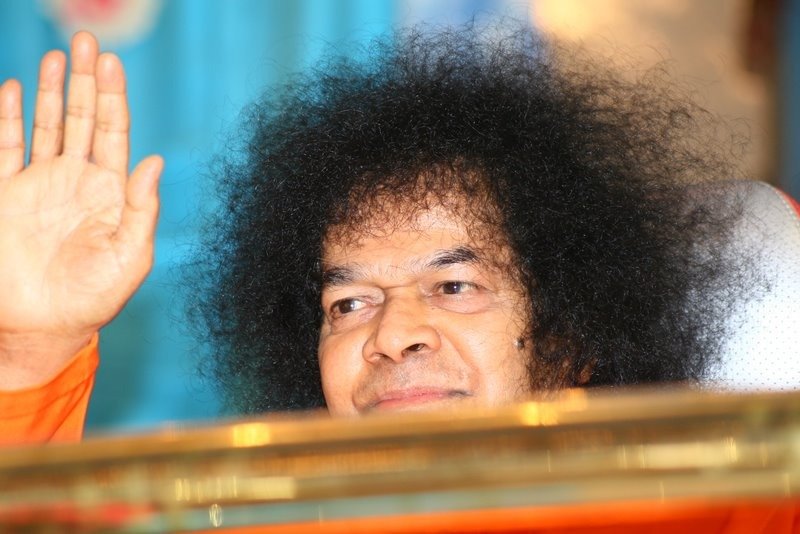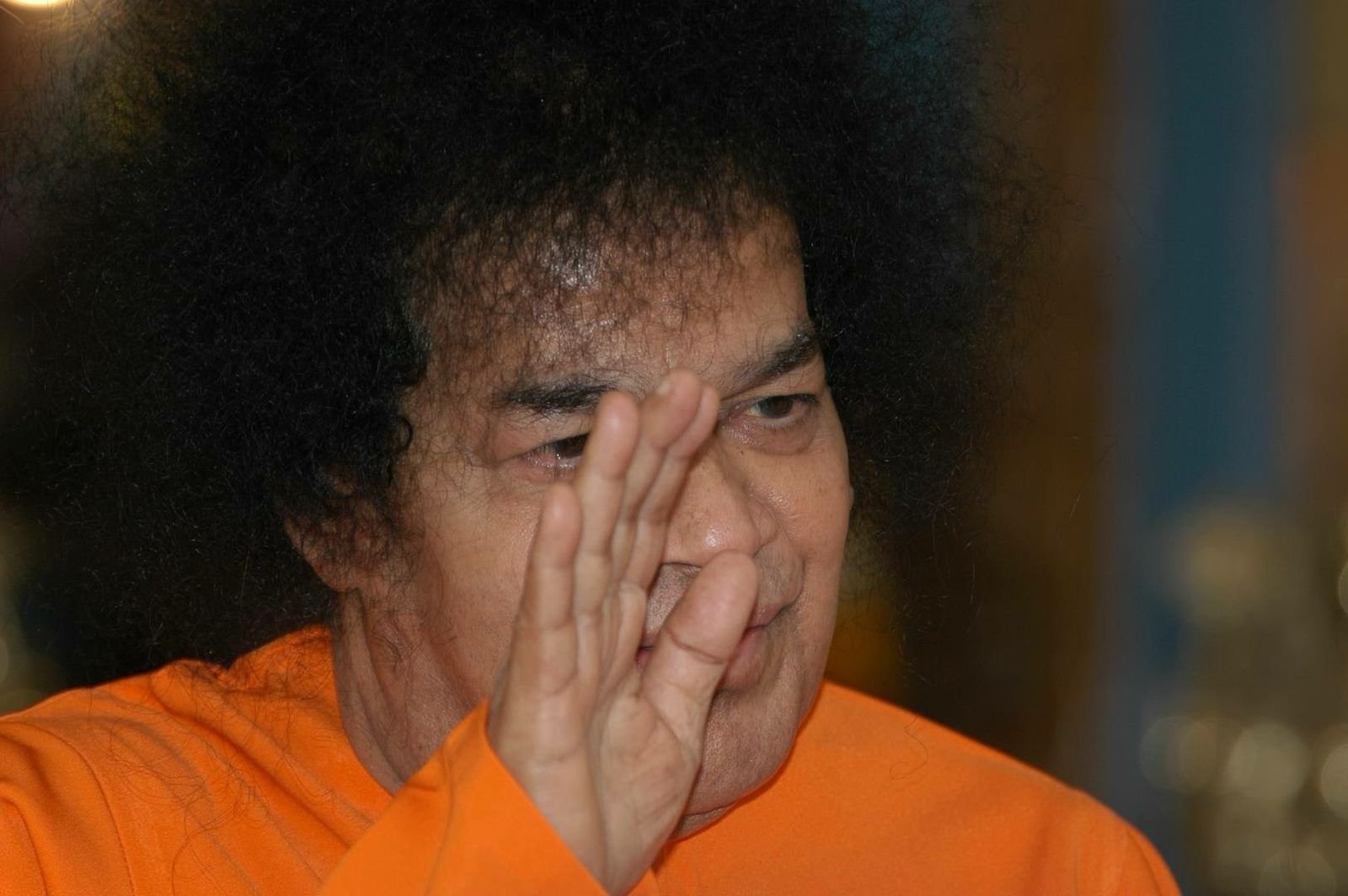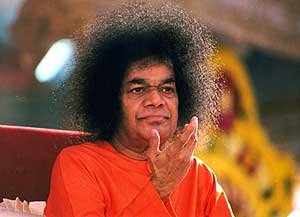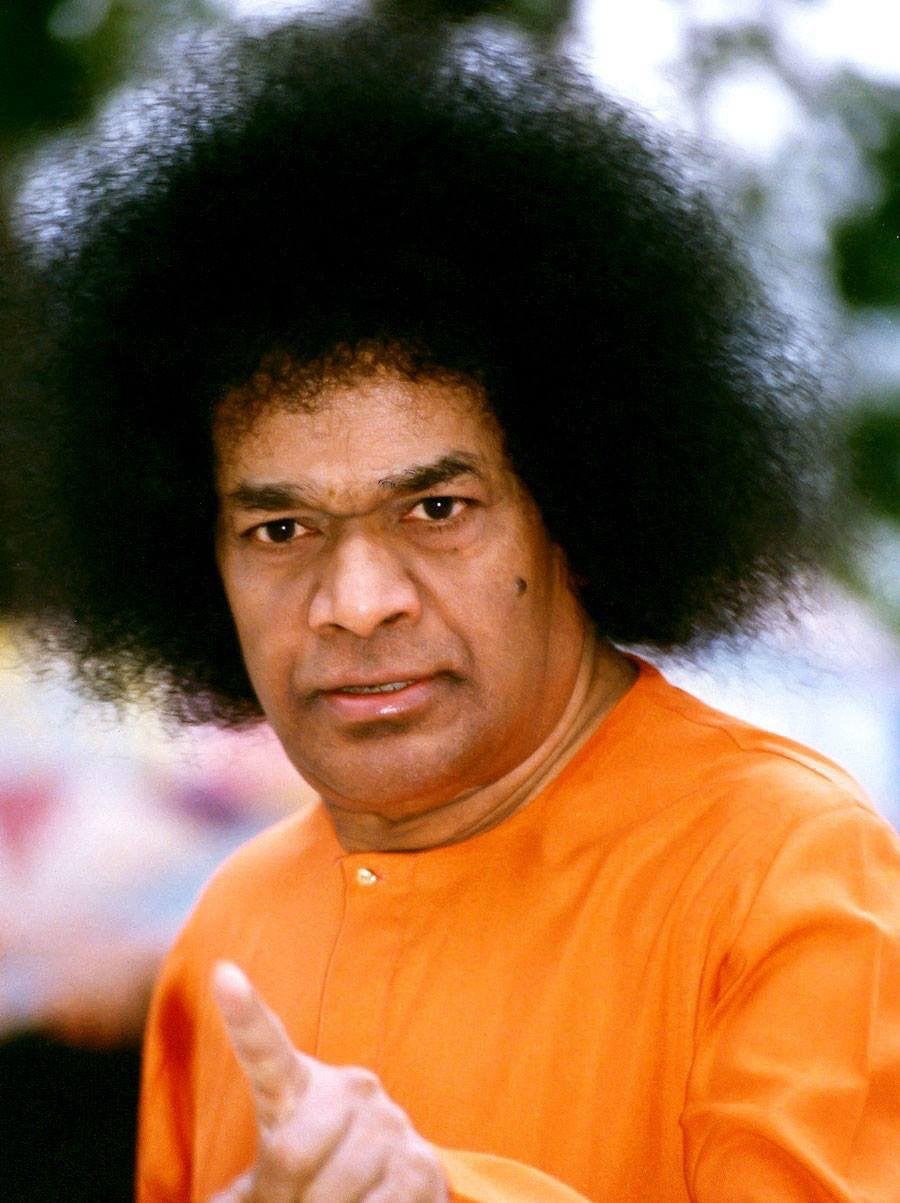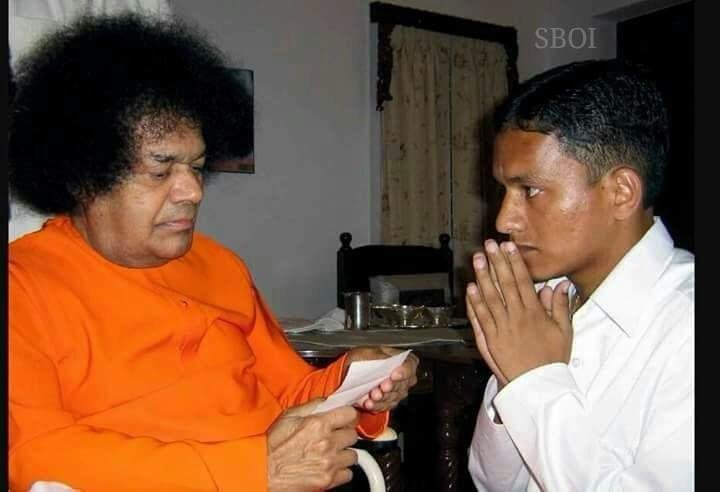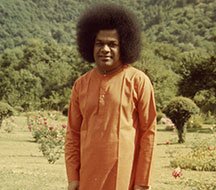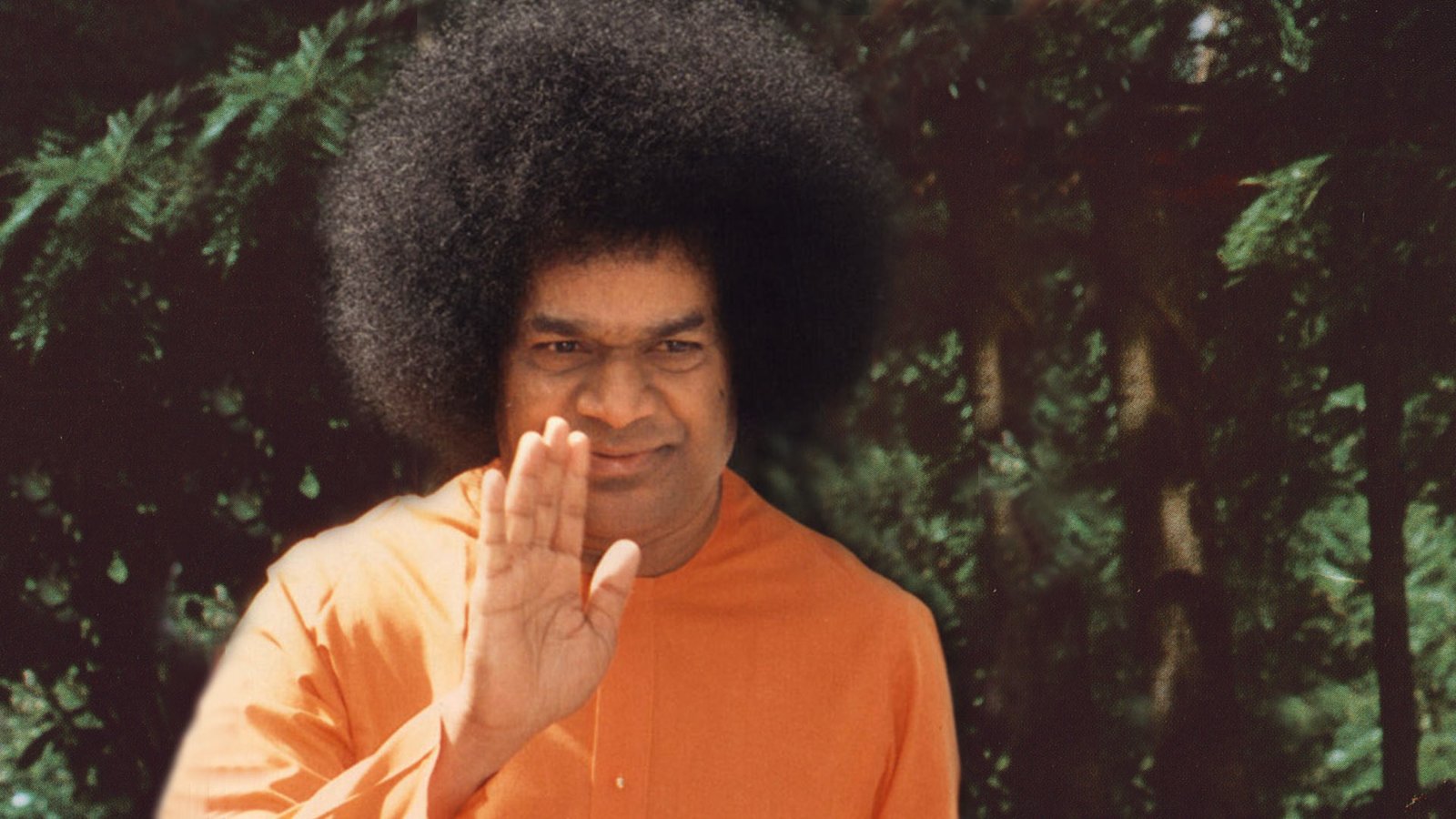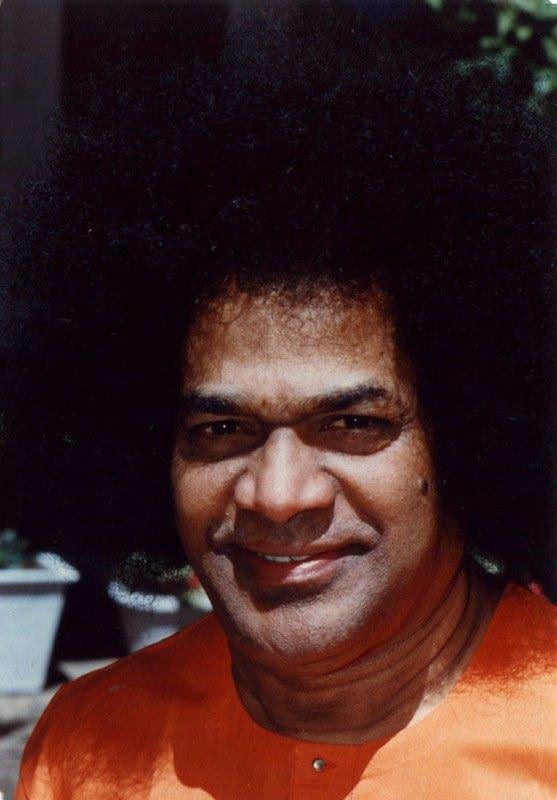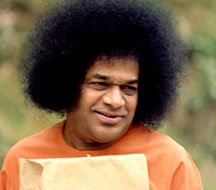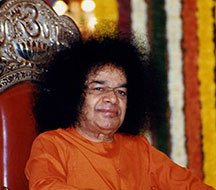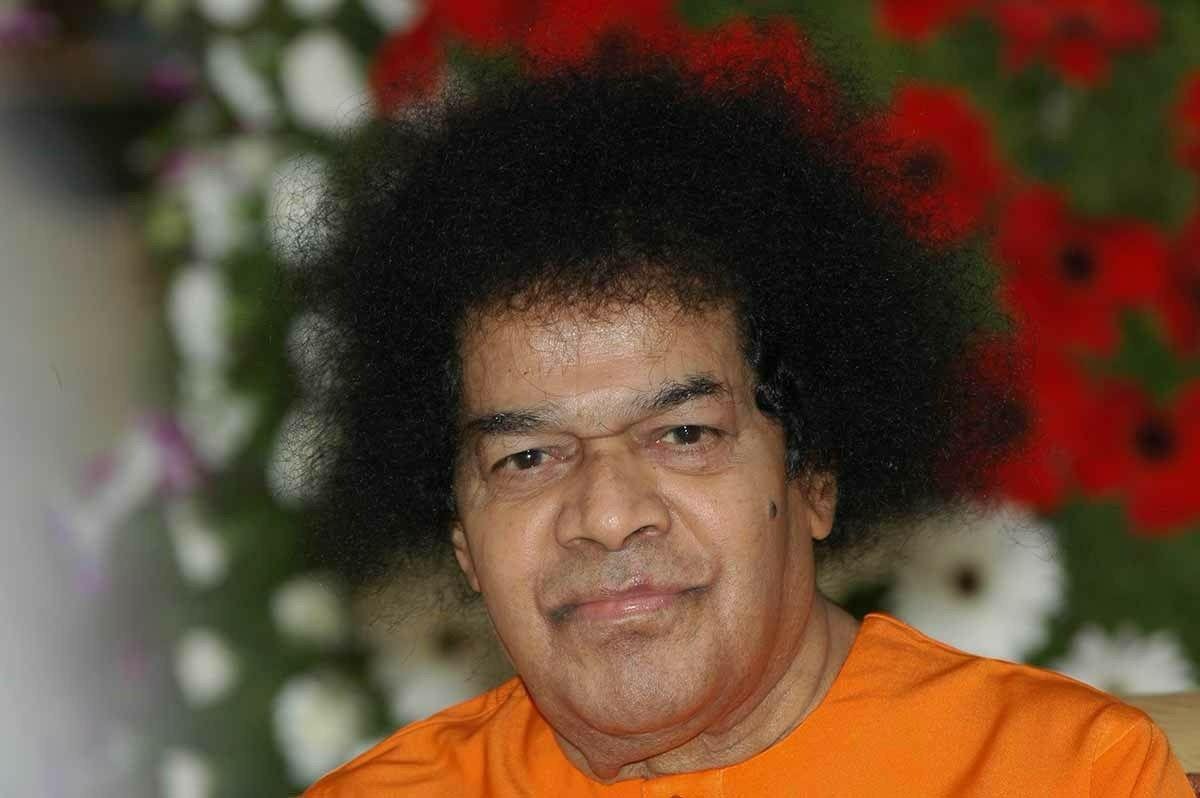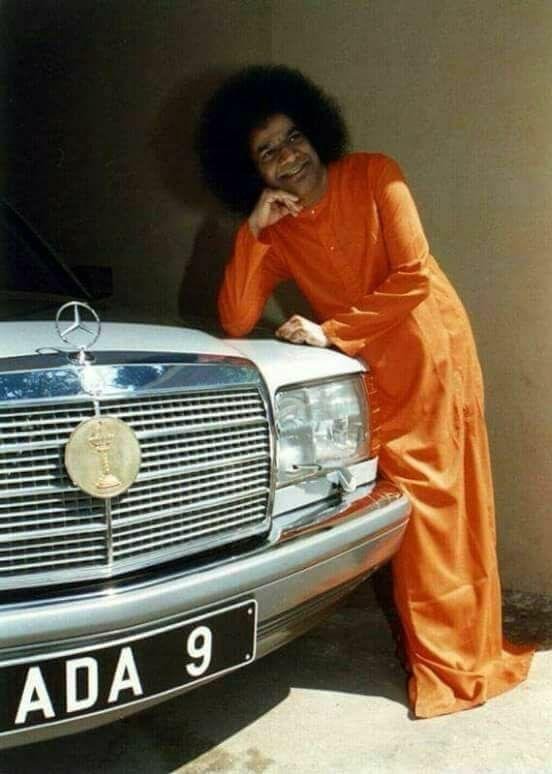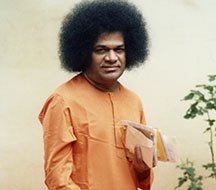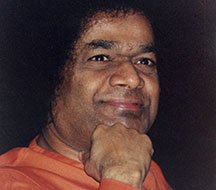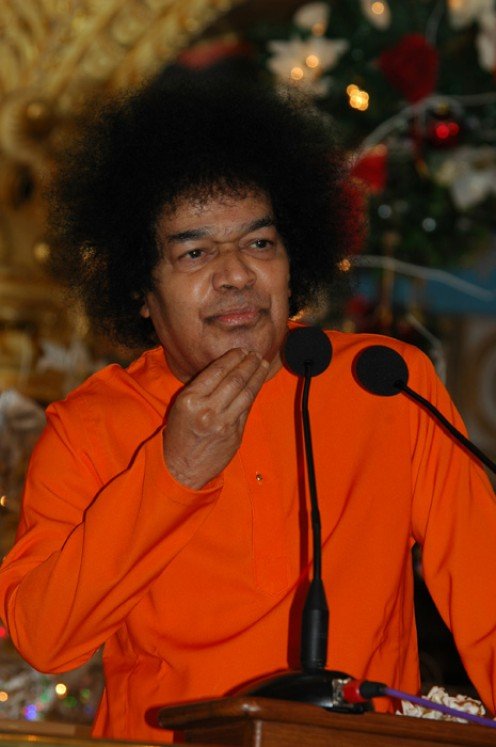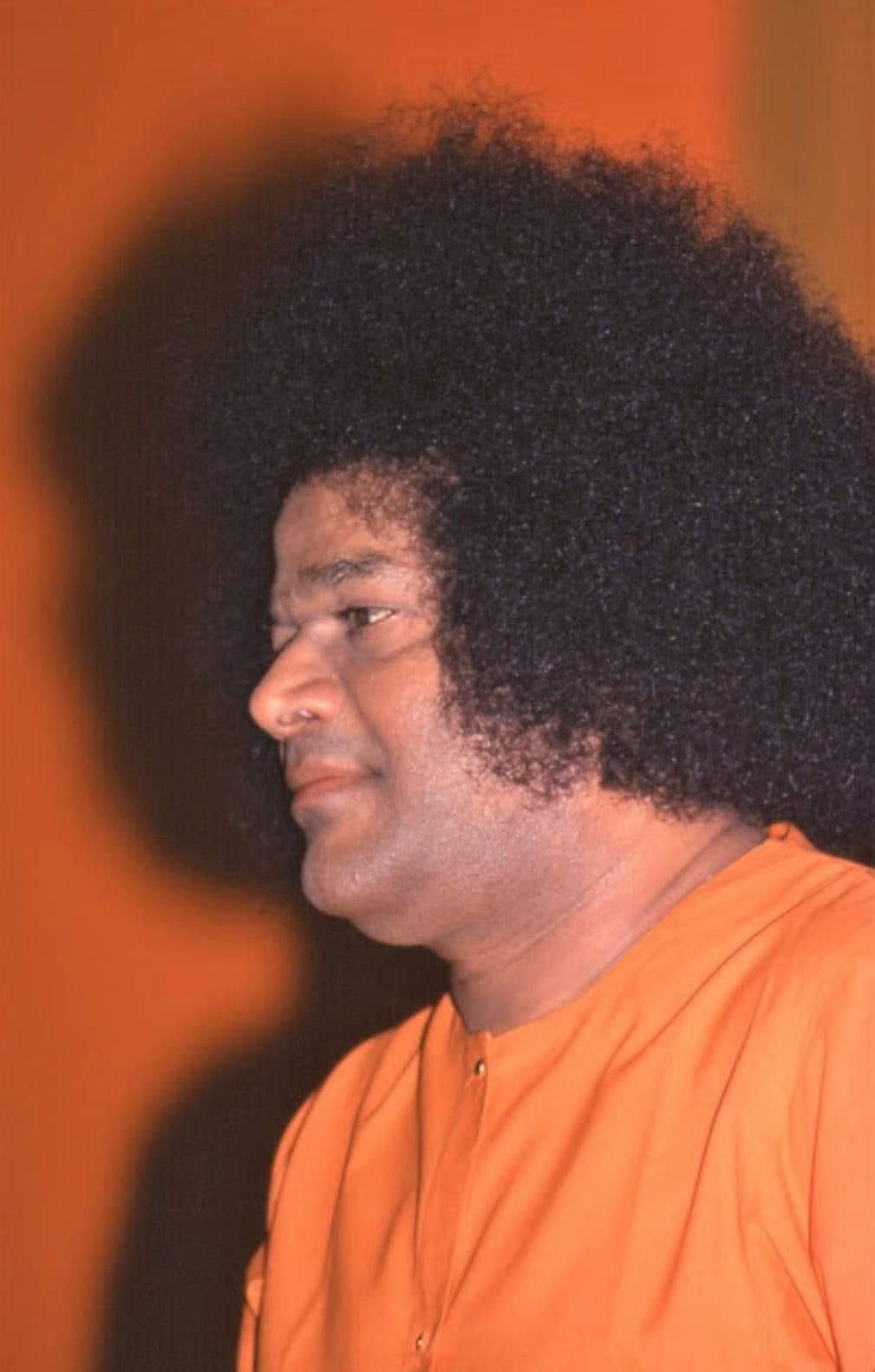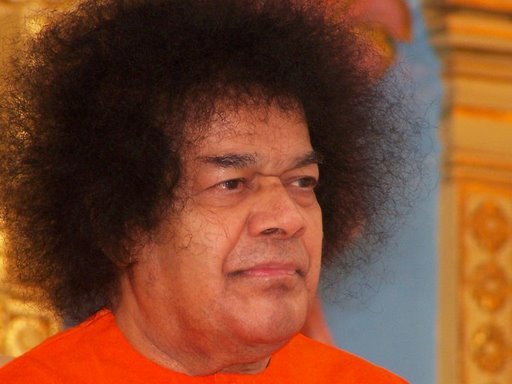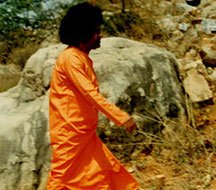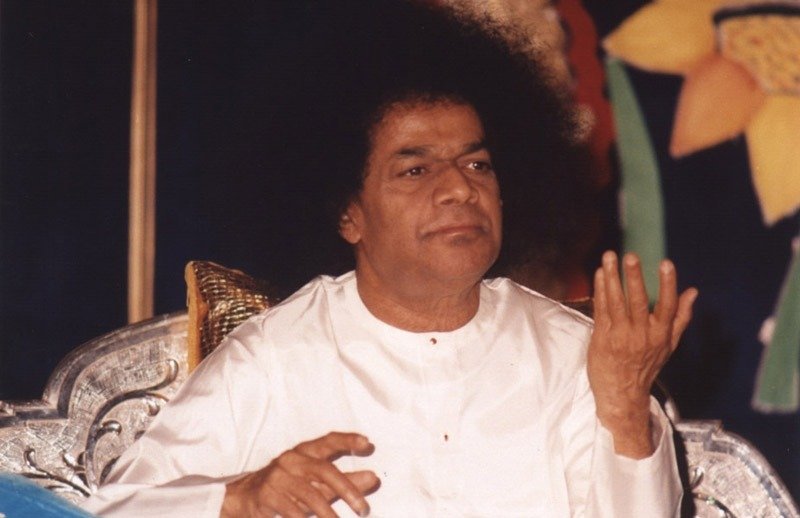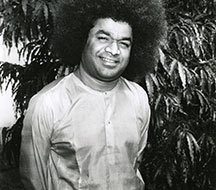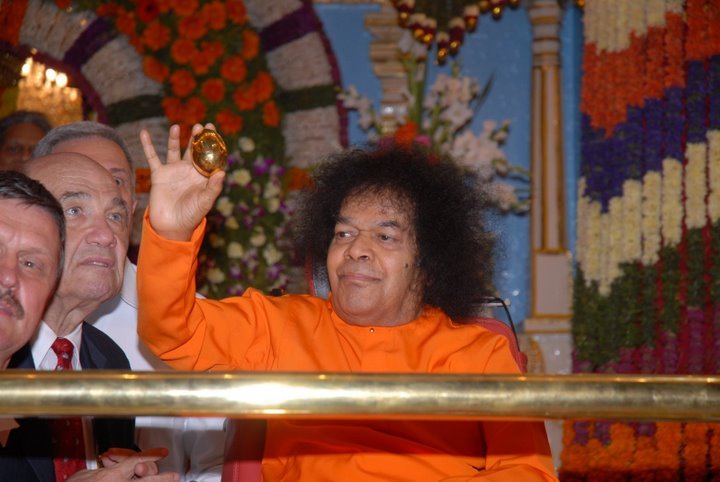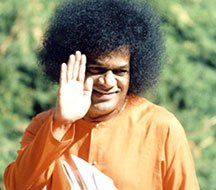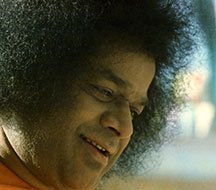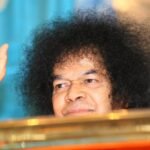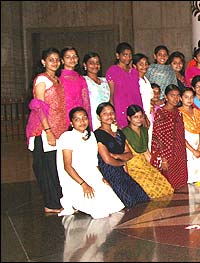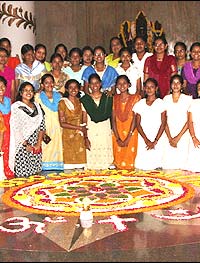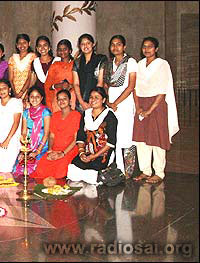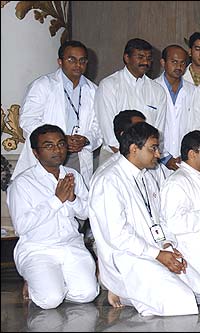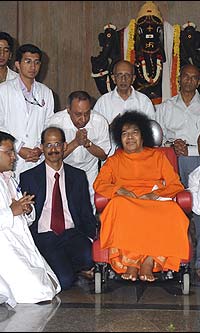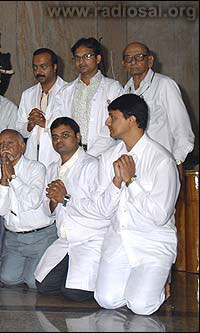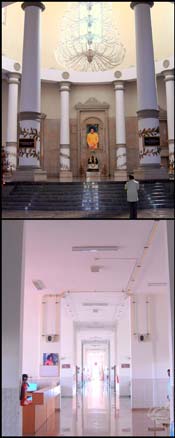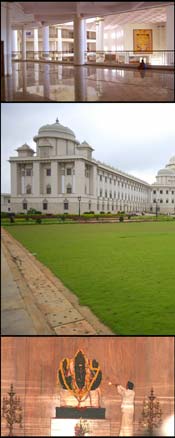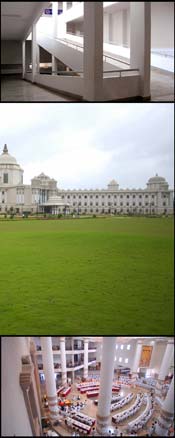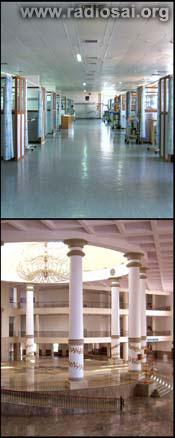Sri Satya Sai Baba Seva
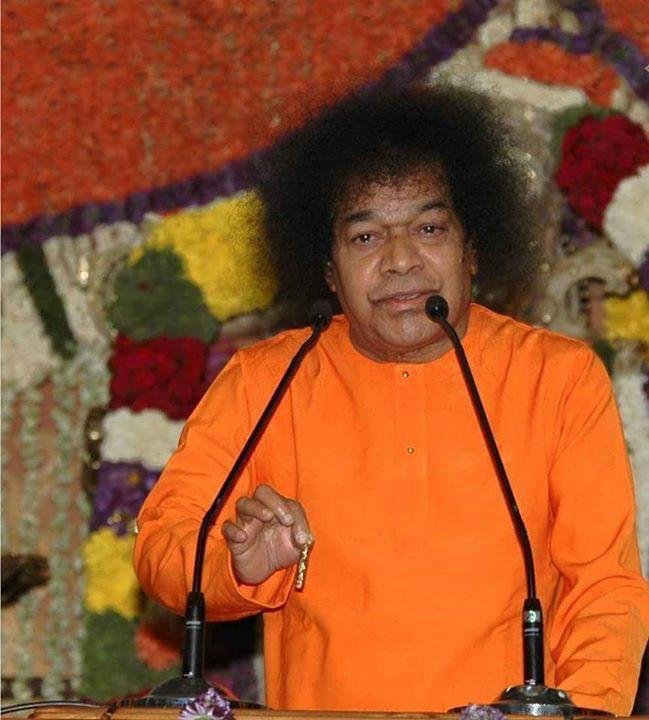
Sri Sathya Sai Baba placed immense importance on Seva (selfless service), describing it as the highest form of spiritual discipline. He taught that service to humanity is service to God, for divinity resides in every living being. Seva is not merely charity or giving material help; it is an act of love, compassion, and humility performed without expectation of reward. Baba often reminded devotees that “Hands that help are holier than lips that pray,” emphasizing that true spirituality is expressed in action that uplifts others.
Through His guidance, countless Seva activities were initiated worldwide—free medical care, free education, water supply projects, disaster relief programs, and village upliftment. His super-speciality hospitals provide advanced healthcare without charging a single rupee, His educational institutions focus on values-based learning, and His water projects brought drinking water to millions. These monumental works were not for fame or recognition but were inspired by the principle that selfless service purifies the heart and leads one closer to God.
Baba explained that Seva is also a means of ego-dissolution. When one serves with love, barriers of caste, creed, and religion disappear, and the realization dawns that all are children of the same Divine source. True Seva is done silently, with humility, as an offering to the Divine. It is not measured by the size of the act but by the purity of intention. Even a kind word, a smile, or helping hand done with love qualifies as Seva.
For devotees, Seva became the living practice of Sathya Sai Baba’s teachings—Love All, Serve All. It is through Seva that one transforms inner selfishness into selflessness, experiencing joy in the happiness of others. Baba’s life itself was the greatest example of service, as every moment was dedicated to alleviating suffering and guiding humanity towards love, unity, and spiritual awakening.
Sri Sathya Sai Baba often said that Seva is the highest expression of love in action. For Him, spirituality was not limited to meditation, rituals, or discourses; it had to be lived and demonstrated through the service of others. He declared, “The best way to love God is to love all and serve all.” In this way, Seva became the bridge between the devotee and the Divine.
Baba emphasized that Seva must be performed with selflessness and humility, not with pride or expectation. True service recognizes no distinction of religion, race, gender, or social status—it is done with the awareness that God dwells equally in all beings. Whether it was serving a poor villager, a sick patient, or a child in need of education, Baba taught that each act of service should be done as worship to God Himself.
Under His divine guidance, massive humanitarian projects were carried out across the world:
Healthcare: Establishment of the Sri Sathya Sai Super Speciality Hospitals, General Hospitals, and Mobile Hospitals offering world-class medical treatment totally free of cost.
Education: Sathya Sai educational institutions, from primary schools to universities, provided holistic, values-based education without charging tuition fees.
Water Projects: Large-scale drinking water supply initiatives, such as those in Anantapur, Medak, and Chennai, which transformed the lives of millions by addressing a basic human need.
Disaster Relief and Village Service: Volunteers from Sai organizations around the globe engaged in relief operations, village development programs, and feeding the hungry, embodying Baba’s principle of service.
For devotees, Seva is not just external work but also inner transformation. It purifies the mind, removes selfishness, and expands the heart with compassion. Baba taught that Seva done with love becomes a form of spiritual practice, leading one to experience the unity of all creation. In this sense, Seva is both a means and an end—a practice that elevates the doer and a goal that reflects the nature of God, who is ever-compassionate and ever-giving.
Today, Sathya Sai devotees across more than 120 countries continue His legacy through Sai Seva Organizations, which conduct service activities in health, education, environment, and community upliftment. This worldwide movement of service reflects Baba’s message that love expressed through Seva is the most powerful force for personal and global transformation.
A birthday gift from Anantapur
To commemorate the 78th Birthday of our Beloved Lord, Bhagawan Sri Sathya Sai Baba, the teachers and students of the Sri Sathya Sai Institute of Higher Learning, Anantapur Campus, organised a social service project in which 78 physically challenged persons were selected from various villages in the mandals of Anantapur District such as Anantapur, Dharmavaram, Hindupur, Pamidi, Kothacheruvu, Madakasira, Kadiri, and Bommanahal, to be the recipients of tricycles, crutches, callipers, artificial limbs, wheel chairs, walking sticks, etc.
With the permission of Bhagawan, the beneficiaries were called to Prashanti Nilayam where they had the good fortune of receiving these different props from the Divine Hands of Beloved Bhagawan Himself.
As 12th November, 2003, (the date fixed by Bhagawan for the distribution ceremony) happened to be Bhagawan’s Birthday according to the Indian Calender (Bahula Tadiya Karthika Maasam), the function at the Sai Kulwant Hall began with Bhagawan lighting the Lamp, and then cutting the Birthday Cake. Beloved Bhagawan, the Compassionate Lord, blessed each and every patient. It was a moving sight as each one of them came forward, assisted by one of the teachers, and received a pair of new clothes from the Divine Hands of Bhagawan.
After the formalities were completed, Bhagawan graciously sat for a time and listened to some songs sung by the girls of the Anantapur Campus.
Throughout the function, Bhagawan’s Love seemed to flow to the handicapped patients. He called Prof. Jayalakshmi Gopinath, Warden and Head of the Dept. of English, and asked her to speak to them. When she started to speak in English, Bhagawan turned towards her, and said that she should speak in Telugu so that they would understand what she spoke. Prof. Gopinath reminded the beneficiaries of their great good fortune in being the recipients of Divine Grace, and advised them not to disregard the value of what they had received.
To the surprise and delight of all the people gathered in the hall, Bhagawan expressed a desire to speak, too! Bhagawan spoke for nearly twenty minutes, without any translation! Bhagawan’s loving and soothing words to the handicapped were like balm to a depressed heart. They brought tears to the eyes of all who were present there. Bhagawan comforted the patients by saying that they should not feel unhappy because they are deprived of the full and proper use of their limbs. Those who have all their limbs intact do not use their body for the good of others, nor for the service of others, Bhagawan said. He exhorted the handicapped patients to develop confidence, and to work with such commitment that they put to shame the full-bodied. Bhagawan promised them every possible help, and asked them not to hesitate in expressing any of their problems to Him. Bhagawan said that if any of them were interested in further studies, He would provide them admission in one of His institutions. He asked them to give courage to their depressed parents who were already grieved that they had children with handicaps. Bhagawan advised the Anantapur teachers not to leave the good work they were doing at this point, but to follow up on the steps they had already taken. He asked them to keep in touch with the beneficiaries and see to it that any repairs to the equipment or any help that was needed was given to the needy from time to time. Bhagawan said that it is the duty of the educated to serve the society, and not lead selfish lives. Bhagawan graciously promised Rs. 10 lakhs for this service project.
After the mangal arati, Bhagawan announced that all the patients should go to the Canteen and, after a sumptuous meal, happily return to their hometowns. He once again blessed everyone with abhayahasta.
A love story revealed...
A LOVE STORY REVEALED ……
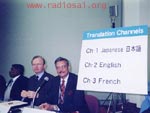 This panel discussion was held in Kyoto, and I went there on account of an invitation sent to me by the UN HABITAT. The Panel Discussion was being jointly organised by UN HABITAT and the Asian Development Bank or ADB. They wanted me to discuss the financial aspects of the Sri Sathya Sai Anantapur Water Project. After a lot of hesitation I finally decided to accept the invitation.
This panel discussion was held in Kyoto, and I went there on account of an invitation sent to me by the UN HABITAT. The Panel Discussion was being jointly organised by UN HABITAT and the Asian Development Bank or ADB. They wanted me to discuss the financial aspects of the Sri Sathya Sai Anantapur Water Project. After a lot of hesitation I finally decided to accept the invitation.
Initially I hesitated because after all, the basic strength of Anantapur water project is not financing aspect. I felt that to basically talk about only the financing of the water project was a mistake. However, there was an invitation, and I went there eventually but with a lot of trepidation.
On the first day, there was a beautiful musical ballet presentation as a part of the inaugural ceremonies. The ballet was all about water as a source coming through time and through space. The ballet was presented by the children from the Sai School in Japan. During the ballet, there were references to Truth, Peace, Right Conduct, Non violence. My ears immediately pricked up. When the ballet was over, the 1500 delegates present gave a standing ovation. I basically felt right then that may be Swami’s presence is already here. This made me resolve that I should make my presentation to the panel fairly forcefully.
The panel presentation was on the next day. I was the fourth speaker in a panel of six speakers. Most of those who spoke before me, talked about Financing Models, Pay-back methods, Cost of Recovery, etc. I had prepared a Power Point presentation but after seeing the children’s ballet I realised there was no point in making this presentation because financing was not the important part of Sri Sathya Sai Water Project. So in the last minute I decided not to do my Power Point presentation. Instead I began by saying that I am no expert on water, in fact, I don’t even know why I am here. Therefore I am not going to make a presentation on financing to you; instead what I am going to offer you is a case study. It is not merely a case study, it is also a Love Story. It is not only a story of Love but also one of Compassion. It is the story of how one compassionate individual found it necessary to bring water to a parched land and quench the thirst of over a million people. That is what my story of Compassion and Love is all about. The moment I said that there was immediately a lot of attention and after that my presentation went on very well. Subsequently, there was a lot of interest concerning what the project was about, and what Swami was saying.
The press was immediately after me and wanted to know many things like what was this project about? Who is Sathya Sai Baba? And so on. There was also an invitation from the Osaka Students Union asking me to come and talk to them about the water project. Not merely that. A Minister from China and the whole delegation from China wanted to hear my presentation. The Minister wanted to discuss with me about this compassion that I was talking about, and about the whole project. In short, Swami’s Love Story was a real hit!
Amazing Transformation and Divine Miracle
Ten kilometers away from Ooty, in Tamil Nadu, India, is the village of Melakavatti, which lies on the road between Ooty and Nanjanadu. Surrounding this valley are cloud-capped, mist-laden hills that offer a panoramic view of Nature’s emerald greenery at its best.
The slopes of the hills are thickly wooded and the shifting mist seems to play hide and seek upon them. 300 families live in this verdant village.
The Sri Sathya Sai Seva Organisations of Nilgiris selected this village for their three-year Seva activities prior to Bhagavan’s 80th Birthday.
They could not have realised that it was the Divine Hand that had pointed out this village, since a Leela was to be played out there.
A Paralysed Lady Blighted and Uncared For …
In was in January 2003, at the inauguration of the Seva activities in the village, that the members of the Ooty Samithi conducted a Nagarsangeerthan one early morning.
After the Nagarsangeerthan they visited each and every house and gave out Swami’s picture, a laddu and vibhuthi as prasad. At the end of a lane they entered an ancient, dilapidated house for handing out prasad. What they saw shook them to the very core of their being. On the damp floor was lying a lady well past her prime on a sacking cloth. Wherever they turned, their eyes met only signs of abject poverty and neglect. Some villagers who had come along with them explained the pitiful condition of that lady.
She was extremely poor and had been orphaned at a very early age. The little plot of land that she inherited was the source of a meager income that kept her body and soul together.
Having no near and dear relatives to arrange her marriage, she remained a spinster. When she was 30, suddenly, she lost the use of both arms and legs.
The Divine Sai Seva Begins….
The District President and other members of the Organisation, who heard these pathetic details, were deeply touched. That second itself they resolved to adopt her and take care of her. Immediately, a cot, a mattress and blankets were bought and she was transferred from the cold sacking cloth on the floor.
They planned that every day one member would bring food and stay with her the entire day and take care of her. That was how the Divine Seva began.
The Villagers’ Hearts Awaken…
As months rolled by, the collective conscience of the village woke up. They felt ashamed that in the name of Sri Sathya Sai Baba, volunteers were coming from distant Ooty to take care of the elderly, paralysed lady who had always lived in their midst, totally neglected by them.
They felt that it was their bounden duty to take care of the lady. Slowly, their minds and hearts changed and kindness and compassion crept into their hearts. As a result, the village panchayat (head committee) was convened.
Each one commented appreciating the continuous Seva that had been going on, rain or shine. The Ooty Samithi members had never failed in the Sai Seva they had taken up even though they had to travel 20 kms to and fro from Ooty. The villagers resolved that henceforth they would take over the care of their neighbour whom they had forsaken till then.
Thirty people came forward to care for her. All the days of the month were thus covered and the specific date for each family was written on a paper and kept near Bhagavan’s picture in their Pooja room as an offering at the Feet of the Lord Sai.
The service continued and the Samithi members continued to associate themselves and assist when need arose. The eagerness to serve spread and soon everyone in the village wanted to do something!
The Seva Ideal Spreads…
They began to renovate her house, cementing the floor, painting the walls and repairing the roof. It gained a new look and shone because of the love and service gushing from generous hearts. They began cooking her food in the renovated kitchen and thus she was able to eat hot food, a very welcome change for her in Ooty’s cold climate.
A healthy competition began between the villagers so that each month lots had to be drawn to assign 30 families for performing Seva to the paralysed lady. All the important activities of the village began to be held in her house only. It had become a symbol of their unity and purity of hearts and the readiness to serve that sprang from that purity.
The dark, dismal house had become transformed into a shining center for all activities in Melakavatti. The village that was earlier divided by selfishness, clashes of ego and disinterestedness, came together bound by love of service to the long-neglected lady. Thus, started the link that bound them together into Unity, which spread Purity among them. Can Divinity be far behind?
The Lady’s House…the Centre of the Village
In September 2004, the Samithis in the Nilgiris District planned to hold bhajans in 80 villages. The turn of Melakavatti came along and all the people in one voice opined that the bhajan should take place in that lady’s house, which had become the focal point of all their activities. Accordingly, a well decorated shamiana (temporary shed) was erected in front of the house and bhajans started in the evening. All the villagers participated with great enthusiasm and devotional fervour. The bhajan singers from Ooty were totally immersed in singing the praise of the Lord who had brought the village together.
The Unexpected Divine Miracle!
At that golden moment something momentous, something miraculous, something totally unexpected, began to happen. That 50 year old lady who had no sensation in her hands and legs and had been confined to her bed for the past 20 years, suddenly, without the help of anybody or without anyone being conscious of it, raised herself up to sit on the bed. Slowly, she put her feet down and stood up! She moved her hands as well. She moved towards the place where bhajans were being sung in front of Bhagavan’s picture.
The whole village was immersed in the bhajans and did not know of the miracle that was taking place inside the house. All at once, they saw her coming to the front of the house unaided and raising her hands in homage to the visible Lord and beginning to dance in ecstasy. The bhajan singers, Samithi members and the villagers were all struck with wonder seeing that lady dancing before their eyes and this must have flashed on their minds “Sai Bhagavan! How is it possible for this lady who had remained paralysed for 20 years to dance to the rhythm of the bhajans except by Your Grace? You are indeed present here and have taken over the entire village and working miracles. The total transformation of this village has been due to Your boundless Grace, mercy and compassion.”
The lady explained to the amazed gathering that Swami had appeared in her dream the previous night and had massaged her hands and legs thus removing her paralysis.
The Amazing Transformation in the Village
Today, the 300 families are closely knit into one Sai family. Unity led to Purity that has expanded into Divinity.The village chief who was shocked by what he saw resolved then and there that he would never touch another bottle of liquor in that pure village where God was present. He had been a confirmed alcoholic throughout his entire life!
Lo and behold! The paralysed walks!
The addict renounces liquor at a moment’s notice!
Unity prevails in a divided village and their pure hearts are temples where Bhagavan is enthroned!
What other proof does one need to recognize the presence of the All Compassionate Lord?
A little footnote to the above is that the name of the lady is Subbi short for Subbamma!
A look at that shining lady’s face and visit to her is enough for her neighbours to come back lit with joy and peace.
Where the Lord has taken residence is surely a place filled with Ananda and peace everlasting.
Andaman
Window to Sai Seva
Wonder how many people know where Andaman islands are? During the British rule of India, they established a fearsome prison for detaining the most difficult freedom fighters. Many were even executed. During world war II, the Japanese bombed the islands many times. Now, all that is dim memory. There is a fresh fragrance of shanthi. Reason for the change? See the pictures below…




A project by Devotees in Kenia - E. Africa
‘Members of Sathya Sai Organisations must tour every village and improve the lot of the rural folk. This is a new challenge for the members of the organisation……I shall visit every village along with you, serve them without any discrimination of caste, creed, race and class. I wish that Sathya Sai Organisations should, from this day onwards, undertake programmes of rural uplift, go to each village and provide educational and medical facilities. Meditation and penance are useful to ones own self only but the good of world at large is achieved through sacrifice’ – Sri Sathya Sai Baba
In keeping with our Beloved Swami’s teaching, the devotees in Kenya rallied around to come up with a project to save the people of Kenya from malaria in the 80th Year of the Advent of Bhagavan Sri Satya Sai Baba. The SAINET project readily agreed to provide two SAINETs (Insecticide treated Mosquito Nets in distinctive ochre shade, branded as SAINET with the message of Baba: Love All Serve All – inscribed on the nets) to each family. Each net costs about 3 dollars and the devotees, by practicing ceiling on desire at individual and family levels in daily life, contributed and continue to contribute towards this grand project. The SAINET project is the first national community project undertaken by the Sri Sathya Sai National Trust – Kenya, as humble tribute at the Divine Lotus Feet on the momentous occasion of the 80th year of the Advent of the Poornavatar of this age. Additionally, as a token of love from the Sai family, each household to receive 4 kg. of Maize meal along with the nets.
The first village selected called Nabingenge (literally meaning ‘the Mosquito Village’) and adjoining villages located in the marshlands of Trans Nzoia district of Kenya were selected. Burial of children dying from malaria (a village lost upto 3 children in a month during the rainy season) had become a common practice in and around these small villages in Western Kenya. On the 11th of June, 2005, the first seva was carried out by the Sai Sevaks and Sevikas with help from teachers from local University and Sai schools. The battle of Namanjalala was won and 2,200 households, home to some 16,800 population spread over 20 villages were freed from the menace of mosquitoes. Children, women and men were assured that SAINETs will give them protection from the suffering and death from malaria – a menace that has been part of their lives as long as they can remember.
In on the of the makeshift huts in the village, a young woman and her four little malnourished children worn our by malaria, for whom daily survival is the main purpose of life, with a meager daily wage of less than 1 dollar which lasts for only 3 to 4 months a year. For the rest of the year, they can only look up to God. Much of their income goes to buying medicines for malaria which seems to be their life-long companion. Mosquito nets? It is a luxury they cannot think of.
On the 15th of July, 2005, the second seva was carried out in Malindi, along the coast of Kenya. Three villages were selected – a total of 10,000 SAINETS to some 5,000 households with 43,000 populations spread over the remote villages were distributed. Additionally, as token of love from the Sai family, each household was given 4 kg of maize meal, salt and cooking fat.
The third seva will be undertaken on the 26th of August, 2005, and the devotees in Kenya are determined to forge ahead with distributing as many SAINETs as possible. In Kisumu we are planning to conduct service to an estimated population of 37,000 people.
To-date, we have completed two successive services to Kitale (population covered about 16,200) and Malindi (38,000) and succeeded in reaching out to thousands of villagers with Swami’s self-less love.
Our respected International Chairman of Prashanti Council, Brother Michael Goldstein and the Head of the International Medical Committee, Dr. Narendra Reddy, have informed us that on the Sunday, 23rd July, 2005, Swami blessed the SAINET project when it was presented for His approval. Swami was very happy with the project and said ‘May the good work continue’ and showered His Blessings. Dr. Goldstein has also requested that the SAINET project be presented at the International Medical Conference to be held in Prashanti Nilayam on the 3-4th September 2005. Also SAINET services will now be disseminated thru the Sanathan Sarathi publication, and, the SAINET project information has also been forwarded by the International Medical Committee to the Swiss Medical Journal for dissemination.
‘Spread joy at all time. Carry a smile on your face so that everyone who sees you can catch that exhilaration. When you tell others your success, your purpose is to create envy in them. You must not only love others, but you must be so good that others too may love you. Try to console, encourage, strengthen and enlighten those who are miserable, downhearted, weak or ill-informed. Get yourself ready for this role.’ – Sri Sathya Sai Baba
Thanking you all for taking time to read what we have been doing in Kenya.
May Swami Bless us all.
Manju
Are You a Doctor?
Dear reader, in this ‘Window to Sai Seva’ section, in every issue we bring you inspiring stories of service done by seva teams from all over India and the world. However, in this issue, we have something different. It is not so much on service but on an instrument of Swami who has been selflessly offering his time and energy for the poor and needy. What drives an eye surgeon from the USA to travel thousands of miles every year to spend three weeks serving in Swami’s Super Specialty Hospital in Puttaparthi? How different is the experience? Here is a persoanl account from a person to whom hundreds owe their eyesight.
In 2001, during one of his visits to Prasanthi Nilayam, Dr. Sanjeev Dewan, an eye surgeon based in Canton, Ohio, USA, was sitting on the veranda in front the Bhajan Hall, eagerly waiting for Swami’s darshan. “Baba walked into the veranda and as He passed, He glanced at me and said, ‘Are you a doctor? You are a patient'”, Dr. Dewan said. “I knew the significance of Swami’s words. I nodded and said, ‘Yes, Swami, I am the patient and you are fixing my illness.’”
Dr. Dewan, a 40-year-old visiting eye surgeon at the Sri Sathya Sai Institute of Higher Medical Sciences (SSSIHMS), Prashantigram, feels that since he came to Swami’s fold, the transformation that Swami had desired has been taking place in countless ways. Every year, Dr. Dewan takes a break from his busy practice back in the U.S. and heads to SSSIHMS for three weeks, where he treats the patients – and himself gets ‘cured’.
The Qualifications of a True Doctor
“I am not a complete doctor. A doctor has to be wholly desireless, selfless and compassionate. The transformation is taking place in many ways,” he smiles. A disarming smile, which has the warmth to put even the most edgy among the patients, at ease. Apart from his smile, what patients notice as soon as they enter his room at the Hospital is a cheerful man in a lilac blue apron, with Ohio Eye Alliance embroidered on the left side. Dr. Dewan’s parents had migrated from Pakistan to India during the partition. The family later got settled in the U.S. in 1956.
It is a delightful story how Swami brought Dr. Dewan into His fold. As he tries to remember his first encounter with Bhagavan, one can see his sharp brown eyes getting wistful as he searches his memory. His head falls back and he looks remotely at the white wall facing him in his room.
“I am not all that good with the details”, he says breaking the silence. He, however, remembers the picture of a ‘man’ his wife had placed at the location of their marriage ceremony, which took place in Buffalo, New York in 1992. “During our wedding, Seema had kept the photograph of Sai Baba at the place where the wedding ceremony was to take place,” he says. “’Who is this man?’ I had asked. ‘My Guru,’ was her answer.”
Mrs. Dewan has been an ardent follower of Baba since she was seven years old. She has visited Puttaparthi on several occasions and also authored several books on Swami, the first one being, “Sai Darshan”.
“I did not have any reservations about having the photograph of Sai Baba at my wedding, but somehow was not impressed with the ‘man'” says Dr. Dewan and continues, “It was several years after our marriage that one day my wife said, ‘let us go to India and visit Puttaparthi’. I somehow felt like accompanying her. But I told her, ‘we will stay only for a day at the ashram as we have other engagements’.”
It was in 1995 that Dr. Dewan visited Prasanthi Nilayam for the first time. “We got down at the Puttaparthi airport, after taking a connecting flight from Bangalore. It was as if some invisible hand was taking care of all our concerns. As soon as we descended from the aircraft, a person volunteered to guide us to the ashram. We hesitated, but he took us along and made adequate arrangements for our stay. Only after we felt comfortable inside the ashram, he left,” Dr. Dewan recollects. He told us that he worked with the Indian Airlines. That was all we could gather about him, Dr. Dewan adds.
The Numinous Attraction of Divine Love
When it was Bhagavan’s darshan time, the family quickly reached the hall. “I sat far away from Swami, somewhere in the multitude of devotees. As I saw Swami walking among the devotees, I felt drawn to Him. Something overcame me. I wanted to be close to Him. ‘Why cannot I be close to him?’, ‘Why this distance?’, I kept asking myself. That night I was almost in tears,” Dr. Dewan confesses. “Then I told my Seema, ‘all right, we will stay for two days more!’” Now, Dr. Dewan chuckles.
The next day Dr. Dewan visited Bhagavan’s birthplace, where now stands a Shiva Temple and lies at one end of bustling Puttaparthi town. “During our visit Mr. Bhatt was the temple priest. He took us with him to his home and started narrating stories of Baba, I could not be satiated. Acknowledging my interest, Mr. Bhatt went from one story to another. Yet I wanted to hear more.” Soon Dr. Dewan was visiting Prasanthi Nilayam along with his family of five every year.
The Gift of True Vision
In innumerable ways, Bhagavan helped the Dewan family in their difficult times. One of the doctor’s three sons, 12-year-old Karan, was suffering from isotropia in one eye, which is an in-turning of the eye which makes a person cross-eyed. Due to his condition, Karan used to wear glasses.
Dr. Dewan says that during an interview granted to his family in the year 2000, Swami looked at his 12-year-old bespectacled son and told him: “Boy’s eyes are weak”, He then paused and added, “Glasses will go”. It is sometimes difficult to understand what Bhagavan means. But soon enough, Dr. Dewan was to witness the manifestation of Swami’s infinite grace.
“We went back to the U.S. and one day Karan came to me and said, ‘Dad, I see everything blurred when I wear glasses, but when I don’t, everything looks perfectly clear’. I thought he was joking. I specialise in paediatric ophthalmology, so I took Karan to my clinic and tested his eyes. His eyes were perfect. They had healed!” Dr. Dewan says, his eyes aglow with happiness reminiscesing this amazing miracle. “As Swami said, the glasses went,” he adds, jubilantly.
Working in the Temple of Healing
“I always feel that we are just instruments in His hands. I have experienced so many wonderful things here. The first time I came to the Hospital I was awestruck, as it looked more like a temple than a Hospital”, he says.
On his first visit, a large number of people with specific eye disorders, whose treatment was Dr. Dewan’s expertise, suddenly arrived at the Hospital. “This is Swami’s grace. And this happens on every occasion any visiting physician arrives at the Hospital.
People may think it might be because the message spreads through word of mouth. But on many occasions the visiting physician might be visiting the Hospital for the first time. This has happened too many times for it to be just a coincidence.”
“Also when I come here, my efficiency suddenly increases. I am able to treat more people here than what I do back home in the U.S.. When I return my efficiency drops,” Dr. Dewan chuckles. “I believe it is Baba’s grace!”
He adds that on several occasions he had come across cases which he had never seen during his practice in the U.S. “Working here also helps me to gain new insights into several rare cases. I take back the experience with me to America”, he adds.
According to Dr. Dewan, in India he finds more cases of nerve palsy than back in the U.S.. He explains that there are three nerves which control the movement of the eye, and nerve palsy leads to abnormal movement of eyes. “Many cases coming to the Hospital are of such kind,” he explains.
Dr. Dewan had also yearned to teach, which he is able to do now during his present visit to the SSSIHMS. “I wanted to teach and now Swami has fulfilled my desire”, he says with a smile. “Teaching helps a doctor to remain abreast with the latest developments in the field of medicine. I have to answer questions, which are put to me by the resident doctors, so I have to strive harder to learn and then teach the same. This process helps me to be a better physician myself.”
An Aspiration for Peace
Speaking about the transformation which has come about in him, Dr. Dewan says that his experiences with Bhagavan have helped him to re-align the goal of his life. The goal has now changed to peace and unity. “I have a yearning to speak less and accept more – and to serve without desire.”
“It is difficult to explain to my colleagues where I go off to every year for three weeks. They think I am taking off to some beach,” he chuckles. “They find it hard to imagine that I am taking off to volunteer in a Hospital, which lies in a remote corner of India and treats patients free of cost,” he adds.
Dr. Dewan says he tries to explain to his colleagues that it is not a holiday but an experience that takes a person to a different level. He tells them that when he started visiting the Hospital he realised how much people appreciated the work that he was doing. “The fact that I was able to serve was itself highly rewarding,” he adds.
During an interview granted to Dr. Dewan and his wife, Seema, by Bhagavan, Dr. Dewan had asked Swami, “Why this separation between You and me, Lord?” “No separation, no separation.” Bhagavan had affirmed.
“Before I came to Bhagavan, I used to ask ‘God, where are you?’ I don’t ask that question anymore”, Dr. Dewan ends the conversation with a satisfied smile, to continue doing what he loves the most – serve patients in Swami’s Hospital.
A 'Sai'lent Revolution of Rural Rejuvenationz
In addition to His ashrams, Sai Baba runs a vast network of charitable organizations, including two of the finest hospitals in India, where all services, including open heart surgery, are provided free of charge to all. The hospitals’ success rate is phenomenal. Someone asked Baba, “Why do You build hospitals when you can cure anyone with Your miraculous powers?” He replied, “Yes, I can cure any disease instantly. But for that the person must have total faith in me. Most people in this age have more faith in doctors and operations than they have in God. So I give them what they have faith in. But it is My hand that does the operations!” (Hence the success rate!)
Baba’s ‘Super Specialty Hospital’ in Puttaparthi
In addition, Baba has created a vast water supply system for a draught-stricken area in South India, and also founded an extremely high-quality, comprehensive educational system, from kindergarten to post-graduate levels, with all tuition provided at no cost. Each year the Sai Schools turn out the finest graduates in India, young men and women not only established in academic excellence, but rooted in self-discipline, integrity and spiritual wisdom.
There are also Sri Sathya Sai schools operating in a number of other countries, and over five hundred schools around the globe utilizing Baba’s “Education in Human Values” curriculum. A Sathya Sai School in Zambia has been dubbed “the Miracle School” by the Zambian press, because it accepts only students who have flunked out or been expelled by other schools, and yet consistently turns them into the best students in the nation. How is it done? The students do long periods of interfaith devotional singing each day, receive a steady dose of Baba’s ‘human values’ curriculum, and are disciplined only with Love. (I’d bet they’re also receiving huge doses of Baba’s Grace, wouldn’t you?)
Baba has recently constructed a beautiful College of Music near the Prashanti Nilayam ashram. (Does anyone else hear harp music?)
Cleaning up Homes and Hearts in the Capital City - Sai Seva
– A first-hand account of a rural service project undertaken
by the Sai Youth in the outskirts of Delhi,
the Capital of India, on June 8, 2008
Responding to Bhagavan Sri Sathya Sai Baba’s clarion call to Love All, Serve All and Help Ever, Hurt Never, the Sai youth of Delhi state recently reaped a bountiful harvest of life lessons and inner growth when they plunged into action to serve a village as part of the Sri Sathya Sai Village Integrated Program (SSSVIP) – an all-India initiative of Sri Sathya Sai Seva Organisations to bring out comprehensive and sustained development of under- privileged families in the villages of rural India.
Apart from serving the villagers with love as they physically removed mountains of garbage from their streets, unclogged open drains and educated the villagers on health and hygiene, the Sai Young Adults discovered a whole new appreciation for the many blessings in their own lives, a loving bond within their team and an inner spring of intense joy that welled up when they reached out to complete strangers with the feeling that he/she was an embodiment of the same divinity that they worship in the form of Bhagavan Baba.
It certainly was the awareness of Swami’s teaching of unity that helped the Sai Youth see and experience every villager as an extension of their own selves. The whole experience was so fulfilling that the entire team not only returned home on a spiritual high but were as eager to go back and do more.
Selfless service, the ultimate mantra for salvation that Bhagavan Baba has given to His devotees, has turned out to be the healthiest of addictions that the Sai Youth of Delhi can no longer shake off. Truly, it has proved to be the best panacea for the ills of the modern lifestyle, for it allows us to “bend the body, mend the senses and end the mind,” as Baba says.
Our date with destiny was set on the morning of June 8, 2008. The turning point in our spiritual lives came about in the least expected of locations – an innocuous village called Matiyala, in Dwarka, Delhi. Little did we know that there would be such a pocket of intense squalor right under our noses within the relatively affluent national capital of India.
And not for a moment did we suspect that serving the disadvantaged would turn out to be such an advantage for us, for we experienced great joy when we stood knee-deep in a garbage dump, working hard to clean up a neighbourhood that was suffering from disease and distress due to complete failure of civic services.
Bhagavan Baba has always encouraged us to seek the true goal of life by experiencing the state of oneness where we recognise the invisible and underlying spirit that pervades all apparent diversity. To reach that state of inner enlightenment, He urges us to direct our body, faculties and talents to alleviate the suffering of those in pain and need.
We, the blessed children of Sai from Delhi can never forget our SSSVIP adventure in Matiyala Village. A typical urban village, Matiyala had quite a few problems that were crying out for remedial action.
The poor hygiene standards of its inhabitants, proliferation of open garbage dumps, multitude of health problems, lack of proper infrastructure, drug misuse, and inadequate medical services were just a few of those. Our service project in Mativala was however not our first venture. In fact, we had conducted similar seva in the four other districts of Delhi – North, South, East and Central, and now we were in the last region, the West of Delhi.
Winning Love and Trust of the Locals
One of the biggest challenges of conducting such service activities at any new venue, be it a village or urban colony, is to develop rapport with and gain the confidence of the locals. More often than not, they are beset with fears lest we have any hidden agenda in undertaking the service at their village. Well, we can hardly blame them, for such thoughts for it is indeed rare that such service activities are conducted by any organisation with a spirit of selfless love and service, and no ulterior motive.
Sri Sathya Sai Village Integration Programme
But it is our faith in Swami and His love and guidance that has as always helped us in overcoming these initial hurdles. The Sai Youth reckoned that if they carried out the ‘Cleanliness Drive’ along with the survey for the Sri Sathya Sai Village Integrated Program (SSSVIP), then they may also be able to engage the locals in some meaningful learning process and involvement.
The work plan for the Village Seva was as follows:
Work Plan: “Selfless Service and Love In Action”
Here is the gist of all the work and organisation that had to be done:
- A total of 5 groups were to be formed on the day of ‘gram seva’, comprising of four sevadals and one local. These groups were named – Sathya, Dharma, Prema, Shanti and Ahimsa.
- The same number of sevadals would be involved in carrying out the health, hygiene, and basic cleanliness awareness drive.
- Further, the following activities were to be carried out:
- A detailed village survey for SSSVIP.
- Cleaning the six side lanes with open drainage systems.
- Cleaning the area around the central pa
As the day of Seva arrived, blessings from our dear Lord came down in the form of heavy rains. However, that did not dampen the spirits of the sevadals. One of the participants, Mr. Vineet Kapoor, observed, “When I reached Matiyala Village around 8 a.m. on Sunday, June 8, 2008, I had no words to describe my joy to find the bhajan hall filled with our youth members and elders from across Delhi. These members, who would have left their homes early to reach the village on time, were enthusiastically singing His glory; they had no signs of fatigue on their faces.”
Sevadal volunteers purified their hearts and cleansed their minds by first singing bhajans. They all prayed for Bhagavan’s blessings for the villagers; we had decided to adopt this village under the Sri Sathya Sai Village Integrated Program.
Quickly after the bhajan, we divided ourselves in five groups named after each of the five human values of Truth, Peace, Love, Non Violence and Right Conduct. Each cluster had ten to fifteen members along with a group leader and a local guide. Every group was allocated multiple tasks like surveying, cleaning garbage, distributing chlorine tablets and spreading awareness on health and hygiene in their respective zones in the village. The groups were then handed the materials and equipment to undertake the service including SSSVIP forms, spades, brooms, insecticide spraying machines, disinfectant powder and other necessary implements.
Once all the logistics had been taken care of, it was time to charge the air with divine energy. So we raised our hands together and began our task after three full-throated chants calling out to our dear Lord Sai to guide us – ‘Bhagavan Sri Sathya Sai Baba ki Jai’. That reverberation of Bhagavan’s name helped us proceed with love and confidence.
Soon after that, a few brothers started interacting with the villagers while filling up the SSSVIP forms, even as others took on the huge garbage dumps which had been left unattended by the villagers.
These huge dumps of waste were right next to their homes. And in some places, we were shocked to find even dead cats inside the dense and dark pile-up! It was no wonder that the health quotient of the village was so pathetic.
While one team went ahead clearing these dangerous dumps, another group carried out the distribution of chlorine tablets and helped spread awareness about health and hygiene.
The third team got busy with spraying the disinfectant powder and liquid insecticide on various water sources and also on the garbage to make sure mosquitoes did not breed there anymore. While all along the villagers were only watching us anxiously, it was also an eye opener for them.
It is said altruism is the healthiest of infections to catch. It could not have been truer for, out of nowhere emerged another brother from the village with a tricycle. The tricycle he said had been sent by the owner to help us carry the garbage bags. We loaded the tricycle with all garbage bags and disposed it in a nearby trash bin.
Transparency of SSSVIP Agenda Wins Villagers’ Hearts and Confidence
Swami was with us throughout this endeavour. While the villagers could have turned hostile or chosen not to cooperate with us for of suspicion of our motives, it was but Swami’s blessings that nothing of that sort happened. On the contrary, we all had a very cordial and warm interaction with the villagers. Removal of the garbage, distribution of chlorine tablets and the nature of the survey that was conducted would certainly have helped the the villagers understand that the main motive behind all this was to share our love and serve them all.
 |  | |
Winning the villagers’ hearts | Gaining the trust of the friendly villagers |
Mr. D. P. Sahi, a first timer at the event, says, “This was my first experience with seva. We all helped in cleaning the village and conducted a survey, and paid special attention to what illnesses the children were suffering from. We also impressed upon them the evils of chewing tobacco, smoking and drinking.
 | ||
Mr. D. P. Sahi comments on the joy of his first seva activity |
Additionally, we also guided them on how to keep water purified and use chlorine tablets, besides stressing upon basic health tips such as maintaining clean nails and the importance of sending their children to school. Overall, we received a warm response from the villagers.”
The spirit and efficiency with which the SSSVIP was introduced was compelling enough for the villagers to shed their apathy and sense of mistrust, and come forward to appreciate, learn and participate in the effort. It was an ideal example of empowerment at the grassroot level where the local population could see the benefit of taking responsibility for their living conditions. This instance was made possible only due to the loving inspiration from the Avatar of the age, who has always laid importance on village service.
“This is the first time I have participated in such an activity and have really enjoyed the experience. I feel, if we return to the village a couple of times, the villagers would appreciate and realise that if someone with no connection or interest in the village is helping them live a cleaner life, then they can themselves make the effort to do it,” said Dipankar, a Sai volunteer.
Watch the seva dals in action cleaning up rubbish from a dilapidated house |
Coming face to face with the stark hardships faced by the residents of the village proved startling for many who went to serve. It shook the Sai Young Adults, who were from relatively affluent backgrounds. This experience made them revisit their own attitude towards life and their expectations from it. One such epiphany came to seva participant Mr. Vipin Bhatia, who confessed,” Having lived abroad for some time and then getting used to the comforts there, the first thing that struck me was how lucky I am.
“Working in a comfortable office with A.C. and other facilities, I normally do not think about it, and sometimes even complain about lack of other comforts as compared to some other offices/companies…. But when I entered the village, I realized that I am still a lot more fortunate than people living here. A good thing was seeing so many youth working together, unlike before when in such activities we used to see more of adults. On the whole, this activity has made me feel very good as it not only gave me an opportunity to make others’ lives better, but also helped in making me a better person and a more contented human being.”
Swami says: “He who selflessly renders service, sweetened with love, to My creation; he who sees Me in everyone and everything; he who remembers Me at every moment, is the yogi nearest to Me.”
It was quite apparent on this Sunday morning, that there were plenty of Swami’s children who were trying to live up to Swami’s expectations.
Who Serves Whom? The True Spiritual Enquiry
At the end of the experience, the real beneficiaries of the munificence of these energetic and Sai-inspired youth were they themselves. Roohi Sharma shares her experiences of the day: “The previous day I dreamt that I am being accepted as a new member of Sri Sathya Sai Seva Organisation and it came true that morning on June 8. I was really excited and curious to experience that divine day. On reaching Dwarka, Matiyala village, I was completely set to start off…. But I was astonished to find just one lady member by my side, yet Baba blessed me and gave me the strength, so the lack of strength of lady members did not hamper my enthusiasm at all. I felt as if Baba was there with me and was encouraging me to take my first step towards Him.
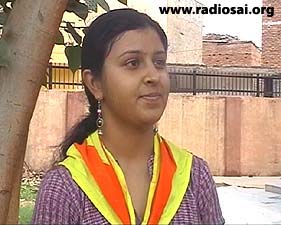 | |
Ms. Roohi Sharma speaks about her ‘awakening experience’ |
“Besides distribution of ORS powder for children and chlorine tablets, I was also allotted the survey duty falling under the SSVIP. It was a thrilling and fine experience.
“This experience showed me another life that exists in India. I always read that Baba says ‘True India Lives in the Villages’. I am really privileged that I got the opportunity to realise this that day. It was a wonderful project to assist. The unity with which the whole task was performed added colour to the whole program. All the sevadals were on their feet on Baba’s command, moving from door to door and helping the needy with all the support material that was required.
“In short, it was an awakening experience. I really feel that I had missed a lot in the past. This experience gave me divine pleasure and awakened my soul to the reality of life. Love All Serve All was experienced both in words and in action that day…. And the wordings written on the invitation card – mukh me sai naam aur haath me kaam (The Lord’s Name on the lips and His work in the hands) proved true that day.”
Empowering the Villagers to Take Responsibility
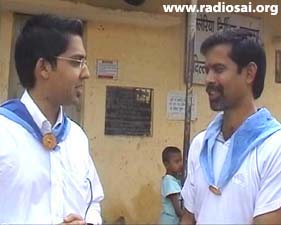 | |
Mr. Amarendra Kumar shares his ‘true bliss’ |
During the course of the morning, Mr. Jatinder Cheema and Vibhu Mahajan spoke to several village folk and sevadals to gauge their observations and reactions, and it came as no surprise that the response was overwhelming, both from the villagers for the support and awareness that had been provided to them that day and from the sevadals for the inexplicable joy they experienced in fulfilling Swami’s desire.
Almost all the villagers spoke in unison when they said that it was a wonderful idea to have the Sai volunteers visit them on this noble mission. Taking this forward, many of them also expressed their desire to be part of the Sathya Sai Seva Organisation.
Another village resident was so inspired from this whole experience that he told us, “I would be happy to participate in the effort the next time you visit us. I really liked the initiative that you have taken.”
Bliss Flows Both Ways
But the joy was greater for those who served. Amarendra Kumar also participated for the first time in this seva and he couldn’t get enough of it. “I am going through a period of true bliss after performing the seva. I was asked by the villagers if we came from the government and I proudly responded that we were from the Sathya Sai Organisation!”
 | |
Mr. Rishi Sharma: ‘The joy that I felt today, perhaps I have never experienced before.’ |
Mr. S. K. Malik has been a regular seva dal since 2001. As an experienced volunteer of the Sai Organisation, he said, “I am always looking for an opportunity to serve the Lord and participate in the Village Integration Programs.
“The villagers asked me if we would come on a regular basis and I responded that, if Swami wills it, we surely would. I impressed upon them that in addition to the Seva that we were carrying out, it was Swami’s desire for us to bring awareness in them to continue the task we had initiated so that their children would have a cleaner and healthier lifestyle.”
Mr. Jogindar Singh, another sevadal volunteer, said, “I am in the property business, and one day, my neighbour suggested I should take out some time to serve the needy. Normally the time I would have spent attending to my needs, I spent today doing seva. All I can say is that I am truly grateful to Him, for, after performing the seva I cannot describe the joy that I am experiencing.”
Clearly, the impact of the service was as much on the volunteers as it was on the villagers. Describing the concluding session of the one-day seva activity, Mr. Vineet, says, “After completing our duties, when we reported back to the bhajan hall, we all settled down and sang bhajans again and closed the event offering aarti to Swami. Then, there was a small talk by Mr. Jatinder Cheema, State President, Sri Sathya Sai Seva Organisation, Delhi, who congratulated the entire Sai family, and spoke about the significance of participating in such a meaningful activity. As the event reached its end, I could not help but pray to Bhagavan and ask Him to allow me to participate and partake of such bliss from more such activities in the future.”
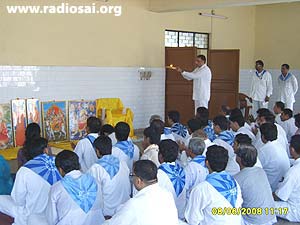 | |
The closing arati left all with divine vibrations |
Reflecting similar sentiments, Rishi Sharma, said, “The joy that I felt today, perhaps I have never experienced before. Today was our first step towards selfless seva, and with Sai Baba’s blessings, we will continue to stay on this path. We achieved a small feat in helping alleviate some of the village’s problems, about which we would not have spared a thought under normal circumstances. I believe the time all of us spent today for this activity is the first step towards leading a more fulfilling and meaningful life. With Baba’s blessing, we will have many more opportunities to serve in this noble cause.”
The Lasting Lessons of Selfless Service
Yes, it was a small initiative, but a significant one. The journey of a thousand miles begins with the first step, and as Swami often reiterates, “No act of service is high, no service is low; each act of service is equal in the eyes of the Lord; it is the readiness with which it is done, the joy, the efficiency, the skill with which it is performed that matters… If you consider the qualifications needed for service, know that what is essential is a pure heart….. You should also have faith in God as the spring of vitality, virtue, and justice. Service is worship you offer to the God in the heart of everyone. “
 |  | |
We must return to the village many more times, says the young Dipankar | Mr. Dhanpat Singh gave of his valuable time and effort gladly |
There was one touching example of such heartfelt service given to a poor innocent baby, which will have far reaching consequences for its future life – one Seva dal member relates it as follows:
“As we were just about to return back I got a call from another brother of mine; he wanted me to visit along with him a home which he had just finished surveying. He said there was a small one year old girl child who had a huge tumor on her back. Upon enquiring we found that they had shown the child at AIIMS and as the doctors had told them to deposit Rs. 15,000 for the operation, they had given up as they could not afford this amount.
We assured the family members that the child would be blessed by Bhagavan Baba and that the organisation was ready to support them in all matters. One of our brothers handed them a packet of vibhuti and explained to them its significance. We called one of our brother Seva dals who happened to work in AIIMS. On examining the child he also spoke to the family and assured them of his complete support for her treatment giving them his contact details. I was amazed to see such an amazing response from all my brothers towards the small child that I felt I was actually living in ‘Ram Rajya’.”
See the pathetic condition of an unfortunate baby – the villagers health needs are far from average |
The lessons from the morning’s activities were manifold for the Sai Youth, but the two that stand out are: One, that selfless service gives inexplicable joy because you feel Swami’s presence in every step despite all odds that you may have to put up with; and second, when you take the first step towards sharing love with others, God takes care of the rest. Be assured that all work will proceed smoothly without any interruptions.
 |  | |
Young Dinesh helped out on the day | Another of the dedicated seva dal team |
It was quite apparent that morning that many sevadals would have loved to carry on with the seva activities beyond the allotted time. Such was the satisfaction and happiness that these volunteers enjoyed that day.
 |  | |
Service that is of vital importance to the locals’ health… | …Performed with dedication and sincerity of action |
While we have so far associated the word ‘addiction’ with some form of evil, after that day we began to see its positive connotation. For, you just need to indulge once in the act of selfless service, the true happiness and joy that follows such a selfless act are enough to addict you forever.
The morning’s events can be aptly concluded by brother Vineet’s observations. He said, “Just as Lakshmana had asked Rama, I ask our Sai Rama, ‘Bhagavan! In Your kingdom, if you assign any responsibility, I shall fulfil it. That is enough fortune for me.’ “
Sai Ram.
Colossal Tragedy and the Current of Spontaneous Love
…How the Sai Volunteers in Bihar braved perilous odds
to reach out to the devastated and isolated
This is a story of two currents. One that destroyed and the other that saved. Both were mammoth and moving. How the most unexpected and unprecedented-in-half-a-century massive flood devastated millions of lives, destroyed crores worth of property and devastated hundreds of acres of cultivable land in one of the most populous and least developed states of India – Bihar, in the second fortnight of August 2008 is a shocking story, to say the least.
But what is equally astounding is how an Organisation consisting of a band of absolutely selfless workers plunged into this catastrophe without losing a second, to provide hope, succor and comfort to thousands who had resigned to their cruel fate and hopeless ends. They did not eat or sleep for days, and braved damage and death to ensure that their brethren are safe. This is a story of human empathy that flowed as swiftly as the speeding waters, giving true meaning to the most pious emotion of this universe – ‘love’.
The New York Times reported it as the worst flood in the area in 50 years; their headline pronounced: “Millions displaced by floods in India.” The Prime Minister of India declared it as a “national calamity” on August 28, 2008. The Indian army and non-government organizations operated the biggest flood rescue operation in India in more than 50 years. More than 2.3 million people were marooned. At least 2,47,000 acres of farmland were swamped destroying precious crops of wheat and paddy.
The ravaging waters gushed in at 25000 cubic meters a second and thousands were washed away even before they realised what was happening. Over 800 villages, 1000 individuals and countless families were destroyed. It was unprecedented, unexpected and the most ruthless devastation the state had ever seen in half a century. This is the sorry story of what unfolded in the one of the least developed and most populous states of India – Bihar, in the second fortnight of August 2008.
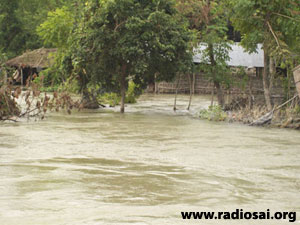 | 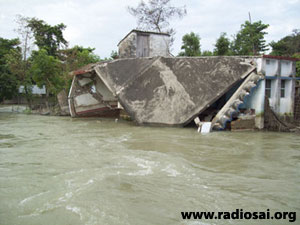 | |
Bihar witnesses the most atrocious floods in 50 years | The tremendous current spares nothing in its wake |
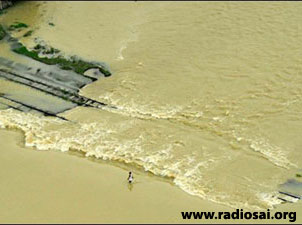 | 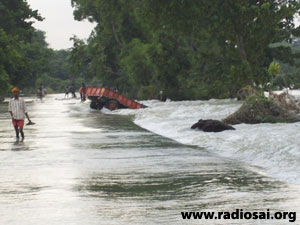 | |
Railway tracks are washed away… | …and roads become dangerous rivers |
The Saddest Day in Bihar in Half a Century
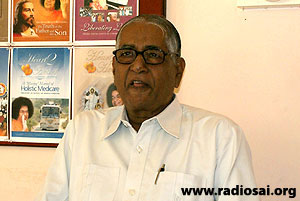 | |
Mr. S. B. Chaudhury, State President of Sri Sathya Sai Seva Organisations, Bihar |
In a matter of a few days from August 18 – when the people of India elsewhere were still upbeat after celebrating a lively Independence Day on August 15 – thousands of poor folk in Bihar were running for their lives, literally.
Leaving behind their homes and belongings, helplessly they sprinted as if possessed by a devil to find areas of safety; it was as if the God of death was after them. “Yes, it was not an ordinary flood, it was like a Maha Kal (a terrible wrath of the God of Death),” asserts Mr. S. B. Chaudhury, the State President of Sri Sathya Sai Seva Organisations of Bihar.
“Floods in Bihar are not uncommon,” he adds and continues, “Every year the River Kosi flows into the inhabited lands of Bihar and destroys crops and property. This river, as it is often called, is truly the ‘Sorrow of Bihar’. But the people on these occasions are not taken by surprise; they are prepared for it.
But what happened this year is shocking; it caught everybody unawares. The River broke its embankment at Kusaha in Nepal and through a huge 2 km breach in the dam, picked up an old route it had abandoned over 100 years ago! On the night of August 18, a huge wall of 22 feet of water started rushing in furiously and washed away everything – buildings, people, cattle, castles, trees, etc. – that came on its way. For all we know, the 1000 deaths might be an underestimate. Thirteen districts were affected, but in four the damage was severe; in Supaul it was the worst.”
“Yes, it was a perilous adventure and we did not even have regular boats; we had to make use of country boats,” recalls Mr. Shiv Shankar, and adds, “The current of the water was so high that if you stood on two feet of water, you would surely be washed away. In fact, the police and government authorities were stopping people from going into those areas. But, we were not afraid because we were absolutely confident that Bhagavan is with us. That is why Sai Organisation was the first to start relief work and we started with really remote areas where people were stranded on trees and elevated structures. Loaded with poha (beaten rice), jaggery, biscuits, milk, salt, candles, bread, clothes and medicines, we rowed kilometers on the rickety boats and reached out to the distressed. We had no fear; Bhagavan gave us the strength and we distributed all these items as His prasadam (gifts).”
“That is why Sai Organisation was the first to start relief work and we started with really remote areas where people were stranded on trees and elevated structures. Loaded with poha (beaten rice), jaggery, biscuits, milk, salt, candles, bread, clothes and medicines, we rowed kilometers on the rickety boats and reached out to the distressed. We had no fear; Bhagavan gave us the strength and we distributed all these items as His prasadam (gifts).” |
Overwhelming Sai Love in Action
Twenty sevadals served from 9 o clock in the night till 4 in the morning with the help of torches. They located every individual seeking help in the destroyed zone of Supaul and offered them food and clothes. If this was the situation in Supaul, it was no different in Madhepur, another worst-affected district. “When we surveyed this area on 23rd, we found that water had entered into the offices of the District Collector and the Superintendent of Police,” says Mr. Ram Avatar Razaq, the District President of the Sai Organisation of Madhepur. “In fact, the entire capital town of the district was a sea of water.
We found people perched on top of buildings and on elevated embankments. They were hungry, crying, shocked and devastated. When we filled their desperate palms with food carrying love in our hearts and the name of ‘Sai’ on our lips, they cried copiously. Overwhelmed with gratitude, they too vociferously chanted ‘Sairam!’ It was three days since their lives had turned completely upside down and nobody had come to their rescue. Since we served each one of them personally with lot of dignity and concern, they started treating us as if we were gods.
The Mission I’m-Possible
Were there not other Organisations doing relief work? “Yes, they were,” clarifies Mr. Ram Avatar, and adds, “But they would not venture into risky areas. For example, the village, Rampur, was 30-35 kilometers from Madhepur. It was completely covered with water, and all the people had taken shelter on an elevated land; they were anxiously waiting for relief but nobody would go there. In fact one of the government boats was drowned while making an attempt. But with the name of Sai in our hearts and the continuous chanting of Sai Gayatri, we rowed into that danger zone with loads of food and other essential items.
“The village, Rampur, was 30-35 kilometers from Madhepur. It was completely covered with water, and all the people had taken shelter on an elevated land… But with the name of Sai in our hearts and the continuous chanting of Sai Gayatri, we rowed into that danger zone with loads of food and other essential items.” |
There was a huge crowd waiting eagerly standing on a single piece of high land and surrounded on all sides by water. When we reached out to them and distributed milk, biscuits, rice and clothes, their sense of relief and joy knew no bounds! And Rampur, mind you, was not the only such location, there were plenty and we went to many such remote and completely isolated villages like Murliganj, Tunahi, Sukhasan and Garibtola. This was our continuous activity for days and weeks.”
While individual districts started relief activities immediately as a spontaneous reaction to the calamity on August 21, the State President of Sai Organisation felt the need to coordinate and organize the efforts more systematically to sustain the momentum of the good work. Hence, he called for a meeting of all the district presidents on the 24 th. After this session, supplies to the affected areas started arriving from more than 30 districts of Bihar and Jharkhand. 30 truck-loads of essential items came in immediately, and meanwhile, with the direction of All India President of Sai Organisations, neighbouring states too started sending in truck loads of materials.
“Now, resources were not a problem,” says Mr. Chaudhury, the State President. “Many states joined in. The state of Maharashtra sent vitamin biscuits for small children; and rice and dal, soaps and tarpaulins, sarees and dhotis came in from Delhi, Uttar Pradesh, Haryana and Punjab. Similarly, other essential food items and clothes arrived from Madhya Pradesh and West Bengal. What was needed at this point was proper organisation of packaging and distribution.
For this purpose, we created a base camp at Saharsha because this was the only place from where all the affected districts could be reached at the earliest. A theatre owner in Saharsa offered two big rooms and it was here that 50 Sai workers worked tirelessly every night for days and weeks making individual packets of all essential supplies. Each bag contained a minimum of 2 kilograms of beaten rice, jaggery, biscuit packets, milk powder, soaps, candle, matchbox, common medicines, clothes and other small items. Early in the morning everyday, a truck load of such packets were ready and a team of youth carried them to the distressed areas.
Where There is Nobody To Help, There is Sai
To give you one instance, our Sai Youth went to a completely marooned village called Sukhasan. Now, this hamlet was covered with three kilometers of water on all sides. When our devotees reached there with lot of difficulty on the country boats, the people there started crying out of joy because they said, ‘Nobody has bothered about us till now; we have been suffering for so many days.’ They felt ‘there is somebody who has not forgotten us’ and we told them it is Sai Baba who is concerned about you. They had never seen a picture of Bhagavan earlier, but now whenever we go there, in joy they exclaim ‘Sai Baba has come, Sai Baba has come’.
“Our Sai Youth went to the remotest of areas and delivered the items wherever they were. Like all Sai activities, we did all of this with great reverence and love for the unfortunate ones.” |
What needs to be highlighted here is that while there were many other agencies engaged in relief and rehabilitation work, their efforts were restricted mainly to the towns and the areas that were easily accessible. They asked the people of affected areas to come to the urban areas to collect the supplies, but our Sai Youth went to the remotest of areas and delivered the items wherever they were. Like all Sai activities, we did all of this with great reverence and love for the unfortunate ones.”
Soon we reached the relief camps and other affected areas. At every place, we first made everybody – children, ladies and gents – sit in neat rows and only then started the distribution chanting Swami’s name. What generally happened in such situations, with other organisations, is that there would be a stampede, and then many items would be either destroyed or lost because of grabbing and fighting. But we treated them with love and they responded well too. We ensured that there is discipline and calmness during distribution so that everybody got his/her packet.”
The ‘Grama Seva’ Experience Put Into Action
“It was not difficult for us to immediately strike a chord with the villagers because we are used to serving in the rural areas all the year around,” explains Mr. P. V. Krishna Mohan, an alumnus of Sri Sathya Sai University and now Jamshedpur Sai Youth Coordinator. “We understand them very well. Besides, because of our experience in disaster and relief management, we were among the first organisations to get into the rescue act. And our focus was on the villages and isolated areas because it was these areas which no other organisation was venturing into.”
“I cannot forget Garibtola,” adds Mr. Ram Avatar Razaq. “It was so risky to get there. The river was overflowing; at places it was very deep. Our boat was literally rocking dangerously; we could bang into anything and turn upside down. It was due to His sheer Grace that we reached that village which had now become an island. We saw people sitting on raised platforms and trees; they were probably living in that situation for at least ten days. They drank the same flood water as they had no choice. The government helicopters did drop relief material, but many a times these fell into the river.
“Once we reached there, we personally distributed food, clothes and medicines to women, children and the adults. Throughout the day, like during many other days, we were so occupied with relief work that we forgot hunger. We used to eat only after we returned to our base camp in Saharsha in the midnight.
New Challenges, But Same Solution – Love
“But the challenges were different in every area. In another village, Rampoortola, we traveled on knee-deep water for 40 kilometers in our jeep, and after that there was absolutely no road. So we walked another 3 miles carrying all the relief material on our shoulders. In fact, a few of our volunteers and the villagers had to acts as security guards with sticks because there were people in the towns who looted the supplies. We did finally manage to reach the completely devastated village.
Our hearts broke when we saw the sight there. The children were crying; the women had lost all hope – you could see the emptiness in their eyes, and the men folk were hungry and helpless. They had received messages from other organisations to go to the towns for food, but they had no energy or hope. When we served them food, they were still dazed; they could not believe that somebody had actually come to their destroyed village and was concerned about them.
“They had received messages from other organisations to go to the towns for food, but they had no energy or hope. When we served them food, they were still dazed; they could not believe that somebody had actually come to their destroyed village and was concerned about them.” |
I was so grateful to Bhagavan at that moment for having blessed me with that opportunity to help those poor souls. I did see God in each one of them, and with that feeling I wiped their tears. I had never before experienced the bliss of serving and giving like I did that day. This entire project has been such a powerful and divine experience for me.”
Sustained by His Energy, Nothing Else
“I sincerely felt that it was God who was reaching out to another form of God,” says Mr. Shiv Shankar Choudhury, the other district president. “The grueling five weeks of service was like a penance for me. I used to get up at 4 every morning and sleep only after midnight. At 6.30 a.m. every day we started with our loaded trucks and returned not before 10.30 p.m. After that I had to attend to other organizational and paper work to ensure that the supplies are properly received and packing went on smoothly, apart from preparing official reports. On many days, the only food I had during the whole day was a biscuit packet. I have no idea from where the energy came from. If none of us have fallen ill, it is purely His grace. In fact, we felt His love and protection every single day.”
Saved by His Unmatched Grace
Now, Mr. Ram Avatar takes over again. “Yes, I remember, on August 28 evening, when we were returning with left over relief material on our truck, it started raining heavily. Our materials were not covered; they were in jute bags. We intended to distribute them on our way back. At 9 p.m. when we stopped at a town called Jitapur, we were shocked to see that none of the packets were wet! We immediately brought them down and distributed it to the people of that area. There was one building which had survived the flood in Jitapur and that government shelter was crowded with people. They were needy and too delighted to receive our food and clothes.”
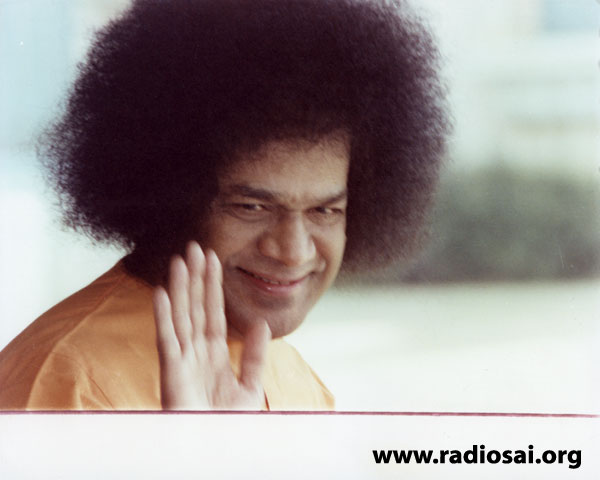 |
“Instances of His Grace are numerous,” continues Mr. Shiv Shankar Choudhury. “When the dam breached on August 18 near the Indo-Nepal border, one of the villages which was terribly destroyed was Dirpul. None of the houses – old or newly constructed – in that village could withstand the ferocious water current, except one.
“It was a family of Sai devotees; they climbed onto the roof of their house. Their faith in Bhagavan was so strong that they had no fear. The water rose to 20 feet but they, along with their house, were safe. They stayed on their roof for 10 days and once the water receded, came down the stairs and found all things in their house intact!
“There is another incident of how Swami amazingly saved a boat full of people. The sister of one of the Sai devotees was trapped in a flooded area. This area was 40 kilometers from Supaul. We were unable to reach her in spite of our best efforts for many days. And then suddenly, on the eighth day, she called up from her mobile.
“We were taken aback. Her phone, by providence, had started working after more than a week! Then, we arranged for a military boat to go to her rescue. As the vessel moved, it found a lot of people on the way seeking to be helped, so it got all of them on board. Slowly, the number increased and by the time the boat reached his sister, there were already 80 people inside; there was no room for her.
“So the vessel turned, promising her to return for the second trip. On the return journey, suddenly the engine of the boat stopped functioning. It was a precarious situation because the water current was very high. We were worried and started chanting Swami’s name. Next, the boat hit the pillar of a bridge, and was tossed back and forth by the ravaging waters. It again banged into another concrete post. Mind you, these were really hard collisions, but somehow the boat was not destroyed. And fortunately during this process, the vehicle got stuck to the bridge. Then the military personnel on the bridge got immediately into action and dropped ropes. Soon, all the people were saved. After two days, the devotee’s sister too was rescued. It was prayer alone which saved so many lives, quite mysteriously, that day. Baba says ‘I am the Indweller’ and we felt His presence in so many ways.”
Sai Service – An Eye opener For Many White-collared
Mr. Krishna Mohan, the enthusiastic Sai Youth who works in Telco Company, Jamshedpur, says, “This chance to serve blessed us with a higher level of self-satisfaction because we felt we were offering service not to people, but to different forms of God. More than the bliss of being use to others, it was an eye-opener too to many people in the Sai Organisation and beyond. I sent out an email to all the employees of our company informing them of our service initiative, and so many came forward to help.
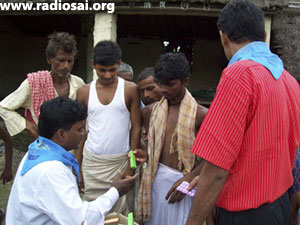 | 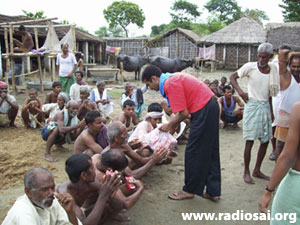 | |
Essential medicines were so vital to the suffering lot | The joy was not only of the beneficiaries, but also of the sevadals |
They were shocked when we showed them the pictures and video clips of our work. The ideals of the Sai Organisation moved them. It shook their beliefs and they came out of their comfort zone to help the distressed wholeheartedly. This transformation in their outlook is something very valuable to themselves and to the society at large. Therefore, there were such silver linings too to this dark cloud of disaster.”
A Diwali With a Difference
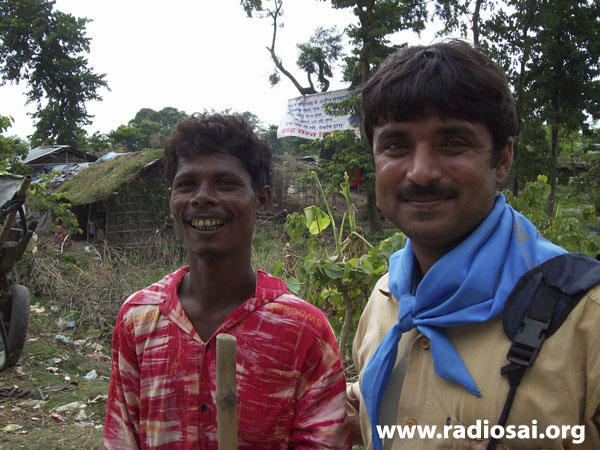 | |
The joy of being one in Love |
The relief work that started in right earnest in August 21, 2008 continued for five weeks benefiting 50,000 people in the worst affected districts.
“Once the water receded completely and people returned to their respective villages, we distributed them special kits to help them rebuild their lives,” says Mr. S. B. Choudhury, the State President of Sai Organisation of Bihar.
“These comprehensive packs which had cooking utensils, serving plates and spoons, blankets, 20 kilograms of rice and other food grains, sarees and dhotis were gifted to them before their festival day of Diwali which fell on October 28. The joy in their faces is to be seen to be believed. For us, there was no other way we could have celebrated this festival of lights better.”
Sai – The Perennial Stream of Love
Truly, we shine brighter when we lend our lives to others. The Sun is glorious because it gives itself to others incessantly. And walking in this sunlight path of selfless service, the volunteers of the Sai Organisation of Bihar have experienced true bliss; they were able to fathom the source of genuine joy.
The magnitude of their service may not be mammoth when compared to the colossal devastation that this poor state saw, but at the end of this sacred exercise, Sai workers grew richer by enriching the lives of how many ever they could in the best manner possible. It was simply Pure Love in action, inspired by Pure Love Incarnate, Bhagavan Sri Sathya Sai Baba.
Drinking Water Project at NTT - Indonesia Report August 2005
Sri Sathya Sai Organization of Indonesia is currently conducting a water project at the village of Mbuliloo, Nusa Tenggara Timur. The scarcity of water supply in this devastated area had forced the villagers to survive by only relying upon a well of 5-cm depth which is at a distant location.
People in this forgotten-remote area had been seeking for relief, but yet dare not hope. At last, the agonies of the villagers caught the attention of a Sai devotee, who conveyed the situation to the Sai Organization. Actions were immediately taken by sending a volunteer, as a representative, to supervise and do hands-on monitoring for this water project with the help of the local people.
In that area, there was only one well available which was previously a private property. Sai Study Group managed to negotiate with the owner to take over the ownership of the well, and then started the mission for the benefit of all.
A water tank was built to collect water from the well. From the tank, 900 pipes were used to channel the water to houses which covered approximately 7 kms in distance; to provide clean water to more than 234 families.
At last, the well has finally relieved the people in the area from the prolonged suffering due to water scarcity. It was the most precious gift for the people of this village. The local authorities, on behalf of the villagers, then submitted a formal letter of appreciation to express their deepest gratitude to Sri Sathya Sai Organization Indonesia, which reads as follows:
Testimonial Letter
Mbuliloo, 2nd May 2005,
To: Yayasan Sri Sathya Sai
Dear Sir or Madam:
With this letter, we, the people from village Mbuliloo, Wolowaru district, Ende – Nusa Tenggara Timur (NTT) Province of Indonesia, would like to express our deepest gratitude to Sri Sathya Sai Organization that has helped us overcoming our major problems in daily life. In our village of Mbuliloo, especially in 5 areas: Nggaja, Kuruene, Nuamuri, Batembue and Mbuliloo, the people here had struggled to cope with lack of fresh drinking water day-by-day, without any hope on how to raise fund in order to provide safe clean water.
The kind Sri Sathya Sai Organization finally came to rescue, and made all possibility became possible. Previously, we could only used to wish as we realized there was no way we could afford it; being poor & simple people. All those times we managed to live, relied upon using the well in distant location, which had a water level of toe-deep to be shared with more than 234 families.
All of a sudden, our wish came true when our beloved brother, Abdul Syukur Boya from Sri Sathya Sai Organization came to deliver a great news and funding to be used to provide a safe drinking water to our village.
We were touched and deeply grateful. We could never imagined in this world full of politics turmoil and social crisis, there is still people out there who mindfully care to help small helpless people like us. We took this opportunity to express how delightful and thankful we are to Sri Sathya Sai Organization that has given the greatest kindness gift we could never be able to repay. Therefore, we pray to the Almighty Lord to always bless and support Sri Sathya Sai Organization in all activities and great work they conducted.
May God returns all the kindness you had given us for He is the Greatest Love of all.
Many thanks from all of us, the people of Village Mbuliloo.
Eight Years of Elevating and Holistic Healthcare
On January 19, 2009, the Sri Sathya Sai Institute of Higher Medical Sciences, Whitefield, celebrates its 8th anniversary; another fulfilling year in the calendar of the Sai Health Care Mission. Times change, people alter, but the will of God remains eternal. Many are called but few are chosen, is an oft repeated aphorism.
 |  |
When opportunity meets energy, the result is a revolution. Bhagavan Sri Sathya Sai Baba has set in motion a revolution founded on the most fundamental need of every being – Love. Swami’s Hospitals are the physical representation of “Love in Action”. No wonder they are referred to as ‘Temples of Healing’.
With its four specialties of Cardiology, Cardiothoracic surgery, Neurology and Neuro surgery, the SSSIHMS, Whitefield, has steadily been healing hearts and minds – physically, emotionally and spiritually – and returning them to society as productive men and women. The guidelines that Swami has given form the bastions that hold up this edifice of healing:
- Medical care should be made available to all patients free of charge.
- Medical care should be administered with love and care.
- Every patient should be given the best available treatment.
- The patient, and not merely the disease, should be treated.
With time, the SSSIHMS, Whitefield, has evolved to meet demands from various fronts: Clinical, Academic and Technological. In addition to this, fresh initiatives have also been taken to provide more amenities at the staff residential campus.
I. The Clinical Dimension:
Exploring New Frontiers of Cardiac Sciences and Setting Challenging Targets in Neuro Sciences
On the clinical front, a special mention must be made of the Department of Cardiology which has surpassed itself in performing a variety of cases and has added to its repertoire the cutting edge procedure of Device Closure. This is a new technique where holes in the heart are closed using artificial devices in the Catheterisation Lab, instead of doing an open heart surgery.
 | |
Cross section of a healthy heart (left); with a septal defect (right) |
A little explanation will make this clearer. The heart has four chambers, two atria on top and two ventricles at the bottom.
The right side of the heart pumps impure blood to the lungs, which return pure blood to the left side of the heart, which in turn pumps the pure blood to the rest of the body.
There are four valves that control the unidirectional flow of the blood; from the left – the mitral, the aortic, the pulmonary and the tricuspid.
Anything out of the ordinary with the walls between the chambers or these valves, leads to a cardiac problem. “A hole in the heart” causes pure and impure blood to mix leading to various other complications.
Earlier, these holes could be closed only through open heart surgery, where the sternum (breast bone) was cut in half, the chest opened up and the surgery done on Cardiopulmonary bypass using a heart lung machine. This, of course, meant that the patient was scarred for life and post operative complications always hung like the sword of Damocles. Young women and girls in their teens were the worst affected since the scar on their body was always a cause of concern for them.
In Device Closure technique, a small collapsed synthetic wire-meshed device is threaded onto a catheter and through standard catheterisation procedure is manoeuvred into the hole and released. The device pops open and expands into a disc that effectively blocks the opening, and restores normal blood flow. It has the same result as a full fledged operation, but without the pain, scarring or intensive care unit observation – all this at the same price. The benefit is enormous, particularly because the patient can return to normal life and activity within two days of the procedure with no after effects.
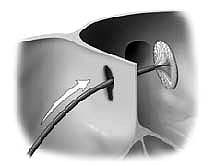 |  |  | ||
The vascular device in threaded into the hole… | …guided by catheterisation… | …the device expands to block the hole and the catheter is removed |
The workshop on Device Closure conducted by SSSIHMS, Whitefield on November 13, 2008 had Dr. Hieu from Vietnam National Heart Center demonstrating the procedure. Dr. Dash, Head of the Department, Cardiology, SSSIHMS, Whitefield was guided by Dr. Hieu, and together over 8 cases were addressed in one day.
Other participants from SSSIHMS, Whitefield included Dr. Barooah, Dr. Amit Garg and DNB (Diploma of National Board) residents. Dr. Ravi Narayan from Manipal Heart Institute, Dr. Deepak from Vydehi Institute of Medical Sciences and Research Center, and Dr. Keshav Murthy from BGS Apollo also participated in this workshop.
The Department of Neurosciences, not to be out done, has performed more than 49 aneurysm clippings (surgical procedure to treat a balloon-like bulge or weakening of an artery wall) in the brain along with a host of other surgeries including spinal surgery and brain tumour excision. This department has upped its ante of increasing the number of surgeries, and as a unit, has achieved the set targets. There are new frontiers now being envisaged.
II. The Academic Dimension:
The Sri Sathya Sai Institute of Allied Health Sciences, Aids Scores of Students
With the inauguration of the Sri Sathya Sai Institute of Allied Health Sciences, the SSSIHMS added another feather to its cap. Already recognised by the Diploma of National Board, the Hospital has a full fledged DNB program in Cardiology, CTVS, Neurosurgery, Anaesthesia and Radiology. Now, the Hospital has further increased its academic ambit by offering undergraduate paramedical training programmes. The SSSIAHS offers seven courses – B. Sc. (nursing), BSc. (Radiology), BSc.(Anaesthesia Technology), B. Sc. (Cardiac Care Technology), B. Sc. (Imaging Technology), B. Sc. (Medical Lab Technology), B. Sc. (Perfusion Technology). All the courses are offered totally free of charge. The students are provided accommodation on campus and are selected through an entrance examination. The program is affiliated with the Rajiv Gandhi University of Health Sciences.
| |||
The first batch of fortunate students who are being trained for free at the Sri Sathya Sai Institute of Allied Health Sciences |
The first batch has 57 students with a compulsory science background hailing from various parts of the country. They are taught the Sai system of education and educare, and are made aware of the value of the opportunity provided to them. For instance, an undergraduate nursing training programme in a commercial institution costs Rs. 4,00,000 (US $ 8300). The students of SSSIAHS get it absolutely at no cost to them.
The academic curriculum is designed to give the students the best of both worlds, and there is no paring of resources when it comes to delivering quality education. A fully equipped library, laboratory facilities, computer lab, and avenues for various extra-curricular activities provide the students all they need to mould themselves into fully productive members of society. Their classrooms are equipped with technological aids including LCD projectors, networked computers, and the new kid on the block – Moodle (more about it later). In SSSIAHS, it is called LMS (Learning Management System).
III. The Technological Dimension:
eHis and Telemedicine – Demonstrating the Direction to the Future
On the Technological front, the institute conducts academic research focusing on preventive healthcare, low-cost substitutes for medical implants, and clinical markers for early disease detection to name a few. Inspired by the noble mission of the Hospital, many professionals of eminence from various domains and geographical locations visit the institute and contribute their expertise.
The Hospital has moved over to a superior electronic database management system called the eHIS, short for, Enterprise Hospital Information System, set up by IBA Health, a leading provider of medical software solutions. The DMS (database management system) is a multidimensional tool that is being customised to suit the needs of the Hospital with able support from the managers of the Hospital’s Information System department working in tandem with the representatives of IBA Health. Efforts are now on to have a complete software solution including the Human Resource Management, Asset Management as well as Payroll modules.
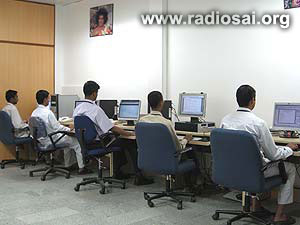 |  | |
The Information System Department | The hub of Telemedicine |
The Department of Telemedicine that started just 18 months ago has already helped over a thousand patients, both cardiac and neurological at the Barrackpore nodal center in West Bengal. Tele-consultation for cardiac sciences started less than four months ago, and over 90 patients have benefited from this new service. Efforts are now underway to open a second nodal point in Orissa that has the second largest concentration of patients visiting the Hospital.
IV. The Academics-cum-Technology Dimension:
“eGuru” Takes off to Train the Eager and Inspired
Technology offers tremendous opportunities to impart interactive, enriching and collaborative learning experience for the students, and a Learning Management System (LMS) is the best tool to harness its potential. The institute deployed an LMS in October 2008 using the popular open source Moodles under the banner “eGuru” to impart, administer and manage the various academic programmes and courses it offers.
eGURU offers self-paced, interactive and object-oriented training to its students. The trainers of education are very adaptive to such technologies and advancements which give LMS an edge in acceptance and usage. The institute plans to extend the scope of LMS to enhance staff skills, job-oriented training, and shape it into a knowledge portal.
One can use the LMS to: access course materials (such as lecture slides and assignment sheets), view announcements (that will be posted throughout the semester and will contain important information about the subject, such as reminders about an upcoming assignment due date) and perform online tasks (such as submitting an assignment).
The course outline, lecture notes, assignments, and other learning resources will all be made available through the LMS. In addition, one will also have access to online tools such as feedback quizzes, interactive courseware, and audio recordings of lectures.
The advantages of e-learning are many, such as: Flexibility – anytime and anywhere; Self-paced – students can learn at their own pace; Knowledge Management and Electronic Performance Support; increasing the self-responsibility of the students; and so on.
V. The Spiritual Dimension:
Direct Guidance from the Divine – Swami’s Visit to the Hospital
While all these developments have been taking shape in the Hospital in recent months, the One who actually shaped and gifted this marvel of healing to this world, and continues to inspire the employees in so many different ways, Bhagavan Sri Sathya Sai Baba, blessed the Hospital again with His personal visit on June 7, 2008. On this occasion, He inaugurated the “Sai Veda Venkatarama Health and Fitness Center” in the residential campus of the SSSIHMS.
 | |
The Sai Veda Venkatrama Health and Fitness Center |
The fitness centre was the concretization of the words spoken by Swami on His visit to the Hospital on January 26, 2002.
On that day Swami had blessed the staff of the Hospital with His divine message in which He said, “In due course, this Hospital will have a General Hospital, and a school for children. In the evenings, the tired teachers and doctors will have a play ground to relax and play tennis. I will arrange for all these amenities.”
The SSSIHMS Whitefield now has the Sri Sathya Sai General Hospital, Whitefield associated with it, the Health and Fitness centre has a tennis court, a basket ball court, an indoor shuttle court, a fully loaded gymnasium and an indoor games area; a crèche for the children of the staff is also part of the fitness centre complex.
After inaugurating the campus, Swami blessed the Hospital and surprised all the staff with His munificence by dining with them in the huge atrium of the main building. He then blessed all those present with His Divine message in which He highlighted man’s weakness for wealth and the loss of health in pursuit of the same. Here is an extract of that timeless discourse:
“The world today…is dependent on money. Whichever party or department you may see… it is all money, money, and money… For the sake of money, everything else is discarded. One destroys one’s health for money. Health is very important. It is the greatest wealth. With good health one can achieve many things. Therefore, Hospitals are very much necessary to be healthy. Amongst you, some consider themselves doctors and others as students. No! In my opinion, all are students. Even doctors, need to study, learn and know many new things.
So, they too have to study throughout their lives. Doctors and everyone else too… should learn new techniques… And find treatment for new diseases. Giving medicine alone is not enough. More investigation has to be done to ascertain if the dosage is sufficient and know more about the nature of the disease. The personality of the patient as well as the cause of the malady has to be thoroughly understood; at times, the diseases are genetic, at other times, from friends and associations, or through unforeseen circumstances. Diseases come and go…The cure is not as important as preventing the infection. This is very important in youth. All powers are imbued in youth energy. God, the almighty, the All-knowing One, is in man. And in man, there are thoughts, mind, intellect, awareness…and ego. Diseases arise because of all these. Even the food we eat… gives rise to many diseases. Therefore, investigate the food you eat… is it Satwic, Rajasic or Tamasic? First and foremost, examine the food. Satwic (sublime) thoughts arise from Satwic food, and Satwic actions arise from Satwic thoughts. So, based on food… diseases progress. First, partake Satwic food. Alcohol and non-vegetarian diets bring with them many diseases. There is no medicine for these diseases. If we eat proper Satwic food…good health is assured. So, eat Satwic food… but in moderation. Excess eating leads to indigestion. Just because it is tasty, do not overeat. But children today do not think on these lines. They consume immediately whatever is offered. One has to investigate to know if the food is Satwic, Rajasic or Tamasic. Therefore, the mind is the cause for bondage or liberation. In fact, it is the cause of everything. Mind is the primary source of both health and happiness. If the mind is steady… one has good thoughts. Good thoughts lead to good action. And good action in turn gives rise to happiness and health. So, we have to be careful of what we eat. Without health, the body is of no use. It cannot do any work. So take care of your health. For children too, in whatever they may learn and play, everything should be in moderation (mitamu) and hitamu, that is, for goodness and good will. The world needs both of these.
Today in politics, there is no moderation. We find excesses in all forms. More importantly, there is no goodness or good will. With moderation and goodwill, one earns respect from society. To provide strength and support, and reform society… we must enter society, and give them appropriate advice. Not mere advice, but demonstrate to them through our actions. When we do so, society will reform. Therefore, if society has to improve, it is possible only through our efforts. If society and country have to progress, first you should evolve. When you transform for the better…you can then help society. Understand this concept. You consider the body very important… not the body, the sheaths covering the body are important. Mind, intellect, awareness and ego… are the four coats covering the body. First and foremost, the coat of buddhi (intellect) must be removed from the Atma. Why do you wear a coat? It is to protect from external environment. First, remove the coat of Tamas (dullness and inactivity). Abandon the vest of Rajas (unwarranted aggression and passion) and discard the shirt of ego. What remains is the body. This mind, intellect and awareness are meant to facilitate the function of the body. Without these, the body is an empty balloon. Once the body is empty, neither sin nor merit will touch it. Neither praise nor blame; or rewards nor ignominy will have any effect on it. The body is then liberated. Therefore, eat in moderation. Do not eat in excess and make your stomach look like a “question mark”. When you feed the the patients in the Hospital, speak to them peacefully. Have a cheerful “smiling face”. When we explain to them calmly, they will develop good feelings and follow the right path. Therefore, students too should be careful. In particular, if students are well, the Hospital will be fine. They must follow doctor’s advice, respect their words and learn from them.” | ||||||
After this, Swami blessed the staff with group photographs and then left for Brindavan. The very next day He returned to Prasanthi Nilayam.
| |||
Bhagavan with some of the medical staff during His visit to SSSIHMS, Whitefield, on June 7, 2008 |
VI. The Inspiring Dimension:
The Beacon of Blissful Healthcare for the Twenty-first Century and Beyond
“Hi Arvind, this is Lakshmikanth from Stockholm, remember me?” When one receives a call that begins like this at 10.30 in the night, it is a natural reaction to say ‘wrong number’, but when the caller has used your name you begin to think twice. Well, in this case, it turned out to be genuine. The call was from the Karolinska Institute, Stockholm, Sweden.
Some of the alumni of the Sri Sathya Sai University are doing their academic research there, and Lakshmikanth was one of them. He and his co-researcher, Mr. Pettr Brodin, M.D., an immunologist, were working together on the same project and had been to Australia to attend a conference. They had to stop over in India, and when one is touched by God, one cannot but run to him at the first chance. Therefore both of them visited Prasanthi Nilayam and had Swami’s darshan. And after this, Bangalore being just a three hour drive away, they decided to see His Hospital.
Apparently, life is indeed a series of appointments. It is a matter of semantics whether we call these moments appointments or circumstances or coincidences or miracles. To paraphrase Albert Einstein, one can live life only in two ways, as though nothing is a miracle, or everything is a miracle. I must confess, I don’t believe in coincidences. As Swami says, everything happens for a reason.
Pettr and Kanth, as they wanted themselves to be called, drove in from Prasanthi Nilayam in the afternoon just in time for lunch. Over lunch we swapped tales of our experiences working in Hospitals and I was surprised to find Pettr, a European, relishing proper Indian fare, down to eating without a spoon and fork. I asked him about this, and he grinned and gave a distinctive answer “Looks like the amino acids on my finger tips are adding a new taste to my lunch”. One can’t argue with such an answer. Anyway, after their lunch we set out on a tour of the Hospital.
He Came, He Saw and Was Conquered
We started with the main atrium that soared up 488 feet with its massive six layered crystal chandelier, surrounded by four acres of space . Though Pettr kept a straight face, one could see he was impressed. We went over to the wards, and Pettr whispered in the deafening silence of the preoperative cardiac ward, “Is this a ward?” It was enough to tell me that he was moved. Being a doctor, he had seen many hospitals.
But he later confessed, “This is different. I’ve never been to a place like this before.” Then, with the permission of the Chairman of the Cardiac Sciences, the three of us entered the cardiac theatres. Again Pettr’s silence told me much more than words can assay. Not many can put into words their feelings when they see Operation Theatres, and Cath-labs half the size of shuttle courts, wards the length of football fields, with roofs soaring up to 25 feet, balconies larger than an average sized parking lot, and an atrium that fills them with awe and reverence.
| ||||
A multi faceted overview of some of the visual highlights of the SSSIHMS Bangalore |
It was when I took him over to the patient counselling area that his façade melted a bit. The patient counselling department at SSSIHMS was the brainchild of Mr. and Mrs. Umesh Rao, who are long time followers of Bhagawan Sri Sathya Sai Baba. In their recent visit overseas, they had been to Karolinska University, and had presented the concept of emotional counselling with the onus on psychosomatic relationship to some of the senior staff over there.
Their response had been overwhelmingly in favour of the idea, and they agreed that what they were just beginning to accept with scientific validation was already being practiced at the SSSIHMS for the past 8 years, and the underlying concept had been expounded by Bhagawan Baba decades ago, “Treat the disease and not merely the patient”.
Pettr was from the same Institution and was in the audience when the couple had made their presentation. He saw what was propounded in reality – if seeing is believing, he saw and believed.
There are many more like Pettr who come with questions and return with none of them unanswered. For actions speak louder than words. Ask and you shall be given, knock and the door shall be opened is what the Bible says. We are taught again and yet again that we have to take the first step. But we rarely heed the words.
Probably that was the reason for the great artist Michelangelo painting the magnificent fresco of God reaching down from the heaven every sinew of his arm stretched fingers pointed…reaching out to man…but man lies on the earth, his arm raised in limp response, his fingers lifeless and without spirit. God does not have to descend on earth to prove He exists. He exists in the good man who helps his fellowman.
But when God does descend on earth and sets an example, He lights up fiery beacons that do not hide their glow, but speak through silent action, putting smiles on the faces of those stricken by sorrow and defeated by life. It is time to do what we have to do. The words of Robert Frost should always reverberate in our minds…
Bhagavan Baba's Philosophy and Methodology of Education with a Focus on Water Education for African Cities
by Victor Krishna Kanu
IN THE RECENTLY PUBLISHED book “Water – the Elixir of Life”, documenting many drinking water projects of Bhagavan Sri Sathya Sai Baba during the last decade, we read: “Next to air, water is the element most essential to sustain human life. It is therefore no wonder that in ancient times, people in all societies revered water as a wonderful gift of God. Almost all major religions have an important place for water in their rituals; these involve cleansing, blessing, ablutions of various kinds and offerings accompanied by the pouring of water.”
Water as a Basic Element
According to the story of creation in the Bible (Genesis 1: V1-2), we are told: “In the beginning God created heaven and earth ….. the earth was without form ……. And the spirit of God moved upon the face of the waters”. This shows the part played by water in the beginning and sustenance of life as perceived by Bible believers.
Truly, water is sacred and must be treated as such by all its users. Yet, there are billions of people on this planet to whom good drinking water is not available or accessible.
Sri Sathya Sai Water Supply Project India
Responding to the dire needs of the people of the scarcity affected regions of Andhra Pradesh, Bhagavan declared in March 1995 that He was going to provide drinking water to the villagers who had been the victims of acute drinking water shortages for more than a century. Sri Sathya Sai Water Supply Project was thus started which has provided water to millions of villagers of Anantapur, Medak, Mahboobnagar, East Godavari and West Godavari districts of Andhra Pradesh during the last 10 years. It has also met the acute drinking water shortage of the city of Chennai in Tamil Nadu. All this was possible through the unlimited love and grace of Bhagavan Sri Sathya Sai Baba to all mankind. As He Himself says: “I am always ready to help you and serve you. You may belong to any village or any district ……… I do not have any feelings of difference – religious, regional or national. I do not go by the position of the people or the place to which they belong. All are the same to Me and I serve all equally”. Bhagavan’s example of His concern for the supply of water is being replicated by many countries of the world.
Water in African Cities Project
There exist many dissimilarities in African countries in terms of size, water resources, water management styles, economic differentials, social and environmental norms related to water, etc. Yet their national goals and objectives are basically similar. They all have, as their main goal, the provision of adequate cost- effective and good water supply for all (the economic and social dimensions of water). In cognizance of the fact that these goals cannot be achieved in isolation, these countries have, as complementary goals, the maintenance of a good environment, avoidance of water wastage and pollution, prevention of vandalism and illegal connections; discouraging late or non- payment of water bills, non-tampering of water meters, prevention of water riots and water wars, eradication of corruption and enhancement of adequate sanitation and better hygiene practices through technical and regulatory measures. In pursuit of their goals and objectives, the African cities have been using different strategies as leverages towards the realisation of their national goals. Overall, these strategies have not produced the desired results of reaching national goals and objectives. This is because of the absence of second tower that lays emphasis on the transformation of attitudes and behavioural patterns of water users and providers. UN-HABITAT have for a long time been searching for a tool or mechanism that will enrich and strengthen Water Education strategies in Africa.
Human Values Approach to Water Education in Africa
The introduction of the water education initiative was preceded by an Expert Group Meeting (EGM) convened by UN-HABITAT in collaboration with United Nations Environment Programme (UNEP) and the Swedish International Water Institute (SIWI) in Johannesburg, South Africa from 30th April to 2nd May 2001. The meeting brought together international and regional experts on education, curriculum development, urban development, water resources management and NGOs active in water education. The objectives of the meeting were to share information on the ongoing water problem in Africa, develop a broad consensus among all stakeholders with regards to the most effective strategy for introducing Water Education in-African cities, agree on sharing of responsibility for project implementation by different partners and develop an action plan for the project implementation.
An important outcome of the Expert Group Meeting was the consensus acceptance of the paper presented by the Director of the African Institute of Sathya Sai Education (TAISSE) with the title “Water Education: A Human Values Approach” which was, in fact, a reproduction of Sri Sathya Sai Baba’s philosophy and methodology of Human Values Education in its pristine form. The recommendation arising therefrom was the pursuance of a Human Values Approach to introducing Water Education for African children and communities.
Understanding Water Education
What is Water Education? From the point of view of the Human Values approach, Water Education is not just about water literacy (knowledge of the science of water, types, sources, uses, treatment, management and its associated problems, etc). These are, of course, important tangibles. However, Water Education is also about intangible things that are equally important. These include people’s perceptions of water, the level of their consciousness towards water usage, awareness of their civic responsibilities towards water, cultural beliefs and practices in relation to water. In short, it is about Human Values – about the country’s sense of duty, the obligations members have to each other, to the use of water itself and to future generations.
A country’s sense of duty ought to be strengthened through Human Values Education towards the management of water and other resources which took billions of years to develop and yet, which would be diminished or exhausted within a relatively short period of time.
There is, thus, a compelling need for the introduction of Human Values in Water Education as a complimentary to the existing technical and regulatory measures in water demand management. In this manner, Water Education will stand firmly on the twin towers of water literacy and Human Values – their understanding, commitment and practice.
The Expert Group noted that Water Education should aim at promoting a better understanding of water as a key social, economic and environmental resource and should facilitate the emergence of a new water management ethic on the continent. It is observed that the introduction and implementation of Value- based Water Education (VBWE) through formal, non-formal and informal channels of learning, especially through the use of the curriculum is a promising strategy to bring about a positive and lasting change in attitude and behaviour towards water at all levels of society.
Value-based Water, Sanitation and Hygiene Education (VBWSHE)
Having been inspired by the successful implementation of Bhagavan’s Values Education programme at the African Institute of Sathya Sai Education (TAISSE), Ndola, Zambia, many countries in Africa today are involved in Value-based Water, Sanitation and
Hygiene Education (VBWSHE) programme.
In 2002, TAISSE was contracted for two years by UN-HABITAT to implement the first phase of Value- based Water Education (VBWE) in six African counties. By the grace of Bhagavan, this was successfully completed in 2004. Impressed with the effectiveness of the values programme in the six African countries, the UN-HABITAT again asked TAISSE in 2005 to implement the second phase of the Value-based Water Education programme to include Sanitation and Hygiene Education, known as Value-based Water, Sanitation and Hygiene Education (VBWSHE) in twelve African countries. This Cooperation Agreement will end in 2007. This is indeed a major contribution of Bhagavan’s education programme, which is essentially philanthropic in its nature, to the upliftment of the African continent.
Sri Sathya Sai Drinking Water Project Zambia
Bhagavan’s water projects in India have inspired Sai Education Trust (SET) of Zambia to follow Sathya Sai Baba’s example in the provision of drinking water to the poor. In a small way, the Trust, in May 2005, embarked on the task of providing free clean drinking water to disadvantaged townships surrounding Sri Sathya Sai School, Ndola, Zambia. Ten bore-holes ranging between 60 and 97 metres deep with submersible and hand pumps were drilled in five townships where people had been greatly disadvantaged for centuries past in terms of good drinking water. The sprouting out of water and the simultaneous response of many children as expressed in their shouting and clapping was a moving experience.
There is no doubt that Bhagavan Sri Sathya Sai Baba will forever remain a powerful role model in the provision of water to the less-privileged people of the world.
Grama Seva - Experience Sharing By Swami Students
Inaugural Session -1 – Sri. Srinivasan
In last two years Bhagawan gave a new meaning to seva when he directed His students to take up Gram seva in the villages of Anantapur district. For the first time the sevaks went from door to door carrying Bhagavan’s prasad, gifts and message of Love. Every dwelling, be it a palace or a hut, was covered by the messengers of Sai. Bhagawan showed the importance of every individual in society reminding him or her that Sai never forgets anyone irrespective of whoever else may have forgotten him or her.
Bhagavan Baba has personally taken a lot of interest in every aspect of the arrangements for this Conference. He personally went around many times even during the hottest part of the day to see the accommodation arrangements for the delegates and the Conference facilities.
Inaugural Session -2 – Sri. Kishin Kubachandani
But in this new millennium let us take what Baba has done in India and make this our vision and mission of the Sai Organization. Bhagavan Baba has not undertaken service of convenience. He has launched massive programs of service of need for the nation, free schools, universities, hospitals, water projects etc. Bhagavan Baba has become in India, a force in human welfare and nation building. Every Sai Centre, every Sai National Organisation in every country must become a force in human welfare and nation building.
Sri Sathya Sai Grama Seva In Villages Of Anantapur District, Presentor – Sri Rangarajan
All these years, the poor people were coming to the Lord to seek His refuge. But that year Bhagavan resolved to go Himself to every doorstep to feed and clothe every poor person. This project was executed by thousands of students from the 3 campuses of Sri Sathya Sai Institute of Higher Learning: the one at Anantapur, Brindavan near Bangalore and Prashanthi Nilayam, assisted by the students of Sri Sathya Sai Higher Secondary School, Prashanthi Nilayam. The students without any external help or support excusively carried out this task. A very unique feature of this project was its magnitude. Believe it or not, the entire planning, organisation and execution were completed in a record time of just one month. There was a fortnight of planning and execution followed by a fortnight of the actual Grama Seva. Details of Planning and Organisation of Grama Seva Vineet & Deepak Anand An old lady was waiting for us. When we offered the Prasadam to her she broke down and said “My two sons have passed away. I really don’t have any support in life. Give a photo of Bhagavan. His name is now my only recourse.” She took the saree that Bhagavan had sent for her and wept.
For the thousands of students going to 600 villages and 5 big towns with a population of many lakhs and 50 vehicles traveling in different directions, we thought that an adaptive structure of organisation would be most appropriate. But the real lesson in adaptiveness came from Bhagavan Himself, who scaled up the whole project from covering a few thousand people in a cluster of villages in the beginning to covering big towns with population of 1.5 to 2 lakhs in a single day. We could still do it with the same man power, the same resources, the same infrastructure without compromising even a little bit of the quality! The discipline did not come out of force but it came from the Source. If you remember the Grama Seva was conducted during the vacation. All the students stayed back so enthusiastically and converted their “holidays” into “holy days”.The Grama Seva has become Rama Seva.
He had told us that every house without fail should get Prasadam and a pair of clothes at their doorstep before their lunchtime and that became our vision statement.
When we had to go to a cluster of villages in Hindupur, the river was over flowing a few feet above the bridge. We could see the people waiting for us on the bank. It was like so close yet so far. Keeping Bhagavan’s vision in mind we traveled 40 kilometers, 4 hours of arduous journey on bumpy village roads. But finally when we reached there it was a bumper harvest of Love and Joy. “Bhagavan Sai Baba Ki Jai! Bhagavan Sai Baba Ki Jai!” They came towards us as if it was one home, one family and they helped us in every aspect of distribution.
Let us not forget that the students of the Anantapur women’s campus who used to spend the whole night preparing Prasadam and packaging it with Love. By singing Bhajans and chanting vedam we used to infuse the Prasadam with Divine vibrations and really that made all the difference. At the end of the day when we used to come back from Seva we all rushed to Bhagavan and the feedback used to flow not from us to Him but from Him to us.
We had gone to a particular village in Kadri and while coming back we saw a young man coming from the fields. We stopped and asked him whether he had received Bhagavan’s prasadam. He said no and took a few steps back saying not to touch him or come close to him because he belonged to the most deprived section of society and lived in a separate place. The brothers, anyway, went close to him and offered the Prasadam with all their Love and affection. One of them put his hand on the young man’s shoulder and said “Bhagavan Baba says that we are all children of one same God. Then in that respect are we not brothers?” The young man could not hide his tears and he left saying, “Yes! Yes! Sai Baba is God. Sai Baba is God.” Many more such experiences we had which transformed us during this Grama Seva.
He wanted that we students also experience that joy of giving and so He directed that we should go and serve each one of the people in their houses, at their doorstep and experience that joy of giving. Bhagavan explained to us a lot of important things. He told us why is it that He was giving clothes and food as prasadam and not something else. He said “Bhikshanam deha rakshartham, vasthram sheera nivarnam”. Food is needed to foster the body while clothes are needed to protect us from inclement weather.
At many places they used to sprinkle water on the roads where we had to walk. They had beautifully decorated shrines for Bhajans to take place. Bhagavan had actually told us that before we started distribution of prasadam, all of us were to go around and do Nagar Sankeerthan and Vedam chanting. Just imagine hundreds of youth going around singing the glory of God with all their hearts. What an impact it had! There were subtle changes in the environment. People themselves used to come and join us. We used to sing for no more negativity, no more despair or despondency. There was only Love. Love and Joy in every heart. That is the Love we experienced and felt when we went house to house giving prasadam. Each house we went to, we were welcomed with beaming faces and broad smiles.
Upon enquiry we found that the Annaprasna ceremony where in, a newborn is fed food for the first time in his life,was in progress. Instead of feeding the child the ceremonial soft-boiled rice, they fed the sweet that Bhagavan had sent. The child had got prasadam as its first morsel in its life.
In a village, Gunnipalli, a person approached us and pointed towards the water tank of the Sri Sathya Sai Water Supply Project and said “See that is Bhagavan’s gift to us. He is giving us water 24 hours a day and now that is our lifeline. Not only that Swami has also constructed a Kalyana Mandapam where we can hold marriages and functions.”In a choked voice the man said “And now Swami has sent you with prasadam. Will the Divine Hand ever refrain from giving?”
He went up to the hut to see who was there. And what did he see? In a corner he found an old lady crouched up. He went up to her and said “Amma Bhagavan has sent prasadam for you. Please do take it.” When she heard these words from him, she broke down on the spot and then told him why. It had been 2 whole days since she had her last meal and she had been praying fervently to Bhagavan to save her somehow from her situation. This goes a long way in showing us that the village people are so simple in their outlook that they could have a direct contact with Bhagavan. Many times what they could not put in words, their broad smiles and moist eyes said it all. In short, it was an exchange of Love between hearts that left all of us transformed and inspired.
Deepak and Vineet: An old woman was waiting in a small hut even after receiving the food, prasadam, sweet and saree that Bhagavan had sent for her. After finishing serving all the others in the village we went to her and she insisted that we see her new house. So we went in and told her and complimented her saying what a nice and neat house she had built. But suddenly she turned around and said, “I have not called each of you to admire my house. I called you in so that you step into it. Since you have come from Swami may the dust of Puttaparthy enter my humble house with your feet and may our family be blessed with auspiciousness.”
As one of the village folks told us themselves during the Grama Seva “Aa abhaya hasthaniki aapata mante emani thelusa?” Do those Divine Hands that always bless and bestow ever know what it is not to give?
During those memorable days of the Grama Seva we learned to serve. For the one who wishes to serve, has to knock at the door and the door opens. But for the one who truly loves, the door is always open. During those days of Grama Seva we learned to love. We learned to love every symbol of humanity the way He loves us.
Suddenly the whole atmosphere reverberated with “Swami’s clothes! Swami’s clothes!” When we turned around we saw a festival of colours. The children donning their new clothes were parading in the streets, waving at us chanting “Sai Ram! Sai Ram” for they had never worn such clothes before. We realised in Grama Seva that loving alone is true living.
The inmates of the house opened the door saw us with the prasadam and suddenly explained “Oh no, wait!” and we were taken aback. But then they told us “Ayya there is a room next to ours where our parents stay. So please serve them first and then come to us.” Reverence and respect for parents will never be forgotten in our lives. Truly Indian culture lives in its villages!
Swami would be here waiting for us. We would just hide ourselves into His lap and He would shower us with his smiles and Love. Truly weariness or sleep never came close to us because it was Love of the Lord that was operating through us.
We were feeling thirsty. Even before we could express our need, an old woman came rushing from the village with a pot of buttermilk and insisted that each of us have a glassful. Even though we tried to resist, she persisted. It really left us with the question “Who was the giver and who really was the receiver?” We received as much as we gave. In fact, more. In the words of Saint Francis we were but “Channels of His Peace”.
Amit and Sri Krishna: It was in one of the village that we came across a decrepit old woman ambling across the street in a rather remarkable wheelchair. It was a sort of wheelchair, but suitably modified to serve as her shelter and also means of transport. When we served her the prasadam, she gratefully accepted it and then made a simple statement that left us stunned. She said that it was during a previous function that Bhagavan had given her the very same special wheelchair that was now her sole possession in life. He was again giving her prasadam thereby assuring her that even if no one else cared, He did.
We got down and saw that there was no road, it was just a stony path and it was so narrow that no vehicle could pass through it. Just then as we got down and were thinking what our next move should be, some villages approached us. When they came to know of our problem, they did not lose any time. They brought their bullock carts, put the prasadam into them and took it to the villages. It was so good !
This Grama Seva project has stood out as an ideal for all humanity to emulate. For it has taught us that social service, should not be a “slowcial” service. For slowness in implementing noble thoughts never brings harvest. It has further gone to show that social service should not be a “showcial” service for it is not to show that we do, but that we do to sow the seeds of love and peace amongst us.
Summary of Presentation, Dr. M Sainath: At the outset, we would all like to state that Bhagavan’s invisible, yet visible hand was felt at every point of the project guiding and guarding us and for this, we remain eternally grateful to Him. While the planning and the actual spadework took 15 days, the actual execution of the project took 15 days. This remarkable speed was basically possible due to the excellent discipline and coordination among the teams
The first point which we observed as felt with our heart was that love begets love. We saw this from the open hearted welcome that all the villagers accorded to us and almost always the rather tearful farewell that they bid us. It is often said that when getting makes a living, giving makes a life. These were villagers who extended their hearts to us because their hearts were touched with the love of Bhagavan who had given them so many projects for their upliftments, They wholeheartedly came forward to beg us to let them become a part of this project, much as we tried to dissuade them from it. And this was a lesson which we all leant from the Grama Seva.
A very notable feature of Grama Seva which we saw in the response of the villagers was the reverence with which they accepted the prasadam. To them these were not material objects which were just given to them out of pity. From the conception, the planning, execution in every stage the Divine name was chanted. This in turn was a valid consequence of Namasmarana.
At the outset, this Grama Seva was an eye opener in the sense that it gave us a wholehearted view of the selfless giving nature of Bhagavan. The second point under the lessons learnt is that we youth were sensitized to the needs of the needy. There is much that the people around us need. Much of it at the level of metaphysical rather than the material. A third very vital but critical point. We found that contentment is the key to a happy life. none of them lost their sleep or worried over what they did not have. What they did not have did not stop them from enjoying what little joys life had to give them. This was a very big lesson that we learnt. Then come a point that details matter. If we look into the minor details of today, a major disaster can be avoided during the execution if the plan tomorrow. Another point which I wish to make here is that we learnt the important power of the name of the Lord. importantly, it divinised the entire effort.
What lesson does Grama Seva offer to humanity? The first and the most important lesson is the quality of the effort that matters and not the quantity. And this brings me to the next point – to serve with love. And this means reaching out to one and all. The second lesson which Grama Seva has to offer is that of Nishkama Karma.
In conclusion, I would like to say that the highest reward that we toil for is not what we get from the effort. It is what we become from the effort. Bhagavan has often stated – “Each one of us works for happiness. Whatever we do in hinged around the simple, single pointed objective of achieving happiness.” But when we try to bring happiness to some others, happiness comes to us by itself. This concludes our presentation. Sai Ram and thank you.
Inspiring Talks On Seva
(From the proceedings of the Sri Sathya Sai International Seva Conference Seva Adoration Illumination from July 21 – 23, 2002 at Prasanthi Nilayam)
Seva Through Socio Care (Sri. Suresh Govind)
The other day I met a person who came to me, was very weak and tired with a bad cough and so on. He says he goes to the gym twice, morning and evening. He said, “I go to the Gym and watch other people exercise.” That is one kind of activity. Mere observation of Seva activities cannot bring direct benefit. It must be actual participation, really soaking ourselves in participation. If Educare is to manifest Divinity from within and Medicare is to preserve the body so that Divinity can be experienced then Sociocare must mean to manifest this divinity, manifest the consciousness of care and concern for society at large. The Prime Minister has recently declared Malaysia a Muslim nation. In fundamental Islamic nation you and I know how things can be, yet to move the agenda of Sathya Sai forwards and to bring recognition from the Government and the people requires effort, strategy, action plan and initiative. Strategy S, action plan A, I initiative its also SAI. The normal routine service activities are there. We realised we need to give permanent legacies of Sai love and service of need should be emphasised and should replace service of communions.
What can Sathya Sai be recognised for? So what is the greatest service Sai moment can do at this time? We too looked at the newspaper just as Bhagavan did and how Swami looked the newspaper and responded to the call of the lady. Therefore we took up a challenge. How can we regenerate Human Values in society? How? We did pervasive Human Values programs. All these programs were done: Human Values drama & song festival, Human Values cartoon competition, Human Values billboards, Human Values debate. Human Values song festival, this is a crowd you can see, were about three thousand non Sai public people comprised of Muslims, Christians, Hindus watching programs and this program was declared as a national event in the year of peace many years back. We also went to the newspapers and did Human Values cartoon competition. Human Value billboards on the streets asking people to respect parents and culture was also done. Therefore over the years, Sathya Sai Organisation in Malaysia, what we did was we built curriculum vitae. People realised that we are not just a spiritual group, but we are a Service organisation. We are an inter faith group whereby you manifest the ideals that people saw, we mean what we say and we do what we say as Baba said, “Be, Do, See and Tell”. A Muslim king came to our function and graced Sathya Sai function. Perhaps nowhere else maybe first time a Muslim king giving recognition to the efforts of the Sathya Sai Organisation.
Every minister, every member of parliament, deputy prime minister, prime minister and the king has mentioned something about Sathya Sai Organisation and said that the Sathya Sai’s contribution is valuable and continue this nation’s building work. Were we happy? We were not happy. Therefore we walked into a Mayor’s office and we asked the Mayor, “Which is your black area? Which is the highest drug area? Which is the area that has highest gangster’s?” So the Mayor pointed one area in Kaula Lumpur. For three years, a whole team of professionals, workers, social workers, Sathya Sai devotees, all gathered together immediately after work we used to roll our sleeves and get into this particular area. This area had about twenty eight thousand people, with majority of them Muslim Malays, Chinese Malays, Indians and we walked into this area. We went there and we literally wore mere sandals and walked day and night.
They saw us physically manifesting our presence working with residents. We went at ten o’ clock at night put our hands on potential drug addicts who were hanging around and made friends with them. We asked them to form bands and they started to sing Human Value songs. the drug pushers began to see our intention they began to give us threatening calls. Brother Jega said, “Don’t worry Swami is there. But we still brought insurance.” See one thing you must have is divine sense the other thing you must also have is common sense. Every time after bhajans we used to chant, “Loka Samastha, Sukhino Bhavanthu” for all those workers who were working in the field, so that they may return back as vertically as they went in.
Suddenly they realised this program was too big, too grand. But then they realised we there are not standing there for election. They saw the power of selflessness, immediately they responded to this call. A Muslim minister who came to this particular function, we saw this, we opened Sai function there with a Muslim prayer and there they are Nashiq (?) people praying for the welfare, the Muslim minister declaring and asking Sathya Sai Organisation not to leave this area, continue this good work because people are seeing the benefit of this. One thousand people came down, wore t-shirts and an anti drug run manifested this will of fight against drugs. They are all painting these value messages, value themes, Muslim children, Christian children, Hindu Children sitting there and painting value messages. Two thousand people wore t-shirts and they did what they call “Nagar Sankeerthanan”. We made banners, we influenced by love. This whole two thousand people formed a big chain and this chain was the longest human chain in Malaysia in Guiness book of records. This is the Sathya Sai gang leading the whole congregation and then suddenly rain started to come. But we realised what was the greatest miracle in the hight of the rain not one person moved from that particular place, everybody held their hands.
This deputy prime minister three hundred and fifty miles away was giving an elections speech at 3 o’clock he stops his speech at 4 o’clock, he jumps on his private jet, comes to this function declares this function, gives his speech, folds his hands and says to Sathya Sai Organisation, “Never leave this area, continue to be an asset nation building”, jumps on his jet plane, rushes back three hundred and fifty miles to conclude his election speech and if this is not a miracle what else is? At Baba’s 61 st birthday he said, “Do not be like fire crackers, full of sound and noise. Become like fire works, let the colours be seen in the skies above, adopt a village. When you adopt a village you adopt everything.”
We were not happy. We looked at the newspaper, we suddenly saw school children declining, people are not attending classes. So we implemented a program called “Star”, Student Training in Attitude and Responsibility. In the parliament there is a rule, no non-governmental organisation can ever enter into a school. Finally seven months the Muslim head mistress came under the newspaper and she said it’s only because of Sathya Sai’s Human Value program that my students who have been to fail got grade 1, grade 2 and grade 3, I thank the Sathya Sai Organisation. We now know this program works. Therefore this year and subsequent years, we have asked Sai Centres in Malaysia now to adopt schools but schools of poor students and take these students and change their lives.
I’ll just return back from International Conference in Barcelona. I went from booth to booth to place, United Nations agency, U S agency, and every agency I talked about this. Everyone is talking about what to do when they get HIV. What to do when they get AIDS. I said what do you do before you get AIDS and HIV. Then we talked about this program. They were stunned. I said, “We are small non governmental organisation we only got about 65 million people, that is a record.” If we realise this, we find that as an organisation we can respond there regard the Star program, this program like ABC as an anti HIV, anti AIDS program. All these agencies are looking for modules, looking for people, looking for volunteers to make things happen because the world is crying out that there is an epidemic of this nature and the only way to arisen the way to arise is through value regeneration.
Swami said, “Forget mantra, forget yantra, forget seva, forget bhajan, just worship your parents and your life will be redeemed.” We implemented a vehicle. Vehicle called Parents Appreciation Vehicle. There were lot of tears. In fact some of our volunteers kept wiping away the tears. For that’s an exaggeration. Anyway, the program became successful. The ministry of family development says, “The Sathya Sai Module is the module, we are willing to support, we are willing to come in any way”. First we must regard ourselves as an International Non-Governmental Seva Organisation. We must be prepared to learn from all countries because if every nation start to invent it’s own wheel. We’ll take a long time. So one major paradigm shift we must do. We must learn from everyone else. The resource must be shared. All these manuals can be obtained using this particular email, you can contact this particular email for all these programs we have created a CD, in which all these manuals are available.
Adoration: Developing Nearness And Kinship To God Through Seva -Sri Guillermo Elvira Vallejo
Even though the moon, which has no light of its own, is able to project a great quantity of light to help us by giving much more illumination than all the stars in the sky can do. What is the secret? The secret is that the moon is so near to the source of light, the sun, and also, it is near to us on earth. Swami says that God is much more brilliant than billions of suns. But if we keep ourselves separate from Him, what light can we receive? Adoration is an attitude of Love and surrender to the object of adoration. A subject is doing adoration, an object is being adored: Adoration is what counts.
In 1975 I started my studies in philosophy in the Catholic University of Theology in Valencia. About 24 years old, my mind was so exhausted one day, and I was so full of confusion and pain, that in some way or another I had to finish with everything, but I didn’t know how. I slumped down onto the pavement. There was nobody around. I felt totally defeated, and the only thing I could do was to cry and pray to God. But all of a sudden, a man came around the corner of the street. He came slowly towards me; he cut a very strange figure, dressed in an orange robe with a crown of black hair. What impressed me most was the fact that He was barefooted, and that He had such small and beautiful feet. He was holding the robe with His left hand. He was looking at me in such a sweet way a way, which I never had seen before. When He was close to me He smiled, and this impressed me so much that all other thoughts disappeared in that instant. I lowered my head. But my heart told me to get up and face this extraordinary figure. Now He was not there any more. He had disappeared. I shared this experience with some of my friends, and something in me told me not to worry, and that some day I would see Him again.
So, this demonstrate that: The subject doing the adoration is the individualized, limited, attached, conscious, the mind. The object of adoration is God, the Totality, the All-Pervasive, Infinite Spirit. The attitude of adoration in a spiritual sense is an attitude of the limited consciousness toward the unlimited Infinite Spirit-the Inner Self-, God. So, we must raise this conscious mind upwards all the timeHow can we do it? How to do it? Right conduct, bringing in correct information, do good, see good, hear good, think good all the time. Then we learn to control the mind, bringing peace into ourselves, so there is no anger, no hatred, no envy, no jealousy anymore. The conscious mind is raised automatically towards the Higher Consciousness within ourselves and then we get to know the Truth of the Universe, the Truth about everything, the real Truth, the Truth that does not change.
In the context of Seva, adoration is an attitude of in the context of the limited consciousness towards the inner self as it is recognized in others. Service is an action of love and surrender towards the Inner Self in others. In love and surrender no material reward is asked for only the reward of recognition of the Inner Self in all the awareness of God in all and in the self. Service is performed to exercise the attitude of adoration towards the Inner Self (God) in love and surrender without material reward. We have to do certain activities in order to use time and skill to our best advantage. That is our duty and the duty is God. Balanced people will be active they will not be affected by success or failure, by reward or loss, by pain or by pleasure. The reward of service is the experience of the awareness of God in the self and in all.
Going back to my own story: During the following years, I dropped all religious and spiritual activities although once in a while I read the Bible. The social work was intense and really hectic. Somebody came and asked me : “Have you heard anything about Sathya Sai Baba?” In this desperate moment I said out loud to Sai Baba “If You are what they say You are, why don’t You provide us with a house, money to pay our debts and some kind of transportation? If You help us I will come and thank You personally.” to make a long story short, that same day the owner, a lady, gave us the keys and told me not to worry about money. One week later, a lady, who was unknown to us and very much impressed by the work we were doing came to visit us and gave a donation. This covered all our debts. She later gave us some extra money and told us to take a month’s vacation for the three of us to go anywhere we wanted to. A month later the three of us were in Prashanti.
We came to Baba on March of 1994. And here I had the revelation of that strange person who had helped me with His smile in the most desperate moment of my life about 13 years before, and who I had forgotten about during all these years. I have been given also the opportunity to see at first hand how Swami breathes and works through each one of his devotees while they do Seva.
Interaction / Workshop by Zones, Tuesday, July 23, 2002 – Dr. William Harvey
It was repeated many times by many people that before you embark upon service a clear and very thorough needs assessment should be made. So we should use a formula where the concept is that we go from the individual to our family to the Sai Center and then to the community. Some people fall ill, some people are in a state of turmoil, someone may be dying and there are all kinds of service opportunities for us to render to our members right in our centers. These certainly should be addressed, preferably before we go out into the community. This brings in one extremely important objective and that is to – (and Swami tells us this) – enlist and involve the participation of the recipients themselves and particularly those in the community.
We’re not going to these projects to advocate and talk about our perspective, our perceptions on Divinity. We’re there to render service and we must first see what it is that the individuals think is important for them. We have to behave in a manner that shows that we are practicing what we preach. So if we don’t show consideration and respect for the recipients, if we take a ‘holier that thou’ kind-of attitude, we have a “them” and “us” kind-of orientation, then we’re not really practicing what we’re trying to preach at all. It’s often not good to raise hopes and aspirations. So sustainability should be looked at before we embark on the project. There is some advantage in having even one-shot service opportunities so that individuals, particularly new devotees may just do a specific project to get them to reduce their anxiety, to get them to have a taste of what it means to do service. We have come to a point where service as a Sadhana is beginning to be realized
Spirit of Seva – Sri. Dr. G Venkataraman
At Bhagavan’s Lotus Feet. I must first of all apologise for not showing up at the right time. Actually, I was trying to, but sometimes, I don’t know whether it is God or man, these things happen. I will be talking about the spirit of service and the inevitability of service that is to say why we cannot escape service even if we try hard to. It is a very old and ancient concept and service implies sacrifice. Sacrifice does not imply pain. It gives inner satisfaction when I sacrifice, I feel happy within myself and when I feel happy within myself I experience bliss. Bliss does not have an opposite- pleasure has an opposite which is pain. So if I sacrifice I elevate myself in a very simple way from the dual to the non dual. It’s a very simple trick please try it. I can guarantee success I’ve experienced it. But you must love sacrifice. When you love sacrifice you love God.
There are many non-governmental organisations- NGO’s as they are called, which are very active in service. Let us not underrate them. We also serve. So the question is “Is there any difference between them and us?”. We call ourselves spiritual or spiritually inclined and we also serve. So the question is “Should spirituality come first and service next or service come first and spirituality next?”. Truly speaking, service defined properly is an aspect of spirituality. Therefore as far as the Organisation is concerned, spirituality is unquestionably the basis or the foundation. And service is the manifestation of spirituality. It is like the superstructure of a building. We don’t see the foundation but we see the superstructure. So our Organisation must be visible to the outside world through the service that we render but the basis is spirituality. Therefore, as far as the leaders and office-bearers of the Organisation are concerned this is the order of priorities; spirituality first and service next. However for the “ordinary people” we can change the sequence a little bit. We can say “Start with service, if you like, then, that will lead you to devotion and finally wisdom”. In fact this is the sequence in the Bhagavad Gita. In fact that is what SAI is all about Service Adoration Illumination.
Service is very practical, it is very visible. If you go and tell a young fellow “Look that chap is feeling thirsty why don’t you give him some water” he will know what he is doing, he will feel some joy. So, for a beginner you start with service, then make him enjoy service and then slowly he will start loving God unknown to himself. Then he is on the road to bliss. You need not worry you catch hold of the next sucker and take him to this path. Sai Ram. Sorry if I sound like a salesman. But do you know this is the very way you have to talk to young people these days in the classroom?
Swami made this extremely clear. He said, “If you do the job for which you are paid properly, conscientiously and you do what is expected of you, then that itself is service.” So doing one’s job properly as a parent or as an office-worker or as a doctor is itself a service. That means that I should not look at the rewards, I should not look at promotions, I should not look at salaries, I should not look at press reports and things like that. That is what Nishkama Karma, a word which is bandied around, is all about. So let us not imagine service means I must start soup kitchens and all that. I jolly well have to do as Brother Kishin said yesterday. Service starts with doing the right thing for my body, for my family, for my parents. In fact, doing one’s normal duty with discipline and devotion can eliminate many of today’s problems as I have been mentioning.
Many people think that service is an Eastern concept. Service is neither Eastern, Southern, Northern nor Western. Service is something that comes from the heart. Let us look at Florence Nightingale she was a nurse in the Crimean War. But she became a legend. In fact I mention her name because I am told nurses will be replaced by robots. I shudder to believe this is technology, this is tricknology, as Swami says. I don’t want robots. Robots can’t speak a kind word. You go to a hospital and see how the nurses are and how the seva dals are. Now let us take Lord ???? Powell who founded the scout movement- what’s the motto of the scouts? We have to serve. And Swami served as a scout. So there are always wonderful people whom God has sent as examples so let us not imagine that service was invented by us or our organisation. And talking of duty to parents, two days ago we all saw the Vittala celebrated here by the people from Maharashtra. The story goes like this; there was a young man who was very devoted to his parents who were very old. God, had to wait for this man to serve his parents. I don’t know the name of the British General Sir Phillip Sydney or something like that. He was dying and he asked for a glass of water. A glass of water was brought by an orderly. There was a sailor who was dying who said “Water! Water!”. This man said “Give that water to the other man” and he told the soldier “Thy need is greater than mine”. That’s a fantastic story. Even at the moment of death he is able to serve. So let us not imagine that I can’t serve just because I am old. If I am old and I am lying down in bed in a hospital (God forbid) then what we have to do is say “Sai Ram Sai Ram Sai Ram. Loka samasta sukhino bhavantu.” That is also service because nobody is praying for peace.
Swami says “You must aspire for liberation” and now He says “Why are you asking for Moksha?” He says it is very selfish to ask for liberation. “You want to be liberated, what about the other people? Go and serve man, go and serve. If you go and serve, God will come looking for you and say “Where are you My dear devotee. Here is liberation- take it! Even if you don’t want it!” Now Swami said it with such gusto and power and passion I can’t repeat it for you.
The story is of a Russian cobbler named Martin. He hears a voice which says “Martin, tomorrow I shall come to you.” At the end of the day Martin is very disappointed. He goes to a picture of Jesus and says “Lord, what happened to your promise. You said You would come, You did not come.” He heard a voice that said “Martin I came three times but you did not recognise me.” That is a story that Shirdi Baba taught and that is a story that our Swami teaches. What is the message? God comes in innumerable forms and we’d better learn to recognise and see God in others and that is an important aspect of service. This is the message that Swami gave us at the beginning of the Grama Seva and at the end of the Grama Seva. He asked us “Did you see yourself, did you see Swami in all the others?”
They said: “Man is a limb of society, society is a limb of nature and nature is a limb of God.” The boys gave an example of a man whose leg was pierced by a thorn and hands came to help. When I serve another person I am really serving me. If we do our service projects like it was described earlier with that spirit then we are distinctly different from all the NGO’s, in fact we are way above. The rest come out of pity. We don’t go there out of pity, we go out of compassion and something more, feeling of self. Mr. Chinni Rao who was sent by Swami to Gujarat after the earthquake. He said there were all these many service organisations but they did not know how to do service. They would stop their trucks and throw the relief items such as blankets or food. We were not like that. We went to the villages, we pitched a tent, we made a tent city for them. There are photographs which you can see in the exhibition next to the Book Trust. And I have got a beautiful photograph of a Seva Dal having a boy seated on a chair and combing his hair. Which NGO would do that in a village. So we must serve with the feeling that my fellow human being is my own limb.
Krishna says: “Everything in the universe is linked. There is nothing that is not linked.” Except man, all entities are programmed to receive and give automatically. Except man. In the case of inanimate objects this program is what we refer to in science as a law of nature. If the earth goes around the sun we say that’s a law of nature. It’s a very convenient way of avoiding the word God. With respect to animals and animate objects except man we say instinct. But this is Dharma whether you like it or not. This is what Swami has told us. Man alone has the option to follow Dharma or violate Dharma. No other species or entity in the whole Cosmos has got this. Man alone has this. If we follow the senses we can take it for granted, we can bet that we will violate Dharma. But if we follow the heart then we will follow Dharma. Eco-imbalance cannot be created by the dinosaur or the ant or the elephant or the tiger. None of them can do it because they are not programmed to do it. We alone have the decision power to follow Dharma or violate Dharma and we alone can cause this pollution. And moral degeneration is the worst form of pollution that man alone can do and no one else can do. This is ridiculous and scandalous because man has been created in the image of God. Is this way you respect God? Is this the way you adore God? Is this the way we love God. Is this the way we serve God? Service is man’s Dharma and service is a must.
Question: “Man has broken the chain so how do you fix it? How do you repair it?” Answer: Ok that’s a good question. Let me see if I can come up with a good answer. The answer is very simple. The repair manual has already been written by Swami. I suggest we all read and go and fix it. That’s all. Service is the answer.
Valedictory Session by Sri Indulal Shah
The first quarter century of the next millennium should see the awakening of the Sathya Sai world. It should be the most sacred privilege of every devotee to participate in this unprecedented global mass movement of spiritual reawakening in the world. For this target, we have to cease to be a Sai Organisation, but make it a Sai Movement. Movement means rapid spread of influence of educare and role of values in the human workshop. Many societies are rich in worldly terms, but poor in love and spirituality. There is often moral hunger in such places. Meeting this vital need is also the service.
Vision without action is a dream. Action without vision would become a nightmare. But vision and action can change the entire world. No organization can be successful if it does not have a well thought out frame work of succession. The old order must continuously make way for the new. The elders in Sri Sathya Sai World Organisation must consciously devote their time and energy in grooming Sai youth to take positions of higher responsibility. The elders should progressively transfer organizational responsibility to the Sai youth while assuming an advisory role to guide the progress of organizational activities.
Therefore we, as the leaders of the Sathya Sai Organization, always need to remember this great message of Bhagavan’s which says “There is no mistake in creation. The mistake is only in our vision.” Even today when the revolution has begun, we Sai devotees numbering several millions, belonging to different faiths, cultures, nationalities and scattered all over the globe feel a strong bond of Divine kinship to one another, which we rightly call the Sai Family.
Thy Mission will still be achieved. But the Lord will let us share great bliss of seeing this happen from very close quarter being participants in this great revolution movement of mankind. On behalf of all delegates Bhagavan, I offer our gratefulness and million salutations at Your Lotus Feet. Sai Ram.
Dear delegates. Before I leave, I wish to request you to leave one vice and replace it with one virtue from the Divine Wealth. Sai Ram.
Valedictory Session by Sri C. Srinivasan
In life, to give education to one being is considered an act of great merit, of great kindness, of great illumination. I always remember my late father who used to remember a gentleman who used to educate him till his very last breath. As against this, we have Swami who for four decades has in a formal sense educated tens of thousands of young boys and girls, many of whom who have received the secular and formal form of education sit in positions, sit in places which but for Swami’s grace and kindness, which but for his beneficence and magnificence they never ever would have dreamt of sitting. Apart from the formal, secular form of education that these boys and girls over generations have learned, what they have learned is a new illumination, a new enlightenment, a new attitude, a new perspective of life, an education that stirs your soul, an education that moves your spirit, an education that touches the very core essence of your being. When that touching happens, suddenly, a beautiful dawning happens. This is something that money can never ever buy. This is something that no university, no organization can ever confer.
Bhagawan for seven decades, 70 years of his physical frame, has been holding court, has been holding his classroom in this magnificent class room of the world that we all sit in. Virtually the entire humanity, has at some point of time, has in some manner or the other, learned from His message, learned from His dictums, learned from His life. Civilization hangs in the balance. For what I become, the world of tomorrow will be. Sisters and brothers I am your child. It is to this child that we want to dedicate the future of the Sai Mission. It is to this child who would be the citizen of tomorrow that we want to dedicate the Sri Sathya Sai Primary School. The Sri Sathya Sai Prathamika Patashala.
There is no organization worth its salt in the world today which can address this issue of primary education other than Swami’s Organization. I say this because in you is the devotion to Bhagavan which is the cardinal requirement. Every little town in this world is orating Swami’s name and when such a spread exists as Brother Indulal Shah said, we are no longer an Organization, we are a movement. Our children do not know what it is to be clean. Our children do not know what sanitation is. The Sri Sathya Sai Primary School will be the place where medical awareness will also be brought in. And finally, the Sri Sathya Sai Movement will create from this edifice a movement for generations to come where men and women who will from children take Swami’s message on their lips.
At a micro-level, the Sri Sathya Sai Primary School is not ambitious. It is a two room, one office block, or a four room one office block as the need requires. These are labours of love. What is the difference between work and a labour of love? When this building is created it’s not just work it is a labour of love because the vibrations, the spirit, the love with which these buildings are made, permeate, percolate into the very beings of each and every one of us who sits here. Generations of those children will know with what love, with what kindness these buildings were made. You will live to see that. It would be need-based, it would be on a capacity to run, it will involve villager participation, it will ensure proper community participation. A pilot start of this project will be made in Grama Seva 2002 by the Institute. I am doing this with and without Swami’s permission. As a pilot project we will take up ten schools in Puttaparthi, Bukkapatnam and Kothacheruvu Mandal as a start.
Every time I know, it is said when it hurts it instructs, but unfortunately when it hurts Him it instructs us. This is a paradox. I have seen Him with this physical discomfiture so many times – and every time it baffles me. The moment we have to endure physical pain, we immediately adopt the supine position. We like to sleep. With Swami, He undergoes it. He endures it. He withstands it. He transcends it and He thrives on it. He uses His pain to teach us to live. He makes use of His pain to translate His love to all of us. I have never ever seen anything like this in my life, I am sure none of you have. To this what can I give back? What can my brothers and sisters in the Institute give back? Swami I want to give this Organization a motto and that is “Our heart beats for Sai.” Sai Ram and God bless and finally, our hearts beat for SAI!
Hands serving lips that pray: Sai Seva at the Pushkaram
Once every twelve years, in the southern part of the Indian peninsula, millions of people congregate at the temple town of Rajamundry, on the banks of the mighty river Godavari. They are consumed by only one desire: to take a dip in the Holy river during this auspicious period called Pushkaram. The Hindus believe that a dip in the Godavari during this period rids one of all impurities: physical and mental. This of course is in consonance with the Hindu practice of revering all aspects of nature as a direct manifestation of the Divine. Whatever may be the other religious or spiritual reasons for this event, the fact is, that over a period of 12 days, in the month of August 2003, specific spots along the banks of Godavari witnessed a convergence of lakhs of people everyday….yes, lakhs of them everyday!
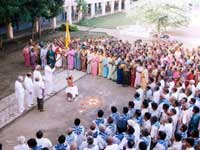 Imagine the consequences of such an event. The very numbers implied a system operating on the edge of chaos…with every possibility of things going wrong: stampedes, public health disasters, and deaths by drowning. Moreover, majority of the devotees who came there belonged to the poorer sections of the society; with just a pair of clothes, little for their food and a bounty of faith! The government, of course, did its best to organize this mega event. But it had its own limitations as far as the resources and manpower was concerned. This was where many voluntary groups swung into action and foremost on the list was the Sri Sathya Sai Seva Organization of Andhra Pradesh.
Imagine the consequences of such an event. The very numbers implied a system operating on the edge of chaos…with every possibility of things going wrong: stampedes, public health disasters, and deaths by drowning. Moreover, majority of the devotees who came there belonged to the poorer sections of the society; with just a pair of clothes, little for their food and a bounty of faith! The government, of course, did its best to organize this mega event. But it had its own limitations as far as the resources and manpower was concerned. This was where many voluntary groups swung into action and foremost on the list was the Sri Sathya Sai Seva Organization of Andhra Pradesh.
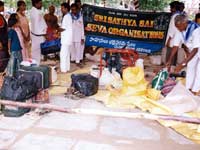 On the 29th of July, 2978 volunteers of the organization gathered at the Sathya Sai Gurukulam at Rajahmundry and made a commitment to unto themselves: ‘We shall see SAI in every pilgrim we encounter and serve him/her to the best of our capacity’. Several months of planning had gone into this event. All the raw materials were ready. Three buses and four trucks were in place, ready for use. Every volunteer was given specific duties at specific locations. The service was to be rendered in turns by batches of thousand volunteers (600 men, 400 women), for a period of four days each.
On the 29th of July, 2978 volunteers of the organization gathered at the Sathya Sai Gurukulam at Rajahmundry and made a commitment to unto themselves: ‘We shall see SAI in every pilgrim we encounter and serve him/her to the best of our capacity’. Several months of planning had gone into this event. All the raw materials were ready. Three buses and four trucks were in place, ready for use. Every volunteer was given specific duties at specific locations. The service was to be rendered in turns by batches of thousand volunteers (600 men, 400 women), for a period of four days each.
Taking the name of SAI, the volunteers plunged into service. One could see SAI volunteers wherever one went. As soon as one walked into bus terminals and railway stations, volunteers offering service in the free cloakroom facility welcomed them. There were others who gave guidelines on how to reach the bathing ghats. The volunteers were there near the bathing ghats too, maintaining cleanliness and helping the old and the disabled to take a dip. They took care of the children when the parents went for their holy dip. They prevented stampedes by helping police maintain the queue.
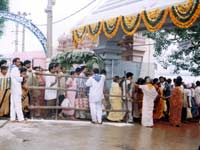 There was no outbreak of any kind. Volunteers supplied pure drinking water, carrying water tanks on their backs. Medical camps were organized on the banks to tackle any health problems. Others were seen cleaning the river water of the offerings that the devotees made. Some others were busy elsewhere preparing large quantities of food, which was given away in the form of packets, free of cost, to the pilgrims everyday. The total number of packets given in these twelve days was a staggering 3,27,750!
There was no outbreak of any kind. Volunteers supplied pure drinking water, carrying water tanks on their backs. Medical camps were organized on the banks to tackle any health problems. Others were seen cleaning the river water of the offerings that the devotees made. Some others were busy elsewhere preparing large quantities of food, which was given away in the form of packets, free of cost, to the pilgrims everyday. The total number of packets given in these twelve days was a staggering 3,27,750!
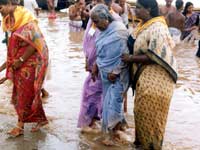 The numbers would surely have impressed you too. But there was also quality to this quantity. The pilgrims and the newspapers were all praise for the wonderful service rendered by the Sathya Sai Seva Dal. In response to all this one of the young volunteers from Rajamundry remarked, ” We only pray that this little act of serving His devotees, has pleased Bhagwan!”
The numbers would surely have impressed you too. But there was also quality to this quantity. The pilgrims and the newspapers were all praise for the wonderful service rendered by the Sathya Sai Seva Dal. In response to all this one of the young volunteers from Rajamundry remarked, ” We only pray that this little act of serving His devotees, has pleased Bhagwan!”
Not many of us get a chance to serve the Lord directly…but a service to those who seek Him, is by itself service unto Him!
JAI SAI RAM
Dear Readers…
If you have stories from your land, where your people have touched the lives of others in any little way through their service and love…let us know about it.
We seek your inspiration on this path, too!
Home of Love - Kenya
KENYA
 SAI SPIRIT OF LOVE CHILDREN’S HOME TRUST is a project which started from Sathya Sai Baba Centre of Dwaraka Maayi, Nairobi – Kenya affiliated to Sri Sathya Sai Seva Organisation in Prasanthi Nilayam, India since 3rd July 1999.
SAI SPIRIT OF LOVE CHILDREN’S HOME TRUST is a project which started from Sathya Sai Baba Centre of Dwaraka Maayi, Nairobi – Kenya affiliated to Sri Sathya Sai Seva Organisation in Prasanthi Nilayam, India since 3rd July 1999.
Several devotees founded the Trust on 10th March 1997 with the aim of helping children in need in Kenya. The Trust has currently five trustees representing the three main ethnic races of Kenya (African, Asian and European).
The main project supported by the Trust is a home for destitute children in Uthiru, on the outskirts of Nairobi,  called Sathya Sai Home. Started in 1995 by a Kenyan teacher who was moved to give food and shelter to a few children who had nowhere else to go and were in desperate circumstances,the home now gives shelter, food, clothing and education both spiritual and academic to fifty resident children.
called Sathya Sai Home. Started in 1995 by a Kenyan teacher who was moved to give food and shelter to a few children who had nowhere else to go and were in desperate circumstances,the home now gives shelter, food, clothing and education both spiritual and academic to fifty resident children.
 Rehabilitation of these children was mainly achieved by singing Sai Bhajans and Sathya Sai Education in Human Values.The fifty six resident children who benefit from this project range in age from 7 years to 18 years and are all now receiving formal education. Eighteen are attending the local Government Primary School; three are studying under scholarship at a Nairobi Secondary School.
Rehabilitation of these children was mainly achieved by singing Sai Bhajans and Sathya Sai Education in Human Values.The fifty six resident children who benefit from this project range in age from 7 years to 18 years and are all now receiving formal education. Eighteen are attending the local Government Primary School; three are studying under scholarship at a Nairobi Secondary School.
In addition, there are two boys who have graduated from the home and live outside but attend Secondary School under scholarship.
A Sathya Sai primary school was started in January 1998 to cater for the younger ones. Since then a class has been added every year and the school now offers education up to  standard VI.
standard VI.
Of the children who have already outgrown the home, one is now married with a child and another four are working, one of them in a shop belonging to a devotee. Twenty children have already left the Home and are now integrated into society.
Education is relatively expensive in Kenya, given the high level of poverty. As well as catering for the education of the resident children, Sathya Sai School offers day school facilities to poor children from the neighborhood who would otherwise have  no schooling at all. Currently about 150 such children are given this opportunity. This helps to create a bond between the home and the community.
no schooling at all. Currently about 150 such children are given this opportunity. This helps to create a bond between the home and the community.
The Sathya Sai School follows the official Kenya curriculum but Sathya Sai Education in Human Values is interwoven into all academic subjects and is a vital part of all activities.
There are two doctors, who are giving free service to anyone involved with the project. A child with Leukemia and another with Tuberculosis were given the best hospital care available by one of these doctors, who is in charge of one of the wings at the main Government hospital in Nairobi. During this time other devotees visited and attended to the children regularly.
Devotees visit the home/school at least once a week and render various services. Among these services the  following are given: Sai bhajan teaching, Sathya Sai Education in Human Values teaching, Balvikas and Youth activities. A child from the Sathya Sai Home who is in secondary school is currently giving extra tution in Maths and English on a voluntary basis to the other children.
following are given: Sai bhajan teaching, Sathya Sai Education in Human Values teaching, Balvikas and Youth activities. A child from the Sathya Sai Home who is in secondary school is currently giving extra tution in Maths and English on a voluntary basis to the other children.
The headmaster of the Sathya Sai School is a Kenyan University Graduate who was sponsored by the Trust to the African Institute of Sathya Sai Education in Ndola, Zambia for the three month Diploma Course in Education in Human Values. The Trust also sponsored him  to receive his diploma from Swami’s hands in Puttaparthi in 2001.
to receive his diploma from Swami’s hands in Puttaparthi in 2001.
The children at the Sathya Sai Home sing Sai bhajans every Saturday. They are asked quite often to sing Sai bhajans in different functions in Nairobi.They also act as Seva Dals whenever there is a seminar, workshop or other Sai activity.The children also take part in many plays organised by the Sathya Sai Baba Centre of Dwaraka Maayi.
 The home and the school give the chance to many devotees to give their Love in the form of voluntary service to this project.
The home and the school give the chance to many devotees to give their Love in the form of voluntary service to this project.
Karjat Water Project - Pictures & Press Releases
Aritra Bhattacharya Reports..
Mumbai, April 24: For years, the villagers of Burujwadi trekked up a hill to return with pots of water on their heads as the searing heat scalded their feet and the dust filtered their vision.
On the foothills of Matheran, around 90 km from Mumbai, these villagers never believed the routine could change.
Children ogling swank cars kicking up dust trails, people living in extreme penury, making Rs 20 to Rs 25 a day: You can’t escape the similarities with Chandipur in Swades.
And true to the script, Burujwadi’s residents along with six other adjoining villages outwitted the odds and brought water to their doorsteps with a water harvesting facility they built themselves.
“Tankers were alloted to supply daily water to our villages in April and May—they actually turned up only twice or thrice a week,” says Hari Yurupirkar, another Burujwadi local.
So while Shah Rukh Khan played facilitator in Swades, the Satya Sai Baba Trust in Mumbai replaced him in real life, inaugurating the harvesting apparatus on April 18, with funding from HDFC Bank.
Yurupirkar’s fellow villagers worked eight long months, even making the bricks in the local kiln. The pay-off has been the sweet taste of running water—the project brings water to 1,200 villagers across seven villages.
The project essentially comprises a 17-ft-high bund that holds back rain water, a pump to carry the water to a 90,000-litre tank on a hilltop and 13 distribution points with three taps each.
Incidentally, it was the villagers who first approached the Sai Baba Trust in neighbouring Dodani Village, where it runs a primary school.
Back at the inauguration, the locals didn’t turn up and the corporate guests wondered where they were. Where were they on the big day? Getting dressed for the occassion.
When they emerged, the women had flowers on their heads and the children went straight for the water.
Underlining the festivities though, was irony. The Morbi dam, built on land emptied of villagers and under construction for over 10 years now, will actually supply water to the urban sprawl of Navi Mumbai.
“The government hasn’t even paid us for the land it has taken away to construct the dam,” says Vishu Kewari, sarpanch of Burujwadi.
For now, though, Burujwadi has built itself the opportunity to dream.
“We can probably start a broom-making business now,” says Kamal Bhasma, Ambewadi’s lady sarpanch of the womenfolk, as she looks appreciatively at the water gushing out of the taps.
Karjat Water project
This Water project involves the supply of water to 5 villages, which could also lead to seven if plans are finalized. The names of the villages are (1). Burujwadi (2) Dandwadi (3) Tepajiwadi (4) Chinchachimalo (5) Nimbarwadi.
All these villages are on the Karjat side of Karjat hills and are at a height of 2500 feet from the sea level, roughly about 88 Kms from Mumbai. All the villages are severely in need of water during the summer period of three months and have to trek and carry water from the bottom of the hill to height of 2000 feet daily for their daily water need.
Burujwadi: This is the main village at a height of 2000 to 2500 feet above the water source point. The number of houses in this village is about 55 with almost 7 to 8 people in each, which works to a population of 450 approximately.
Dandwadi: This village is next to Burujwadi at a distance of 1000 feet. The number of houses in this village is 16 and population works to around 145 odd.
Tepajiwadi: This village is at a distance of 900 feet from Dandwadi. The number of houses in this village is 14 and the approximate population is 120.
Nimbarwadi: This village is at a distance of 1100 feet from Tepaji wadi. The number of houses in this village is 40 and a population of 360 odd.
Chinchachimalo: This village is at a distance of 1600 feet from Nimbarwadi. The number of houses in this village is 45 and a population of 400 odd.
PLAN
The plan to successfully complete this project meaningfully will be as follows.
To enhance the already existing source of water which is a well, either by rain harvesting or integrating it with an additional bore well to ensure sufficient water supply for a the villages.
To fit a heavy water pump of almost 3 phase 10 HP so that it can take care of supplying water at a head of 2000 feet and a distance of almost 3800 feet. Here again we will require taking expert opinion before we finalise on the rating and capacity of the pump to suit the terrain. HDPE and GI pipes will be required to connect the source to the top tank and from the tank to the different platforms constructed in the five different villages.
A massive RCC reservoir tank of almost 45000-liter capacity to store and facilitate distribution to the respective villages.
Electrical connection is available till the source but the sanctioning of power and meter boxes with its connecting accessories will have to be taken care of for the water pump.
Any necessary permission from the Tahasildars office and Gram panchayat will have to be taken with the help of the villagers and the local Sarpanch and Upasarpanch.
The above mentioned plan is further elaborated and examined in detail in the following passages wherein a detailed schematic diagramme is also given
SOURCE
There is an already existing water source, which is a well at the bottom of the foothill having a dimension of 23 feet in diameter and almost 30 feet in depth. This source gets dry by the mid summer time and there is need to harvest water in this well to sustain it throughout the summer. There is also a possibility of going in for a bore near by to integrate with the existing water source and thereby be sure to supply the much-needed water to sustain all the five villages through out the year. Experts such as geologist and rain harvesting experts will have to be taken to the site to get a thorough report and feed back of the plan of action, which will be most practical and economically viable.
W– Well
WATER PUMP AND ELECTRICAL SUPPLY REQUIRED
The total head from the source of water to the proposed water tank reservoir would be approximately 2000 feet and at a distance of 3800 feet. The initial 1200 feet has a steep gradient and thereby has a gradual gradient upto the water tank reservoir. There is an electricity pole very close to the well and all that is required from the MSEB will be the sanction of almost 10 HP of power. The MSEB officials may decide the cable and extension from the pole to the well after we duly apply for the power. MSEB official will have to be taken over there to get an estimate and time required to finish the project.
VILLAGE TOPOGRAPHY
The distance between each village and its terrain is explained below. From Burujwadi to Dandwadi is about 1000 feet. There is a slight dip in the terrain, which again goes up and ends in the village. The proposed site for the water tank is in between Bujurwadi and Dandwadi and is at a height of 300 feet head and a distance of 1000 feet from Burujwadi. From Dandwadi to Tepajiwadis around 900 feet wherein there is a dip and climb between the two.
From Tepajiwadi to Nimbarwadi is 1100 feet and from Nimbarwadi to Chinchachimalo is 1600 feet. Here again there is a dip and climb between the two villages.
ADVANTAGE
The added advantage in doing a project wherein five villages together is benefited is not just the economics wherein the overall cost and effort is reduced but also the number of people benefited and the message that gets thru to a compete belt. The awareness towards Baba is already on the growth and this project will definitely help in cementing the belief on the gram seva programme to bring more and more people into Swamis fold and prove to them by example Swamis principle and message.
| COST ESTIMATION | |||||
| Sr No | Item | Qnty | Unit | Rate/Unit | Amount |
| 1 | Cement | 3000 | 50 kg/bag | 145 | 435000 |
| 2 | Bricks | 40000 | Nos | 1.5 | 60000 |
| 3 | Sand | 74 | brass | 2000 | 148000 |
| 4 | Rubble | 10 | brass | 800 | 8000 |
| 5 | Steel | 3760 | Kgs | 30 | 112800 |
| 6 | Recron Fiber Mesh | 595 | Packets | 22 | 13090 |
| 7 | Water Proofing Powder | 1095 | Kgs | 15 | 16425 |
| 8 | Tank Cover | 2 | nos | 1500 | 3000 |
| 8 | Metal | 104 | Brass | 1200 | 124800 |
| 9 | Shuttling & Reinforcement | 1 | 25000 | 25000 | |
| 10 | 11 GI Sheet & Angle | 1 | Nos | 10800 | 10800 |
| 11 | Up take pipes | ||||
| 12 | GI – 2 1/2″ | 200 | mtr | 220 | 44000 |
| GI – 2″ | 250 | mtr | 200 | 50000 | |
| GI – 1 1/2″ | 500 | mtr | 171 | 85500 | |
| GI – 1 1/4″ | 250 | mtr | 148 | 37000 | |
| 13 | Down take pipes | 200 | mtr | ||
| GI – 2″ | 1000 | mtr | 200 | 40000 | |
| GI- 1 1/2″ | 1000 | mtr | 171 | 171000 | |
| HDPE – 1 1/4″ | 500 | mtr | 40 | 40000 | |
| HDPE – 1 “ | 300 | mtr | 28 | 14000 | |
| HDPE – 3/4″ | 22 | 6600 | |||
| 14 | Other Pipe Fittings | 50000 | |||
| 15 | PUMP 15 HP & PANELS ETC | 50000 | |||
| 16 | MSEB DEPOSITS ETC | 1000 | rft | 50000 | |
| 17 | GI Pipe Railing & MS Channels | 50 | 80000 | ||
| 18 | Mixer vibrator rentals | 40000 | |||
| 19 | JCB & Dumper rentals | 20000 | |||
| 20 | Skilled Labour & Supervision | 30000 | |||
| 21 | Missalaneous | 35000 | |||
| Total | 1800015 | ||||
This estimate covers the following scope of work :
- Construction of Bund
- Construction of Pump House
- Installation of Pump
- Uptake & Down take Pipleines
- Construction of Water Tank of capacity 63000 Liters
- Construction of Water Outlets at different points
PICTURES OF INAUGURATION CEREMONY
The Karjat Water Project – Glimpses
Photographs taken on the Inauguration of The Karjat Water Project on 18.04.2005 at Burujwadi/Pokharwadi Village, Karjat executed by Sri Sathya Sai Seva Organisation (Maharashtra & Goa). The above said Project was sponsored by HDFC Bank
Bhagavan Sri Sathya Sai Baba instructed that this water project must be inaugurated on 18.04.2005 on the auspicious Ramanavami Day.
| ||
| ||
| ||
| ||
| ||
| ||
Water is the lifeline for human life. While most people in the urban areas take clean and pure drinking water for granted, there are many villages in the country, where availability of drinking water is a luxury. The cluster of villages at the foothills of Matheran is one such place. These villages have abundant rainfall but due to poor conservation techniques they face severe shortage of water post monsoon. The villagers are compelled to trek almost 3-4 kms to fetch water.
The Sri Sathya Sai Trust Maharashtra, a service oriented spiritual organization, inspired by the monumental humanitarian work of Sri Sathya Sai Baba,’undertakes many public service projects across the state of Maharashtra.
The water project for Adivasi villages located at the foothills of Matheran is one such project, which gives an excellent example of how various organizations can come together and achieve great things for greater good and upliftment of the poor & the needy.
This project has been fully funded to the tune of Rs.18 Lakhs by the HDFC Bank Ltd. which is the leading private sector bank in India providing a whole range of banking solutions covering both commercial and investment banking on the wholesale side and transactional / branch banking on the retail side. It is the bank’s wholehearted support, which has aided the quick and successful implementation of the project.
This project is one amongst the myriad social responsibility missions taken on by HDFC Bank to serve humanity. The fundamental teaching of Sri Sathya Sai Baba which is “Love All Serve All, Help Ever Hurt Never” and the HDFC Bank’s caption “We Understand Your World” has brought the synergy of Love & understanding resulting in manifestation of this project.
This project will cater to 7 villages and will provide water to more than 1200 villagers. A Bund is built which will conserve the water and will supplement the well, which acts as the permanent source of water throughout the year. A submersible water pump of 15HP is installed which will pump the water to the height of 120 meters on the hillock. HDPE pipeline measuring approximately 5 Kms has been laid which will carry the water to the Water Storage tank. The capacity of the storage tank is 90,000 litres which is built on the hillock. There are 14 water distribution outlets built, which will provide cool pure drinking water to the villagers at their doorstep.
KARJAT WATER PROJECT – PRESS RELEASES
April 19, 2005 – The Free Press Journal, Pg 15, ‘Joint efforts of HDFC Bank and Sri Sathya Sai Trust make 7 tribal villages ‘free from water scarcity‘.
April 19, 2005 – The Times of India, Pg 6, ‘Finally, Water on Taps‘
April 21, 2005 – Navbharat Times, ‘HDFC Bank – Sathya Sai Trust Water Project Inauguration‘.
April 21, 2005, Saamna, ‘HDFC Bank – Sathya Sai Trust Water Project Inauguration‘.
April 25, 2005 – Indian Express, ‘Water from Dust‘.
April 26, 2005 – Loksatta, ‘HDFC Bank – Sathya Sai Trust Water Project Inauguration‘.
A Unique Contribution for a Noble Cause – Water for Adivasi Villages
Water is the lifeline for human life. While most people in the urban areas take clean and pure drinking water for granted, there are many villages in the country, where availability of drinking water is a luxury. The cluster of villages at the foothills of Matheran is one such place. These villages have abundant rainfall but due to poor conservation techniques face severe shortage of water post monsoon and the womenfolk have to trek almost 3-4 km for fetching drinking water daily.
The Sri Sathya Sai Trust Maharashtra is a service oriented spiritual organization, inspired by the monumental humanitarian work of Bhagwan Sri Sathya Sai Baba, undertakes many public service projects across the state of Maharashtra. The water project for Adivasi villages located at the foothills of Matheran is one such project, which gives an excellent example of how various organizations can come together and achieve great things for greater good and upliftment of the poor & the needy.
This project has been fully funded to the tune of Rs. 18 Lakhs by the HDFC Bank Ltd. which is a leading private sector bank in India providing a whole range of banking solutions covering both commercial and investment banking on the wholesale side and transactional / branch banking on the retail side. It is the banks wholehearted support, which has aided the quick and successful implementation of the project. This project is one amongst the myriad social responsibility missions taken on by HDFC bank to serve humanity.
The fundamental teaching of Sri Sathya Sai Baba “Love All Serve All & Help Ever Hurt Never” and the HDFC Bank’s caption “We Understand Your World” has brought the synergy for this project to manifest serving the poor Adivasi villagers.
This project will cater to 7 villages and will provide water to more than1200 villagers. A Bund is built which will conserve the water and will supplement the well, which acts as the permanent source of water throughout the year. A submersible water pump of 10HP is installed which will pump the water to the height of 120 meters on the hillock. HDPE pipeline measuring approximately 5Kms is laid which will carry the water to the Water Storage tank, which has the capacity to store 90,000 liters, is built on the hillock. There are 14 water distribution outlets built which will provide cool pure water to the villagers at their doorstep.
The project is at the final stages of its completion and is scheduled for the inauguration on the auspicious occasion of Ramnavmi which falls on 18th April 2005.
Little Drops of Water
Little drops of water make a mighty ocean. Little acts of service make a huge difference. Like the one our Sai brother from Bangalore is doing. Inspired by the mammoth drinking water projects that Swami gifted to Ananthapur, Medak, Mehaboobnagar and now to Chennai, this devotee too decided to do something in his capacity to solve the drinking water problem of Bangalore slum dwellers. He runs a water supply tanker to the slums and gives them pure drinking water free of charge! Just think what a different place this world will be if each one of us chipped in just a bit to help our less privileged brethren !As Swami says, it is the quality of service that is important and not the quantity. And where there is good intention, there is help from GOD!
So, get started today! Help someone in need! Give them a sweet smile and a kind word! That too is service!




Looking Beyond Disabilities
On 6 September 2003, many Sai centres along with Sai youth organised a ‘Day at the Beach’, in Southern California, for over 50 physically and mentally disabled children and adults. Nearly 125 volunteers participated in this project, bringing joyful smiles to the faces of these children. Owing to their disabilities, these children do not enjoy a normal childhood; some of them had never been to the beach before. Swami often reminds that ‘self-confidence’ is the very foundation on which the mansion of human life is built. Inspired by the vision of “looking beyond disabilities, focusing on capabilities, expanding possibilities”, the entire day comprised of therapeutic projects involving music, dance, human values songs and games aimed at helping the children express their innate God-given abilities. Here are some photographs…..
Love in action - Grama Seva 2004
It all started suddenly and most unexpectedly. Swami came as usual in his golf cart to the verandah on the afternoon of 15th October, 2004. He stopped His cart on the outer verandah and was engrossed in the Veda chanting. Suddenly He gestured to Prof. Anil Kumar, who went up respectfully and listened to what He had to say. One could see that Prof. Anil Kumar’s natural enthusiasm was growing and he seemed to be fairly bubbling with exuberance as he went up to the mike to make the important announcement that Swami has blessed that the Grama Seva start in 2 days time.

Prof. Anil Kumar announcing the Grama Seva Plans on Oct 15
Things began moving rapidly. Soon people realized that much had already been accomplished. God always works silently and most efficiently. Everything was already in place for the Grama Seva to begin and no one was even aware of it. A sufficient quantity of laddus had already been prepared for the initial distribution. All the ingredients for the Prasadam preparation and the clothes for distribution had already been procured and the infrastructure was well in place even before the announcement was made!
The faculty and staff of the Institute quickly organised themselves for the Seva. Steering and planning committees were formed. The boys and the staff from the Puttaparthi and Brindavan College campuses as well as the Puttaparthi High School students were divided into 6 groups with an A and a B section in each group. Thus the A section of all the 6 groups would go for Grama Seva one day, while the B section would go the following day. This not only provided a day of rest, but also the boys staying back ensured that the Mandir activities, like Veda chanting for the Dasara festival, leading the Bhajan singing in Sai Kulwant Hall, and the afternoon programmes went on simultaneously and were not affected at all!
Each group going for the Grama Seva had 4 trucks for transportation along with a tractor for the heavier loads. All the 24 vehicles and 6 tractors were connected through a mobile communication facility with each other and a ‘home base’ that provided updates as well as kept track of the progress of each group. This helped them anticipate and respond well to emergency situations like shortage of clothes or Prasadam and respond to vehicle breakdowns. Each vehicle also had a uniformed policeman to provide security to the convoy, and to have a salutary effect by his presence and prevent any untoward incidents. In addition there were 2 SUVs (Sports Utility Vehicles) used by two of the project coordinators, assisted by a couple of students, who visited multiple sites between them to co-ordinate the distribution better. This system of 32 vehicles was the lifeline that helped the Grama Seva move forward smoothly and efficiently.

The convoy of vehicles loaded and ready to roll
A daily schedule was drawn up outlining the villages to be visited for the day and allocating each of the 6 groups with the villages to be visited by them based on the population and the number of houses in each village. An estimate of the food to be loaded in each vehicle was thus arrived at from these figures as well as the food for the students doing the distribution. This was rolled up for all the vehicles to arrive at a “master production plan” for the number of packets of Prasadam to be distributed each day. Excess food was also loaded for contingencies and also to distribute to the poor people along the way. A sari and a dhoti for each household in each village to be visited for the day, also had to be planned for and loaded properly in each truck.
The Prasadam that was distributed to each person was a food packet of pulihora or tamarind rice and a laddu, a sweet in the shape of a small ball. The girls of the Anantapur campus had perhaps the more difficult task. They did most of the ‘behind the scenes’ work like the rice packing and the laddu preparation. The girls came up with a schedule so that they could start by early evening working through the night in shifts, so that the food packets were ready for loading into the trucks in the wee morning hours making the vehicle ready for an 8:30 a.m. departure. They not only toiled through the night but also attended both the morning and afternoon Darshan and Bhajans in Sai Kulwant Hall. Theirs was truly a spectacular effort and we salute all of them.
In a day about 12 to 15 villages were covered by the 6 groups and the students knocked at the doors of 5,000 homes to share Swami’s Prasadam and love with the residents. Thus over 20,000 packets of Prasadam were distributed each day. This snippet of statistic is provided just to give an insight to the magnitude of the project, but statistics don’t tell the full story. The Grama Seva is essentially a love story; a story of the compassion of our dear Lord for the inhabitants of the villages, who depend only on Him.

Trying on the Tee-shirt under His loving gaze
On the morning of the 16th October there was another announcement. Swami said that tee shirts and caps would be distributed to all the students and staff members so that they could wear it and go for distribution the next day, chanting the Sai Gayathri. The packets of tee shirts were brought out and stacked in a pile in front of the verandah and a shirt was first shown to Swami. The white coloured tee shirt had the Institute emblem embossed on the front left side and the words LOVE ALL SERVE ALL on the back of the shirt, in red. After looking at the shirt Swami called a student and asked him to try the shirt on. The student immediately put the tee shirt on, over his regular white shirt. It was a tight fit. Swami asked that a larger size shirt be brought, personally inspected it to make sure it was now the right size and then gave it to the student and asked him to put it on. When the shirt fit correctly, Swami broke into a broad smile of motherly affection and love. He sat on the verandah for a long time that day listening to the Veda chanting and looking lovingly at all the boys who were eager to begin His work the next day.

This is where we are going today
Generally the daily schedule used to follow a more or less set pattern. After giving Darshan in the morning Swami would come to the verandah and would generally ask a staff member where they were going for the day. The staff members would be well prepared to brief Swami with maps and a list of villages that they intended to visit that day. It was a real sight to see Swami pouring over the maps along with the staff members and asking relevant questions to make sure that nothing had been missed out. Swami would then give His Divine Blessing for the day’s distribution. At that point, two students would bring the food out in buckets to be blessed by Bhagavan and the sanctified food (Prasadam) was now ready for distribution!
Soon the boys scheduled to go that day, either section A or B, would leave Sai Kulwant Hall and rush to put on their shoes and collect their hats etc. and hurry to their designated trucks. The boys remaining in the Mandir would continue with the Veda chanting so that the Mandir activities were not interrupted.

Blessing the food for the days distribution
The trucks numbered 1 to 24, the 6 tractors (numbered T1 through T6) and the two special vans, were lined up in a numerical sequence along the main road of the Ashram starting from the Gopuram gate and extending up to and beyond Shanti Bhavan. These trucks had already been loaded by the recently graduated alumni in the wee hours of the morning and were all ready to go. A quick inventory was taken to ensure that the truck had been stocked correctly, a quick headcount and everything was ready to roll.
When everything was accounted for, the coordinator gave the signal and the convoy started to go out slowly. As each truck reached Sai Kulwant Hall a resounding chant of ‘Bhagavan Sri Sathya Sai Babaji Ki Jai‘ rang out, and the long convoy slowly wound out of the Ashram like a long snake. They did not go far though. Only up to the Institute Hostel, where they made a ‘pit’ stop. This is where they collect goodies for the students (usually biscuits, chips or potato patties and a fruit) so thoughtfully provided by Mother Sai, and cans of drinking water. A can of majiga, or spicy buttermilk, one for each truck, is also loaded, and thus equipped, the convoy moves out bringing Swami’s love to the countryside!

Nagarsankirtan in Puttaparthi on Day
The first two days of the Grama Seva was concentrated around Puttaparthi and the adjoining villages. October 17th, the day one of the distribution is centered on Puttaparthi, up to and including the Chitravathi Road. The boys walk up in Nagarsankeertan up to the village, starting around 10:00 a.m., followed by the trucks with the food, after the end of the morning’s programme of the first day of the Saptaha Yagna in Sai Kulwant Hall. Puttaparthi is home for most of the boys so they experience no real problems and the distribution moves fast.
The next day the action moved to the adjoining villages like Brahmanapalli, Kovillaguttapalli, Gokulam and so on. In the morning, around 8 a.m., the coordinators asked permission to leave so that they could start and finish the distribution early. Swami remarks that all the villages are close by so where is the need to hurry? Only then we realise that it being a Monday, Rahukalam was from 7:30 a.m. to 9:00 a.m. We had forgotten, but He had not! At 9:20 a.m. Swami’s blessing is obtained and the boys hurry out eager to get started and come back in time for Swami’s Dasara Discourse in the afternoon.
At each of these villages the roads have been washed clean and welcome banners strung up. The washed roads are decorated with floral patterns and all the boys are welcomed as if they were welcoming Swami Himself! The boys are touched. The planning and coordination has been fine-tuned after 4 years of Grama Seva so everything proceeds like clockwork without any hiccups. Some of the villages have a sizeable Muslim population. So more often than not the response to our “Sai Ram” is a “Salaam Alaikum“. The Muslims also eagerly accept Swami’s Prasadam coming as it does during the month of Ramazan, the most holy month for the Muslims. Truly, Swami’s love knows no boundaries. After 2-3 hours almost everyone is finished, tired from the unaccustomed labour in the Sun, but elated also at having done His work satisfactorily.
From now onwards the distribution has to move further afield. The trucks have now to take the road less travelled, most of the time over dirt tracks, to reach remote villages and distribute under trying conditions. I decide to hitch-hike a ride on one of the trucks and accompany the boys so I could take some photographs and experience the Seva first hand. Please join me on my journey??
October 19th, I join Group 3 which is distributing to Venkatagaripalli village. It is a big village with a sizeable population, so half the group (i.e. 2 out of the 4 trucks) is assigned to this one single village. My truck is mostly full of Brindavan boys with some Brindavan teachers. We leave a little after 9 a.m., as the village is quite near. We soon take a turn off the main road, on the diversion to the village. The villagers walking along the dirt track all say “Sai Ram” to us as we lurch along. The boys all call back “Sai Ram” in unison. Soon the truck in front of us comes to a stop rather suddenly and we wonder if we have reached the village. We peer out but no huts are seen. A teacher gets down hurriedly from the lead truck and is seen negotiating with a village woman. He buys a basketful of freshly plucked guavas. He must have been a good negotiator for he gets it relatively cheap at Rs 100.00. All the boys are happy at the prospect of eating some garden-fresh guavas.

Being welcomed with bhajans at Venkatagaripalli village
In a few moments we reach the village to a heartwarming sight. The village is well decorated with buntings and pictures of Bhagavan. The streets have been nicely cleaned. And all the villagers are waiting to welcome us at the village entrance and start singing Sai Bhajans as soon as our buses are sighted. The boys all hop off the bus and join the singing. A couple of teachers in the meantime go ahead to scout the village and plan the distribution strategy. After we sing Bhajans for a few minutes, the villagers do Arathi to Bhagavan’s picture in the front of the bus. And now we are ready to start the distribution.
The village “main road” is rather long and houses and huts are laid out on both sides. The road is quite narrow and the trucks would not be able to negotiate it easily. So the thoughtful villagers provide us with a bullock cart to help us transport the Prasadam packets from the trucks at the village entrance up to the current distribution point. One of the more enterprising boys hops onto the cart and takes charge of the bullock cart loading operation.
The boys break up into sub-groups. About 8-10 boys are assigned to a teacher and the distribution area is well coordinated between the sub-groups so that there is no duplication or overlap. The 8-10 boys in each group all have different tasks. 2 boys carry the crate containing rice Prasadam packets. One or two boys carry the plastic bags of laddus. One boy carries the bundle of dhotis and another boy carries the bundle of saris. The remaining boys and the teachers act as Swami’s messengers to hand over His Prasadam to the villagers.
The modus operandi of the distribution is quite simple. We knock at a house and politely say, “Sai Ram” with folded hands. Then we tell the villagers that Swami from Puttaparthi has sent some Prasadam for them. We ask them for the number of inmates in each house and hand over the requisite food packets and laddus to them. Some of them accept it in their hands. Some nip back in to get a plate and some ladies accept the food in the folds of their sari in the rural fashion. Quite a few of them touch the food to their eyes in a gesture of respect to show their thanks at Swami’s immense grace. The teacher or designated elder then hands over the sari and dhoti to the elder in the house. A small picture of Swami is also given to each household.

A bullock cart pressed into service in Venkatagaripalli village
When the crates of food or stack of clothes is getting low, the boys act as runners and rush up to the bullock cart which is somewhere along the main road (so as to be equally accessible to all groups) to get replenishments. It is demanding work and the boys are soon sweating from the morning sun, but the distribution is proceeding fairly fast. They get a break when the bullock cart has to go back to the truck to get additional supplies.
Whenever we come to a fork in the road, the lead group decides to take a path and posts a lookout to inform the groups following them as to which areas they are going to cover. A teacher brings up the rear (behind all the groups) to ensure that no house has been left out.
I am busy taking pictures of the village scene and the distribution but soon have a sizeable crowd of small kids following me. I now feel like the Pied Piper of Hamelin, with the kids going wherever I lead. I find out from them that their village school has closed for the day as we were coming down to distribute Prasadam, so the whole village wears a festive look. The kids all clamor for a photograph, so I oblige them. I then ask them to go and wait in their respective houses to receive the Prasadam when we come to their doorstep.
For most of the students this is their first visit to a village. Some of them are surprised at the number of people living in such small houses and under such spartan conditions. But all of them appreciate the villagers’ warmth, their spontaneous simplicity and devotion to Bhagavan.
The village itself is very clean and as is true of all villages in India, is full of domesticated animals that roam freely everywhere. Goats, sheep, pigs, cows, hens, stray dogs that growl menacingly and even monkeys, all are well represented. A goat that has just had a couple day old kids catch the students’ fancy and they cuddle the small little goat kids that can barely stand on their four legs.
In about a couple of hours all the groups that have spread out to distribute the food are almost done and we wend our way back to the main entrance of the village and wait for everyone to join us. After everyone is gathered, the villagers want to do Arathi and thus show their thanks to Swami. We again gather around the truck which has a picture of Swami attached to the windshield and the village elders do Arathi. Slowly we say our good-byes to the villagers and the two trucks move out. About a kilometre from the village we stop in the shade of a large tree as we are famished and we tuck into the refreshments and the buttermilk that has been provided. And of course, the fresh guavas.
On October 20th, I join Group 1, and am assigned to Vehicle number 3 that is headed to Satarlapalli village, a village at a distance of just over 45 kms as the crow flies. But the road winds over really difficult terrain so it is estimated that it could take 2-3 hours to reach.
In the morning the coordinators again ask permission to leave early. Swami says “Yes” and so we leave around 8:45 a.m. Group 1 consists of Vehicles 1 through 4 and the assigned tractor (T1). Right outside the Ashram, near the Kalyana Mantapam, Vehicle 1 develops a puncture. It takes a while to get the puncture fixed, as there was a power failure so we could not get the tire inflated. Finally around 10:00 a.m. we are ready to roll. We finally realised that we need to act according to His will and not hurry up so we could be back in time to listen to the afternoon Discourse.
After about 20 kms, while we are in the rural countryside, we had to wait again as Vehicle 2 had an accelerator cable ruptured right in the middle of nowhere. It takes about a half hour but some of the boys manage to repair it with some makeshift wires that are available. The driver of the truck is amazed at their versatility.
I am in a truck with High school boys and a couple of their teachers. The young boys are beginning to feel tired as it is not exactly pleasant travelling in a pickup truck along bumpy roads. At this one of the teachers suggest we play a game. My ears immediately perk up. Memories of many journeys done in my youth come to mind where we played idle games just to “pass the time”. I wonder what kind of games will be played by the boys from the High School, where God-centered education and character building is given so much premium. I was not to be disappointed. The teacher announces that it is going to be a memory game. He said that I will say, “I love Swami”. The next boy will add to this, “I love Swami and Jesus”. And so on it goes, with each boy adding His favourite name of God or a Holy teacher. The trick is to remember the right sequence of names – if you get the sequence wrong then you are out of the game. What a revelation!! A game consisting of names of the Gods just to pass the time. Soon everyone is engrossed, and it becomes quite complex after 8-10 names are added. And of course, lots of fun. Attention is thus easily diverted from the aching body and before we know it we are at the crossroads that would takes us the last kilometre in to Satarlapalli village.

Stopping for refreshments near Satarlapalli village
We wait at the crossroad till all the trucks catch up. It is already 11:30 in the morning so we decide to partake of some of the goodies that Swami has sent. That and the glass of buttermilk refresh everyone and all are now keen to start. While truck 3 goes to Satarlapalli village, the other trucks move on to their assigned villages 3-4 kms further down the road.
We take a diversion and one kilometre of bone-jarring ride on a goat track brings us to this remote, isolated village. We pull up and soon the entire village gathers around the truck. The boys quickly form a line while the group co-ordinator talks to the village head. We go in a Nagarsankeertan from the truck up to the Rama temple in the centre of the village. It has been our experience that no matter how poor and destitute the village is, it still has a neatly maintained temple in the village square. That is why Swami always says that the true Bharatiya culture is to be found only in India’s villages.
All the village kids join us in the Nagarsankeertan and clap wildly to the Bhajans in unrestrained excitement that is the province of the young and truly innocent. The Nagarsankeertan winds its way up to the temple along a very narrow cobbled pathway, avoiding cow and goat droppings and other such items strewn all over the road. At the Rama temple we stop and continue singing Bhajans till it seems all the inhabitants of the village join us. The leader of our group then announces that we have come from Puttaparthi to distribute Swami’s Prasadam and request everyone to wait in their respective homes and that we will come and deliver at their doorstep.
Soon we get organized into 4 small groups and the area of distribution for each group is quickly earmarked after studying the layout of the village. Very soon the distribution is in full swing and the 4 small groups spread quickly in all the 4 directions. I have a difficult time tracking down the next group after finishing taking pictures of one group as they have moved so quickly.
As in the other village I am again surrounded by the kids. These kids are very friendly and take me to the back of the village and proudly show me their village well which is full of water. This is welcome as all the wells in the village which we visited the day before were dry. I take some pictures and the kids are very happy and delighted, just like a tour guide showing off the Taj Mahal to some gawking tourists.

Distributing sarees in Satarlapalli village to people from nearby hamlets
Again another two hours of non-stop distribution and we are done. But we find a number of ladies and gents waiting and clamouring for the Prasadam and clothes right beside our truck. Enquiries reveal that they are residents of hamlets that are close to the villag e. As these people are really poor, we seat them all next to the truck, the 30 odd ladies in front and the 10 or so gents behind. We take a quick inventory and feel that the Prasadam and the clothes would suffice but just barely. We give one sari to each lady and a dhoti to a gentleman, apart from a packet of food and a laddu each. By Swami’s grace, the number of saris is just exactly enough to give to all the women and not one extra sari is left over! Everyone is wreathed in smiles and very happy to have received these tangible gifts of Bhagavan’s love.

In Kodapaganipalli village
We all board the truck and it is time to leave. A pained and embarrassed silence follows, similar to what we experience before the imminent departure of our loved ones at the railway station or an airport. The innocent villagers do not know how to express their thanks to Swami and stand quietly shuffling their legs. The young kids stare at us with their large eyes that say it all. Suddenly on an impulse, I lean out of the truck and extend my hand to the nearest kid and say “Sai Ram”. He immediately takes it and pumps it up and down vigorously yelling “Sai Ram, Sai Ram” at the top of his voice. All the kids now join in and want to shake hands. A little physical touch that enables them to give us a proper send-off. Even the adults hanging shyly in the back, now come forward and jostle each other in their eagerness to shake hands. By now all the students are also hanging out of the truck shaking hands with the villagers. Slowly the truck starts and we leave the village with about 40 kids running behind us shouting “Sai Ram” and waving their hands wildly.

Accepting prasdam with reverence in Yerrapalli village
We take the dirt road back and go ahead to join the other trucks in the group that are 3-4 kms down the road. They are still not done with their distribution and we wait for about a half-hour for them to finish. We compare notes and find that they had got all the little children into the village school and had taught them the Sai Gayathri.

Distributing in a remote house in Cherlopalli village
Soon it is time to go home. We decide to continue ahead and loop back to Puttaparthi from a small town called Pedapalli, rather than retrace our steps back the same way we had come. The road is bumpy but motorable the drivers assure us. We pass through some 3 kms of forest land that is very tranquil and soon reach the town and are back home at around 3:45 p.m. A quick shower and it is immediately to the Mandir and I am gratified to find that Swami’s Divine Discourse had not started yet.

Distributing in Kotalapalli village
And the list goes on. Everyday we visit different villages to different experiences and memories that would last a lifetime. Villages like Cherlopalli, Chendrayanipalli, Kottalapalli, Buchaiahgaripalli and Venugopalapuram.

Arathi at Cherlopalli village
So many memories flood the mind and will remain in the heart for a lifetime. For example, when we were the last bus finishing the distribution in Cherlopalli village and running about 15 minutes behind the others, the villagers ask us to visit their village temple for Arathi. We decide to oblige and trudge back up wearily about half a kilometer to the top of the hill and what did we find – a bigger-than-life size picture of Bhagavan in a temple devoted solely to Swami. Or on the way to Yerrapalli village, when we stop for snacks under a railway bridge and all the students climb up the embankment up to the railway line so I could take their picture. Or the total innocence of the very isolated village of Venugopalapuram where we taught the little school children the Sai Gayathri; or the exquisite scenic beauty of Reddivaripalli, that was situated miles in the interior and surrounded by hills with a deep red soil and thick green vegetation that gave it a surreal look. Above all, the most lasting memory would be of the love and reverence that all the villagers showed us, with no exceptions, as Swami’s emissaries.

Climbing up the embankment on the way to Yerrapalli village
On the way back to Parthi, the excess food packets left over were usually distributed to the people working the fields on both sides of the road. The sight of the villagers running up to the road, sometimes as much as half a kilometer, as soon as our truck with its yellow Grama Seva banner is spotted is a sight that has to be experienced. We always stopped for them and gave them a Prasadam packet and laddus and receive their blessings and good wishes in turn.

Distributing the excess prasadam in Kotacheruvu
And soon we are done, many days ahead of schedule. Immaculate planning and the availability of 32 vehicles enable us to finish the distribution in the targeted mandals (sub-districts) of Puttaparthi, Bukkapatnam and Kottacheruvu – about 142 villages in all.
The boys are tired but very, very satisfied. It has been a soul elevating experience for them. Swami always says that service begets humbleness in a man. And humbleness is perhaps the most important prerequisite on our spiritual path back to God.
And the villagers! Would just a meal and clothing make a real difference in their lives? No, but the very thought that the God in Puttaparthi is looking after them and thinking about them gives them so much hope, nourishment, and love and meaning that the entire exercise has become one of the most rewarding lifetime experiences for all. And it is all just because of His love!!
Jai Sai Ram.
Managing a disaster
The village of Levanjipuram, Tirunelveli district, the state of Tamil Nadu. A tiny hamlet with 200 houses, mostly huts. The time was around 1 a.m in the night on the 24th of January 2004, when the entire village was asleep. One of huts caught a fire whose menacing flames threatened to burn the entire hamlet. The resident of the hut, Mohammed Ibrahim came out shouting for help.
Immediately, four young men swung into action: Jaypaul, Velmurugan, Rajadurai and Perumal. Acting with great presence of mind, they quickly moved and pulled down the thatched roof of the burning house with fire hooks and prevented the fire from spreading.
Apart from this, they boldly moved in and rescued the meager belongings of the resident.
A relieved Ibrahim hugged his saviours and thanked them profusely for saving his only belongings. The village Panchayat too heaped praise on these brave men.
But the heros of our story, in turn, thanked Bhagawan Sri Sathya Sai Baba who had enabled them to be of some service to the village. They had acquired this courage and these skills as part of the nationwide Disaster Management program that has been undertaken by the Sathya Sai Seva Organizations. The aim is to create vibrant, fully trained, well motivated and equipped teams of Sai youth members in each district of India who will move into any natural disaster affected zones within 24 hrs and render seva to minimize the effects and after effects of such disasters.
Making Lives: Service by Sai Alumni
MAKING LIVES:
Service by Sai Alumni
Some time ago, we published an article by Gene Massey about a seva camp run by our old students. In this article, I would like to briefly describe a different kind of seva, once again done by our old students. This seva is different because it is not a one-day affair like most service camps are; rather, it is a continuing and on-going affair. One of these days, we hope to have the leader of the group in our studio and interview him for Radio Sai; in the meanwhile, I could perhaps give a short and broad-brush overview of the wonderful work being done by these old students of Swami. Before I get on to the description, may be I ought to mention that the leader of this team, after graduation some years ago, decided not to seek a job as that would separate him from his mother, who though a working-lady needed help due to a physical handicap. Having decided to stay back to help his mother, this boy then started exploring possibilities to do some additional seva during his spare time, and thus were born the projects that I shall now briefly describe.
The seva activity was launched on 1st January, 2003, and the service group decided to focus on a small village named Kovalaguttapalli. If you walk from the Planetarium towards the Sai Geetha shed, you will see a road turning to the left. That road leads to this village, which is on the bank of the Chitavathi river. There are about 150 families in the village and the main occupations are farming, milk vending, and labour service [as coolies].
The service group set itself three objects which it defines as follows:
· To understand the socio-economic and cultural aspects of village life, and to explore suitable means of improving the welfare and quality of life of the villagers.
· To focus the project so that they target self-sufficiency in food grains, drinking water, health, education, and economic sustenance.
· To render quality work, even while putting into practice the teachings of Swami.
Wanting to do good is one thing and doing it the right way is entirely another. Often, service projects boomerang because of a wrong approach. Not many realise that though villagers are in general quite poor, they have their own sense of dignity. Understanding this, our old boys made a modest and fairly tactful entry. To start with, they just started paying periodic visits to the village and teaching the children there songs composed by Swami. Everyone here 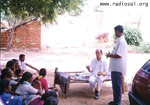 loves Swami, and thus the children were quite eager to learn Swami’s songs. The parents too approved heartily of this assistance. The ice had been broken.
loves Swami, and thus the children were quite eager to learn Swami’s songs. The parents too approved heartily of this assistance. The ice had been broken.
Next step was to tell the children something more, about personal cleanliness, keeping the surroundings neat, prayer, respecting elders, and studying hard. By the way, I should mention that almost all the kids in the neighbouring areas attend Easwaramma School established by Swami many years ago. Once again, all this instruction went very well with the village elders; I mean who would complain if someone came along and taught kids how to be clean, study hard and be respectful to parents? An added attraction was that from time to time, the children were also given food. So, round two also was a success.
Having gained the confidence of the villagers and established their seriousness of purpose, it was now relatively easy for the old boys to start talking to the elders. It started with regular Bhajans, and soon, after the Bhajan session was over, the students started talking about Swami’s teachings. What kind of teachings? Did they give scholarly lectures on Advaitam and stuff like that? Not at all! Being Swami’s students, they know very well how to focus on the relevant, as Swami often had advised them to, when they were students. Thus, their talks were about how parents must save for the welfare of their family.
It is no use giving mere talks about saving money. Something concrete had to be done and a clear road map had to be presented. Thus was born the SARD or SAVE A RUPEE A DAY scheme. Four Self-help Groups were formed, each with about 12 women members. Each group nominated two group coordinators, whose job it was to collect money at the end of every week, and deposit the same in a savings account in the local branch of the Vysya Bank. While the villagers were encouraged to do the money collection, all the required banking assistance was provided by the old boys, including in relation to making deposits and withdrawals. By the end of 30 weeks, the total savings stood at Rs. 30,000/- an impressive sum one must say.
It is not the women alone who received attention and assistance. The men engaged in farming were introduced to a cost-effective method of compost generation. To start with, the farmers were encouraged to regularly collect all easily bio-degradable matter found in the neighbourhood such as dry leaves, twigs, etc. All this was then dumped into special puts dug for the purpose of generating compost. Into these pits were now introduced earthworms of a special type, which were then allowed to multiply. At the end of about 40 days or so, the bio-degradable matter had been transformed by the earthworms into a rich, natural fertilizer. Not only had expenditure on chemical fertilizers been cut, but, more important, a better and more eco-friendly fertilizer had been produced instead. And the yield has gone up too.
Swami often quotes a Chinese proverb that says that it is better to teach a man how to fish than to feed him fish. In this spirit, the students now began to initiate new programs that would augment the family income. The first of these was to train the villagers to make cotton wicks. Now wicks are used regularly in Pujas at homes, and there is a good demand for cotton wicks. The students taught one and all to make the wicks, gave the villagers cotton and packaging material, and finally took the responsibility for the marketing. Sold under the brand name Deepam Cotton Wicks, the wicks are on sale in the shopping centre in Prashanti Nilayam, and believe it or not, the sale is around Rs. 10,000/- a month. Not bad, I would say. By the way, the money is not used up but saved in a bank so that it can grow.
The villagers are now quite enthusiastic and participate actively in all programs initiated by the old students, having thoroughly understood that whatever is being done is entirely for their own good. Thus, every alternate week, a day is set apart for village cleaning. It starts with the children going round doing nagarsankeetan, after which comes the cleaning in which all participate. And when the cleaning programme is over, there is aarathi.
There is always room for more, and the old boys are now exploring the possibility of systematically cultivating a leguminous plant, that is know to grow wildly in the region. The attractive point about this plant is that grows easily in arid regions, and requires very little water. What is important is that the seed of the plant yields oil that can be used as fuel. And the oil cake that remains after the crushing for oil extraction is a very good fertilizer. Project studies are now under way.
This shows how methods of man-management and cost-effective production etc., studied in the Business School can come in handy even in seemingly mundane village affairs! Let me end this heart-warming story with something that is really wonderful. Sometime ago, a farmer lost his cow suddenly. It was apparently healthy all along but mysteriously died and quite suddenly too. The veterinary doctor who was consulted when the cow became very sick was suspicious that it was all due to something that the cow had eaten. So, with the permission of the farmer, he did a post-mortem. What he saw shocked not only him but also all the curious villagers who had gathered around. The cow of the stomach was full of plastic bags that had been discarded as garbage by all and sundry. Promptly, our boys told the villagers, “It is time to get rid of the plastic bags, a major curse of modern times. We will teach you to make paper bags. This will save us from the horror of plastic bags, and incidentally also fetch some income.”
And thus has come into existence another cottage industry. Our boys help in the collection of old newspapers, and the villagers are busy making paper bags. What about marketing? Will our boys leave the villagers in the lurch? No way, and using their contacts, they have now got the Boys’ Hostel to abandon plastic bags and use paper bags exclusively in their Co-operative Stores. Thus, it is quite common to see our hostel boys move around with paper bags rather than plastic bags.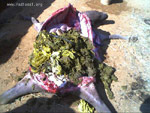
I do hope this new trend would spread like wild fire, because the plastic bag menace is assuming alarming proportions. You do not have to take my word for it. Just take a walk to the Chitravathi river and you would see tons and tons of plastic bags getting dumped there. Frankly, I do not have the heart to see this terrible sight any more. I mean this is the same river bed that was once the scene of extra-ordinary Divine Leelas of which you have had a glimpse in this issue. Is this to be the fate of the Divine Playground? Is this the way we should show respect to One whom we do not miss an opportunity to hail as the Lord?
You know what Jesus once said? He said, “Why call ye Me Lord, Lord, when thou does not follow what I say?” Our Lord says, revere the Earth. Is this the way to show reverence to Mother Earth? May be I should end with a Chinese proverb that says: If man ill-treats the Earth, the Earth in turn would punish him!”
Medical Camps in Khar and Juhu - Mumbai
Sai Ram All,
The Medical Camps at Khar agripada on saturday and at slums opp the
Sea Princess Hotel at Juhu on sunday were well attended by patients,
doctors as well as devotees and youth members.
On Saturday at Agripada 401 patients were treated and 150 were injected
with TT Injections. This camp was visited by Dr Aggarwal from
Prasanthi Nilayam and was volunteered by Bandra youth.
The sunday camp again was highight where more than 850 people were
treated and about 200 injected with TT injections.
Devotees from Andheri samithi did a great job along with the Bandra
youth.
In all the camps Dr Janki led the team from the front and now with her
guidance a make shift nursing home with 18 bedswill be operative at
Kadamwadi Centre'
The make shift nursing home with 18 Beds will be operative from
Wednesday the 17th August.
The Address is as follows:
Bandra Hindu Association Community Centre,
Opposite Namaskar Society,
Kadamwadi Road,
Behind Vakola Masjid,
Kadamwadi, Vakola Santacruz East.
Brother Ajay Nair and Sister Jagruti will be cordinating for all the
duties and schedules with the Youth wing members.
As discussed we will be having 3 shifts
1st Shift 6.00 am to 2.00 pm
2nd Shift 2.00 pm to 9.00 pm
3rd Shift 9.00 pm to 6.00 am Only for brothers
Sai Ram
Sai Shakthi Speaks and Smiles Once Again!
We present to readers an amazing story of Sai Shakti, an eleven year old boy from Orissa. He had been progressively unable to open his mouth to eat or speak since the age of three. By Bhagavan’s grace he had a successful operation at the Super Speciality Hospital in Puttaparthy on 8th September 2005. His faith in Bhagavan brought about the cure, which could not be accomplished even in a teaching hospital in Delhi.

All through the years the poor boy managed to push in with his finger mashed-up food through the sides of his mouth, between the teeth and the cheek, until the food went past the small gap behind the last tooth. Although he attended school like any other child of his age he was handicapped by his inability to speak. He was affected by ankylosis (fusion of joint due to bone formation) of the Temporo-Mandibular joint (T-M joint), the hinge where the two jaw bones meet.
Initially the family sought help from a teaching hospital in Orissa. After three months of hospitalisation and procrastination, the doctors agreed to perform the operation that was needed to have his mouth opened. They wanted the family agree to an elective tracheotomy (making a surgical opening in the throat for placement of a breathing tube into the trachea or windpipe) for a safe anaesthetic, but the family refused consent and took the boy home.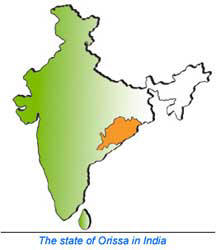
The boy’s father, who happened to be working in Delhi, brought Sai Shakti to see some specialists at an established teaching hospital. They too maintained that the boy should have a tracheotomy for a safe anaesthetic, which was an accepted practice for a case like this. Once again the family backed off allowing the boy’s misery to continue.
Sai Shakti along with his family and relatives attend Sai bhajans locally. Some devotees at the bhajan, who had served as sevadals at the Super Speciality hospital, suggested that they could try Swami’s hospital in Puttaparthi, knowing that the hospital provides facilities for Plastic surgery, in addition to Cardiac, Urology and Ophthalmology. With faith in Swami, Sai Shakti came to Puttaparthy immediately with his uncle and consulted the plastic surgeon. They were told that the operation was not a problem, but the anaesthetist must be willing to administer the anaesthetic without the tracheotomy. With some reassurance the boy was referred to the anaesthetist for an assessment.
The senior anaesthetist reassured the patient and family that no tracheotomy would be done. Preliminary investigations including X-rays and CT scans were done, which gave a good image of the deflections and diameter of the air passages from the nostrils to the trachea. While the anaesthetist was happy to proceed with the anaesthetic without the tracheotomy, the patient was alerted to the fact that, in the unlikely event of a failed nasal intubation, the operation would have to be abandoned.
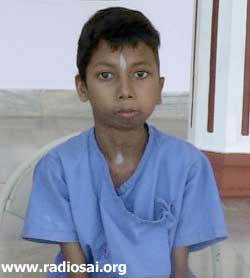 The Super Speciality hospital is well equipped, even with fibro-optic intubating bronchoscope that is quite costly and not generally available in most government hospitals, and teaching hospitals in India , let alone charity hospitals. Bhagavan has spared nothing to make such facilities available for the poor, not to mention even the expertise of talented doctors.
The Super Speciality hospital is well equipped, even with fibro-optic intubating bronchoscope that is quite costly and not generally available in most government hospitals, and teaching hospitals in India , let alone charity hospitals. Bhagavan has spared nothing to make such facilities available for the poor, not to mention even the expertise of talented doctors.
The operative procedure is a kind of surgical remodelling of the T-M joint with a prosthesis (arthroplasty) to get his jaws opened. The plastic surgeon in Swami’s hospital is very experienced and had done this procedure several times in his long career. The anaesthetist too has wide experience and is familiar with procedures such as this. All staff involved in this case looked forward to a successful outcome, with Swami’s grace.
Prior to admission the boy had spent a week in Puttaparthy and attended darshan of Bhagavan in Sai Kulwant Hall. He had seen Bhagavan going in the midst of devotees in His special silver-metallic car. Sai Shakti was confident that Swami would help him. He got admitted to the ward and the night before the operation he had a dream. In his own words Sai Shakti described to the operating theatre staff his overnight dream:
The boy was very happy and cooperative in the operating theatre. The anaesthetist had no difficulty in passing the breathing tube (endotracheal tube) with the help of the flexible paediatric fibro-optic bronchoscope guiding him. Normally a blind nasal intubation without seeing the larynx is very difficult, although very occasionally it is still possible. On this occasion it was Bhagavan’s mercy that made everything synchronize to make it a success. The entire operation that lasted an hour and a half went off smoothly. At the end of the operation the mouth was kept open with a rubber wedge. The boy recovered from anaesthesia smoothly. As he woke up the first thing he saw was Swami’s picture on the wall and he said “Sai Ram! Sai Ram!!” Those were his first words. He felt no pain and needed no pain-killer. He was able to speak to the doctors and nurses in the recovery area of the operating suite. He could hardly hold back what he had experienced under anaesthesia. We narrate the same, once again, in Sai Shakti’s own words: | 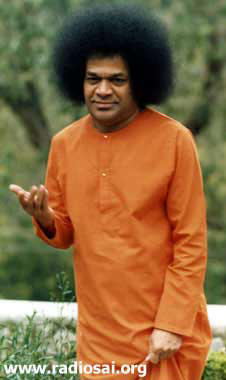 |
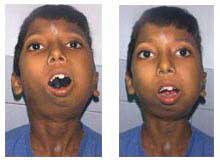 |
|
The remaining few days in hospital went uneventful. He started eating normally and kept narrating his wonderful experiences of Swami’s grace and the cure of his misery. He left the hospital full of gratitude to Bhagavan and praise for the kindness of doctors and nurses who showed such love and encouragement. Sai Shakthi as his name suggests truly got his ‘Shakthi’ i.e., power from Sai. He was energised by Sai.
Selfless Seva
Time was when the name Sri Sathya Sai Baba conjured up the image of a slight orange-clad figure with an Afro hairdo who performed miracles. Today most Indians view him as a spiritual leader who inspires harmony between people of all faiths; as an ideal educationist who runs totally free educational institutions; as a social worker par excellence who has brought drinking water to the poorest of the poor in Andhra and Karnataka and even to the metropolis of Chennai; as a healthcare provider who has set up globally acclaimed hospitals where everything is free; and as one whose devotees have a passion for “selfless seva”. However, what is amazing is the stupendous global impact he has had, though he has never stepped out of India except once in 1968 when he visited Africa. Broadly, the global activities carried out in the name of Sri Sathya Sai Baba can be divided into Educare, Medicare and Sociocare.
EDUCARE: Education enables one make a living; while educare enables one attain the highest in life. Educare helps one realise that one is not separate, but part of creation, which is in turn part of the Creator; and what is more, so is one’s neighbour. Baba’s educare programme which began in the sixties in India through the Bal Vikas project has now reached 180 countries. Three time Thai parliamentarian and ex-NASA scientist, Dr. ART-ong Jumsai, is a pioneer who has dedicated his life to educare; and thanks to Dr Jumsai and likeminded devotees, today there are Institutes of Sathya Sai Education (ISSE) in all continents. The Institutes train teachers in Educare and carry out research on the impact of Sathya Sai Education in the world. There are 52 Sathya Sai schools globally.
MEDICARE: Sai Centres abroad have been running many free clinics and medical camps for over two decades. A coordinated medicare programme has been launched recently under the auspices of the Sai International Medical Committee to reach Sai Ideal Health Care everywhere. The activities include Ongoing Healthcare Delivery, Disaster Relief, Medical Camps and Health Care Services, Disease Prevention and Health Education. In the Far East, Africa, Latin America and South Asia, in partnership with private hospitals, which offer free theatre and ward services, regular medical and surgical services have been available for the needy. An ideal hospice for the terminally ill is functioning in Sri Lanka.
In a major step forward, Sai Organisations are also tying up with governments in the implementation of National Health Programmes; for example, in Kenya the Sai Organisation distributes insecticide-treated mosquito nets to populations at risk of malaria no matter how remote and inaccessible the terrain; and this unique Sai Net programme has generated global interest. In the USA and other developed nations, Sai Medicare targets those who are not insured and have no access to healthcare. In appreciation, the Mayor of St Louis, proclaimed the 11th of September as ‘Sri Sathya Sai Baba Day’, last year.
SOCIOCARE: Sociocare programmes done by Sai Organisations in various nations are just too many to enumerate. However the water management project being implemented by the African Institute of Sathya Sai Education (TAISSE) merits mention. The Experts Group Meeting of water experts convened in 2001 by the UN-Habitat, the United Nations Environment Programme (UNEP) and the Sweden International Water Institute at Johannesburg was taken up by the Human Values approach to water management suggested by Victor Kanu of TAISSE. In fact, TAISSE was contracted by UN-Habitat to implement Value Based Water Education in six African countries. Water education is a combination of water literacy — knowledge about water sources, and, Value Based Perception — where water is viewed as a precious resource to be used responsibly for the the greater common good. Waterbodies are viewed as gifts given in trust to us to be safeguarded and passed down to future generations who are to inherit the earth after our time.
By 2004, the project was completed so successfully that UN-Habitat has now requested TAISSE to implement a Value Based Water, Sanitation and Hygiene Education in 12 African countries. Taking a leaf out of Baba’s Anantapur Water Project, devotees at Ndola, Zambia, have also started a small water project. Thanks to it, five poor townships and water-starved for centuries, have potable water today.
Latin America is another region where powerful Sai sociocare projects are on. The Director of a prison at Sensuntepeque, El Salvador, was so touched by the Sai Study Circle meetings in the prison, that he volunteered to do the Sathya Sai Human Values Diploma Course. In Beunos Aires, an ideal home for street children exists with a typical Sai twist to the tale. They used to live in a makeshift cramped place. While gardening one day, the kids found 12 kilos of pure gold in a flowerpot. Their street instincts told them to go for the gold and run away; but after all the EHV they had been taught, they simply could not. They notified the elders who notified the police and finally the courts declared that the gold belonged to the boys. With that money, a lovely home was built.
What is absolutely amazing is this: most volunteers participating in the Sai educare, medicare or sociocare projects abroad have not even seen Baba; but they are all full of love for this gentle eighty-year-old who lives in India, whom they refer to as the Avatar of the age. What is more, they are able to sense and feel his love for them across oceans and continents; and they are transmuted as it were. Of all the wondrous things Sri Sathya Sai Baba has created over the years, this transformation of hearts the world over remains his greatest miracle.
Serve Man Until... You See God In All Men
Bjørn is a social worker at the Red Cross. He qualified with an M.A. in Psychology and Communication Studies. A member of the Sai Youth Group, he was involved in the Centre’s Project for Homeless People and also visits homes for the elderly and disabled. His wife Henriette Emilie is an artist and has portrayed Baba in her paintings.
I first heard about Sri Sathya Sai Baba in 1986, when I was 14 years of age. I come from a Christian background, and it was a few months after my confirmation. My Godmother had recently been to Prasanthi Nilayam, and when she returned to Denmark she showed us pictures from the Ashram. A specific photo made a particular impression on me. It portrayed the big statue in front of Swami’s temple, with the lotus flower and the five world religions, unifying spirituality and science. “Baba’s message,” she told us, “is that all religions are aspects of the same Truth, the same God, although they may call Him by different names.” At this moment I experienced contact with a voice deep within me saying, “Yes, this is the Truth, this is what I have always felt myself.” The words were accompanied by a sense of peace.
A few years later, my mother went to Prasanthi Nilayam and brought back vibuthi, literature on Baba and pictures of Him – as well as many beautiful experiences, which she captured in the paintings “Darshan” and “Morning Prayer”.
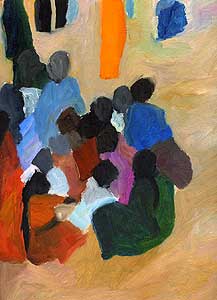 | 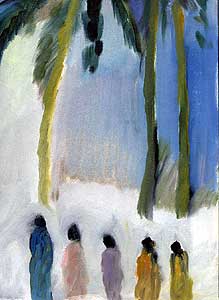 | |
‘Darshan’ | ‘Morning Prayer‘ |
In the family we often spoke about Baba, His teachings and other spiritual issues. I had the life of an average Danish young man, went to college, engaged in sports activities and spent time with my friends and family, but the longing for a more spiritual life increased over the years. I prayed to the omnipresent God without name and form to show me the spiritual guide that I was destined to follow. The following night Baba appeared to me in a dream and spoke to me in English, giving me advice about several aspects of my life. These dreams have been part of my inner life and contact with Him since then.
In 1994, I was in Prasanthi Nilayam with a group of Danish Sai devotees for Christmas. I did not travel to India to find out who Baba was. For some unknown reason it already seemed clear to me that He was the reincarnation of Lord Krishna, the Creator of this Universe. Nor did I come for healing, to be convinced about Baba’s ability to materialise, or to test His Divine powers. I went there because I had a deep longing to see Him and feel His presence.
Eyes of Endless Depth
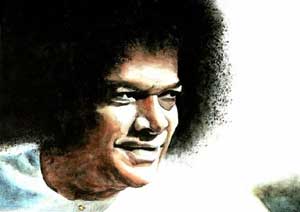 | |
Those Eyes…that encompassed eternity |
One day during Darshan, He was standing right in front of me. He did not speak to me, but He looked into my eyes and smiled. His face was so beautiful. An old saying states, “The eyes are the mirror of the soul” and I often felt that when I looked into the eyes of a person I would see a reflection of their soul’s uniqueness.
But with Swami, there seemed to be no individual soul. No beginning. No end. Looking into His eyes was a view into Eternity, into the Absolute Infinite Beingness – God. I was plunged into the unfathomable, overwhelmed and deeply touched. He left me awestruck, with tears in my eyes.
A few days later, on Christmas day, an Indian Sai devotee shared with me the following quote by Baba:
“No matter where you go, always know that I will be there, inside you, guiding you every step of the way. In the years to come, you will experience Me in My different manifestations of My form. You are My very own, dearer than dear to Me. I will protect you like the eyelids that protect the eyes.”
Little did I know at that time, how significant these words would be to me in the years to come!
Aspirations of the Heart
When I returned to Denmark my life changed completely. If ever I were to be worthy of looking into His eyes again I would have to put His teachings into practice. What had He told me? That I should see Him in His different manifestations of His form, and that only through love and service to mankind could I serve God and attain God’s grace. On a spring day in 1995 the following poem flowed easily into my mind.
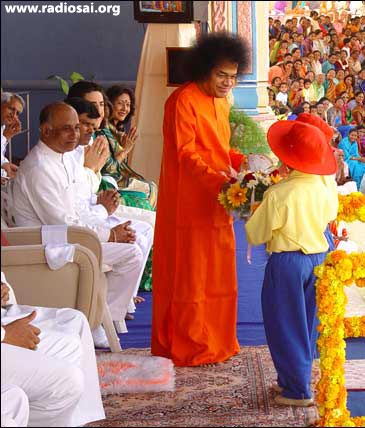 | Beloved One, Beloved One, Let me be your sacred son. I am Yours and You are mine We are all in Love Divine. Take my life and make me You; Lead me on the journey through Oh, My Lord I pray to Thee, We are One; |
Vision of Sai
I titled it Beloved One and the words defined the way I strived to live my life. Yet, words alone are not sufficient; they must be followed by practice. So I volunteered to become a visiting friend at the nearest old people’s home. Several days a week I would go and spend time with the elders, talk to them, listen to their life stories and learn about the difficulties they are grappling with in the last days of their lives.
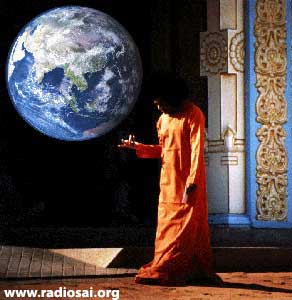 | |
“I am everywhere, at all times…” |
I realised, that when they viewed their lives in retrospect, the most valuable experience had been the love of their families. These moments of service were indeed rewarding for me. However, I often longed for India, for Swami and for the nearness of my Father, the Poorna Avathar.
It was on one such day, when I was on my way to visit an elderly man at the old people’s home that I was longing for India and Swami. When I entered the room where the old man lived, I saw him lying on his bed. And as I went near and we started speaking, my thoughts went back to India and for a few seconds I didn’t focus on the person in front of me, whom I had promised to serve.
When I looked up again it was no longer the old man lying on the bed. It was Sri Sathya Sai Baba, in His orange robe, with a crown of black hair! Not like a vision or a dream, but in His physical form. I was so awestruck that I almost fell on my knees. But the moment I moved, the scene changed. Again it was the old man lying in front of me.
“Serve man until you see God in all men,” Baba tells us. I spent the rest of the day with my friend, reflecting upon Baba’s words. As humble as I would be towards Swami, I should be to this man. As respectful as I would be to Swami, I should be towards this man. All the love I would have for Swami, I should have for this man. “In the years to come, you will see Me in My different manifestations of My form.” Baba had indeed kept His promise. For five years I served several different people at the old people’s home and I spent almost every evening there. I didn’t see Swami in His familiar divine form again, but I learned to see and experience His omnipresence and His Love in His multiplicity of forms.
The Ocean of Compassion
Swami often says that man is a limb of society; society is a limb of mankind; mankind is a limb of Nature; and Nature is a limb of God. This is the hierarchical and organic relationship between man and God. If man forgets this, he can and does get into all kinds of problems, as in fact is presently happening.
Man today has completely forgotten that Nature does not stand alone, and that it is the Creation of God. Out of compassion, God has packed Nature with innumerable bounties, all for man to use and enjoy. However, the use of these gifts must be within reasonable bounds, going hand in hand with the expression of gratitude to God. But alas, the use [or rather the exploitation] of these bounties has become shockingly reckless, and there is no gratitude either. Under such circumstances, Nature does not remain a silent spectator. Incredibly patient she is but when aroused, her fury is unmatched. Using the law of reflection, reaction, resound, she punishes man via murderous tornadoes, terrifying typhoons, grim famines, deadly epidemics, harsh droughts, disastrous floods, fearsome avalanches, massive landslides, fiery volcanic eruptions, devastating earthquakes, and what not.
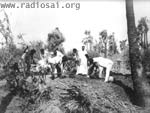 Meanwhile, what should one do when disaster strikes? There are some that say, “It is all God’s will. Those who suffer are destined to do so. Let us leave them alone.” This is an incredibly ridiculous argument. If it were taken seriously, there would be no room for any doctors! Baba makes it very clear that we have no business to sit in judgement on others. Rather, we must rush to help – that is what the famous parable of the Good Samaritan is all about. And just so that we do not forget, Swami repeats that lesson by His own personal example any number of times. His compassionate response at the time of the Andhra cyclone in 1977, and the Gujarath earthquake in 2001 are two just two such instances.
Meanwhile, what should one do when disaster strikes? There are some that say, “It is all God’s will. Those who suffer are destined to do so. Let us leave them alone.” This is an incredibly ridiculous argument. If it were taken seriously, there would be no room for any doctors! Baba makes it very clear that we have no business to sit in judgement on others. Rather, we must rush to help – that is what the famous parable of the Good Samaritan is all about. And just so that we do not forget, Swami repeats that lesson by His own personal example any number of times. His compassionate response at the time of the Andhra cyclone in 1977, and the Gujarath earthquake in 2001 are two just two such instances.
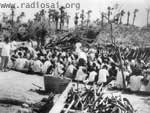 A terror-striking cyclone had hit the Andhra coast in 1977. The cyclone brought in its wake, a twenty-foot tidal wave [i.e., about seven metres high], that spread itself over a large part of the coast and penetrated about thirty miles [about fifty kilometres] inland, before spending its fury. The devastation inflicted by the combined force of wind and water was enormous. Tens of thousands died, cattle perished in large numbers, scores of villages were wiped out, and an enormous number of coconut trees were uprooted. The survivors were confronted by disease, despair, and decimation. Bhagavan directed the Seva Dal from Andhra to rush to the area. Truckload of clothes, rugs, and whatever could be gathered were speedily despatched ??.
A terror-striking cyclone had hit the Andhra coast in 1977. The cyclone brought in its wake, a twenty-foot tidal wave [i.e., about seven metres high], that spread itself over a large part of the coast and penetrated about thirty miles [about fifty kilometres] inland, before spending its fury. The devastation inflicted by the combined force of wind and water was enormous. Tens of thousands died, cattle perished in large numbers, scores of villages were wiped out, and an enormous number of coconut trees were uprooted. The survivors were confronted by disease, despair, and decimation. Bhagavan directed the Seva Dal from Andhra to rush to the area. Truckload of clothes, rugs, and whatever could be gathered were speedily despatched ??. 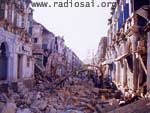 Four relief camps were set up. Massive provisions and materials being carried by devotees as headloads. They had to wade through slush and mire, through thick clouds of stench from rotting corpses and carcass. Indeed the first task was to bury or burn these, which they found in heaps on the ground and even on trees and bushes. Kitchens worked round the clock in four strategic centres for over a month. Food was sent from there to several places, including remote ones ?.. Besides this, the Seva Dal helped to build huts. They also gave away, utensils, clothes, and rugs, as a part of the rehabilitation. When the Seva activities finally came to a close, the volunteers were happy that the faces of the masses around them were bright with gratitude and devotion for Bhagavan.
Four relief camps were set up. Massive provisions and materials being carried by devotees as headloads. They had to wade through slush and mire, through thick clouds of stench from rotting corpses and carcass. Indeed the first task was to bury or burn these, which they found in heaps on the ground and even on trees and bushes. Kitchens worked round the clock in four strategic centres for over a month. Food was sent from there to several places, including remote ones ?.. Besides this, the Seva Dal helped to build huts. They also gave away, utensils, clothes, and rugs, as a part of the rehabilitation. When the Seva activities finally came to a close, the volunteers were happy that the faces of the masses around them were bright with gratitude and devotion for Bhagavan.
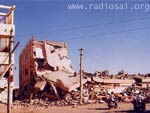 It was 8.45 A.M. on 26th January, 2001, a day celebrated in India as Republic Day. In Delhi the Nation’s Capital, an impressive parade is held in the morning at which the President takes the salute. Around the same time, parades and flag-hoisting ceremonies are held all over India, particularly in schools. In Gujarat, many children were marching to their schools at that hour. And then the earth shook fearsomely, like never before. Buildings crumbled and in a few quick seconds, thousands were trapped under the debris, including school children on their way to parades. Entire villages were wiped out just like that, in barely a few minutes. Death did not make any distinctions – the young, the old, the rich, and the poor, all became equal before it.
It was 8.45 A.M. on 26th January, 2001, a day celebrated in India as Republic Day. In Delhi the Nation’s Capital, an impressive parade is held in the morning at which the President takes the salute. Around the same time, parades and flag-hoisting ceremonies are held all over India, particularly in schools. In Gujarat, many children were marching to their schools at that hour. And then the earth shook fearsomely, like never before. Buildings crumbled and in a few quick seconds, thousands were trapped under the debris, including school children on their way to parades. Entire villages were wiped out just like that, in barely a few minutes. Death did not make any distinctions – the young, the old, the rich, and the poor, all became equal before it.
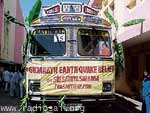 As news trickled in from the disaster area, gloom descended over the Nation. The cry of anguish reached even far off lands, and help poured in. Baba was in Bangalore then, spending some time there after the inauguration of the big Hospital. People rushed to Him to give the news about the disaster. Quietly He listened. He of course knew much before anyone else when the disaster actually struck and also why; but He did not give any inkling of what He knew. Silently and most unobtrusively, He organised help and relief in typical Sai fashion, as soon as He returned to Prasanthi Nilayam. Trucks were lined up, loaded with food and other relief items, and given a loving send off with devotees singing Bhajans and Swami personally blessing the convoy. While Seva Dal volunteers from Gujarat and the neighbouring state of Maharashtra were already on duty at the distress spot, Baba added a sweet touch by specially sending some of the people from Prasanthi Nilayam, to go all the way to Gujarat, stay there for as many days as were required, and supervise the distribution. In many ways, this was reminiscent of His sending Mr. Kasturi to supervise Seva during the Andhra cyclone of the seventies.
As news trickled in from the disaster area, gloom descended over the Nation. The cry of anguish reached even far off lands, and help poured in. Baba was in Bangalore then, spending some time there after the inauguration of the big Hospital. People rushed to Him to give the news about the disaster. Quietly He listened. He of course knew much before anyone else when the disaster actually struck and also why; but He did not give any inkling of what He knew. Silently and most unobtrusively, He organised help and relief in typical Sai fashion, as soon as He returned to Prasanthi Nilayam. Trucks were lined up, loaded with food and other relief items, and given a loving send off with devotees singing Bhajans and Swami personally blessing the convoy. While Seva Dal volunteers from Gujarat and the neighbouring state of Maharashtra were already on duty at the distress spot, Baba added a sweet touch by specially sending some of the people from Prasanthi Nilayam, to go all the way to Gujarat, stay there for as many days as were required, and supervise the distribution. In many ways, this was reminiscent of His sending Mr. Kasturi to supervise Seva during the Andhra cyclone of the seventies.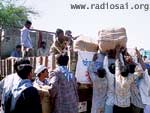
For most volunteer organisations, service ended after the items had been distributed. With Swami it was quite different. He had given instructions that these villages [which had been reduced to ghost-towns] have to be rebuilt by Sai effort – that is the most wonderful and unusual part of the Seva rendered in Gujarat. In other words, with Sai it is not just relief but also rehabilitation. That is real concern and that is real compassion. Long after other volunteers have returned their respective bases, Sai volunteers are still in Gujarat, helping to restore normalcy.
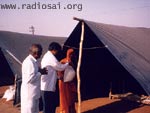 The Gujarat earthquake taught many lessons. The first was a reminder that Nature is not to be treated lightly. In fact, in His Discourse on the occasion of Sivarathri that followed the quake, Baba reminded devotees of this fact. Next, by His action, Swami also firmly refuted the flimsy excuse sometimes given for inaction, namely that people who suffer are destined to do so. He made it abundantly clear that we not here to analyse the Law of Karma but to render service, irrespective of the antecedents of the recipients of the service – that is what true Love and compassion are all about.
The Gujarat earthquake taught many lessons. The first was a reminder that Nature is not to be treated lightly. In fact, in His Discourse on the occasion of Sivarathri that followed the quake, Baba reminded devotees of this fact. Next, by His action, Swami also firmly refuted the flimsy excuse sometimes given for inaction, namely that people who suffer are destined to do so. He made it abundantly clear that we not here to analyse the Law of Karma but to render service, irrespective of the antecedents of the recipients of the service – that is what true Love and compassion are all about.


